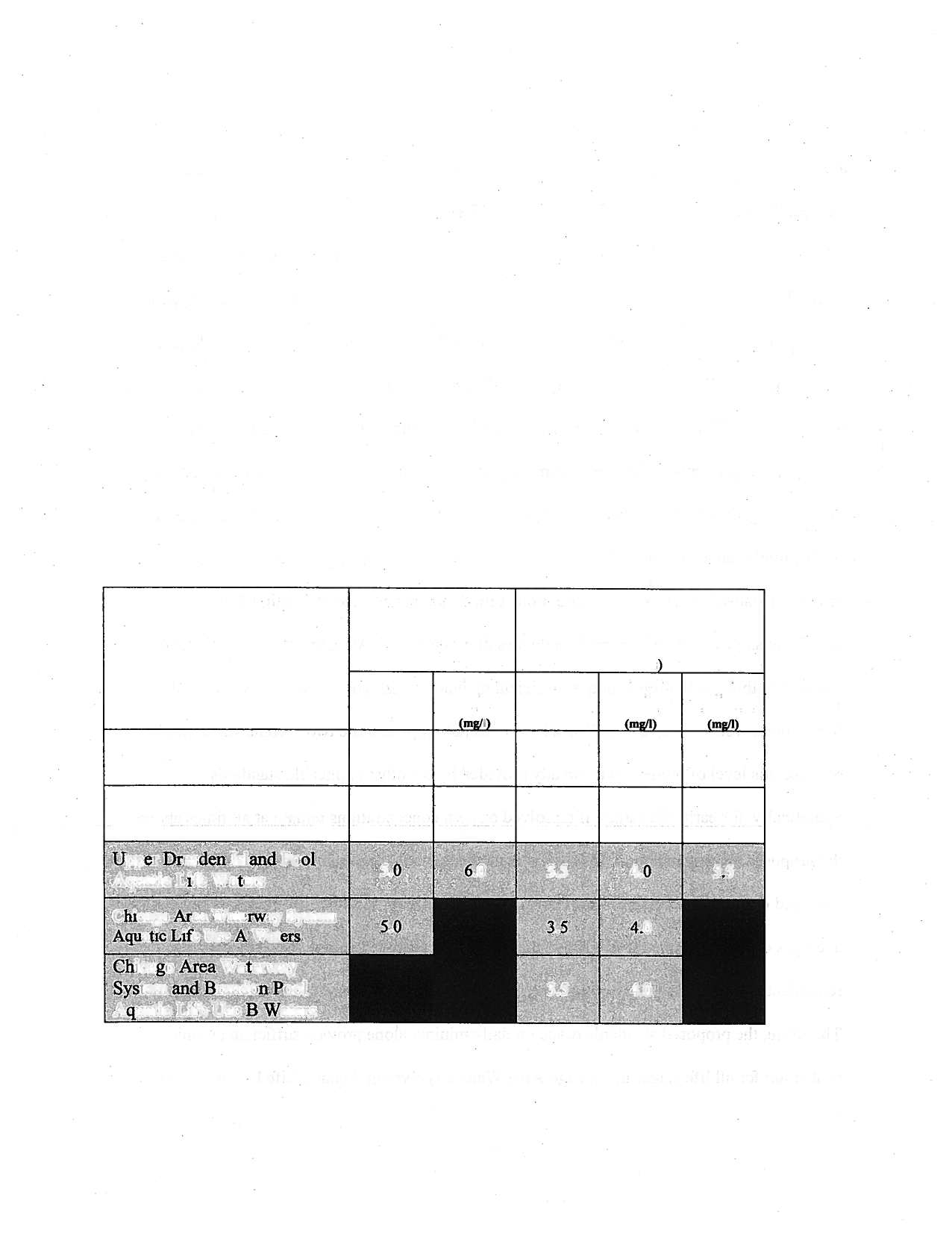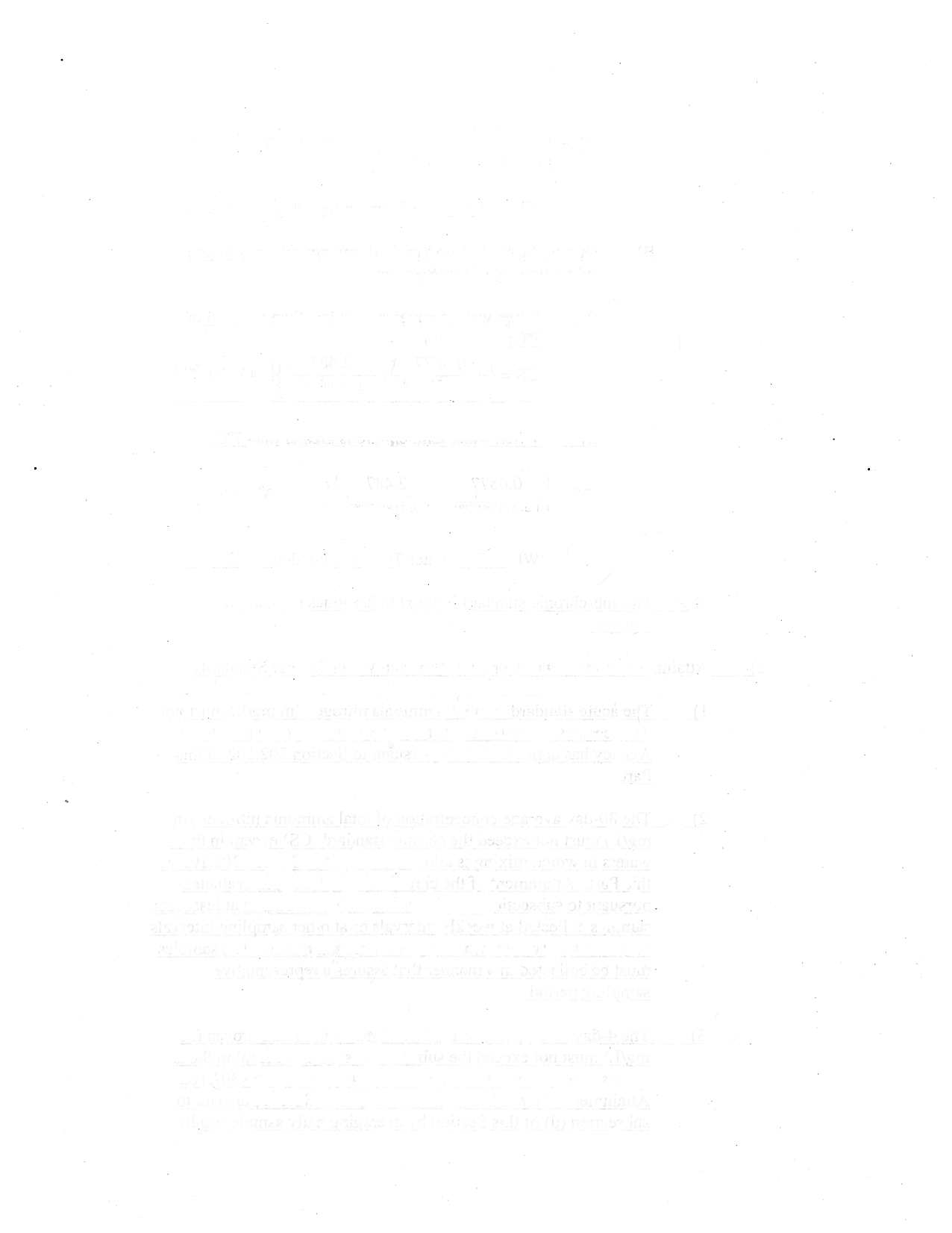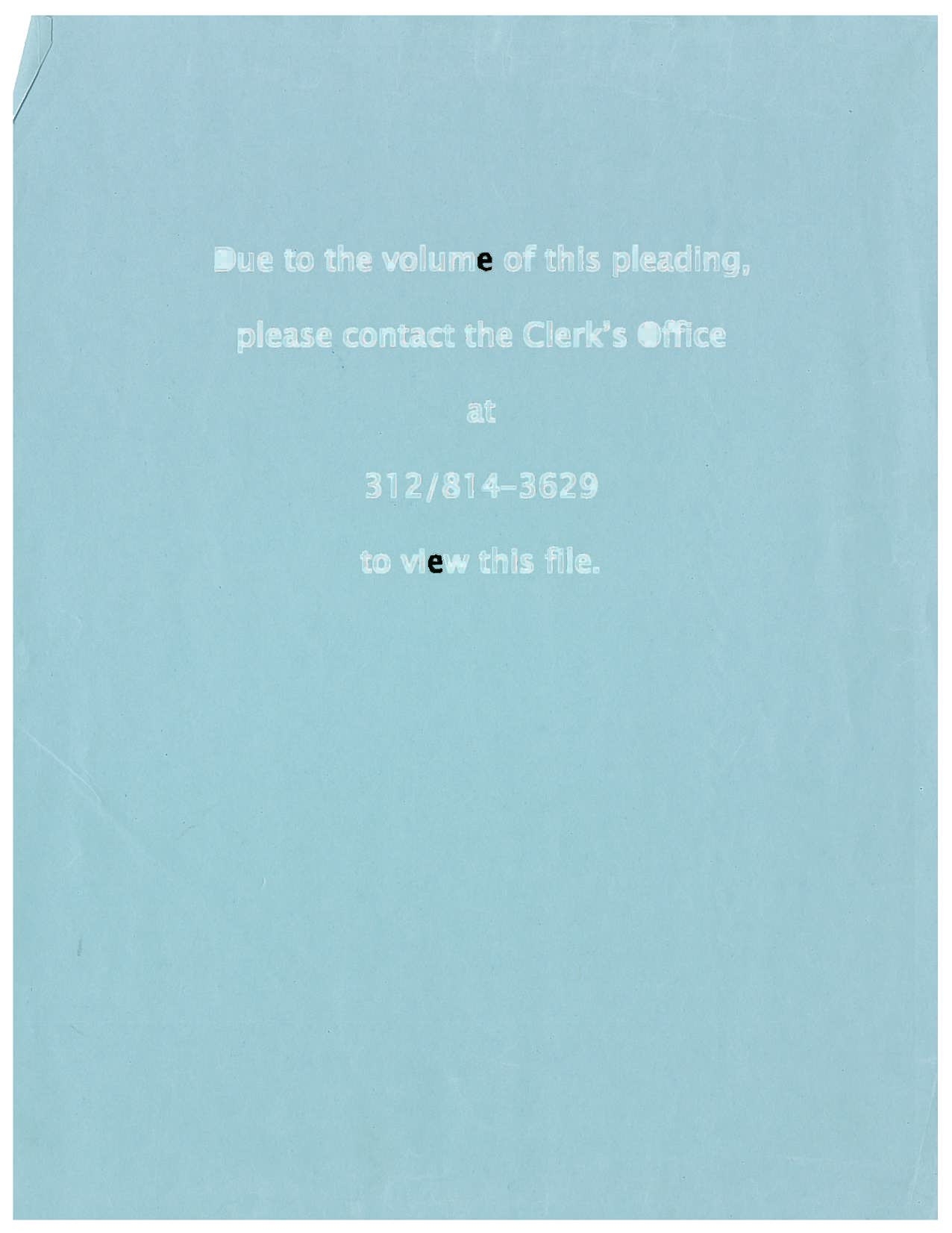| | - BEFORE THE ILLINOIS POLLUTION CONTROL BOARD
- BEFORE THE ILLINOIS POLLUTION CONTROL BOARD
- STATE OF lLLlNOlS Pollution Control Board
- BEFORE THE ILLINOIS POLLUTION CONTROL BOARP)
- @c@l~~~
- BEFORE THE ILLINOIS POLLUTION CONTROL BOARD
- BEFORE THE ILLINOIS POLLUTION CONTROL BOARD
- ~@~dX'O
- BEFORE THE ILLINOIS POLLUTION
- CONTROL
- BEFORE THE ILLINOIS POLLUTION CONTROL BOARD
- BEFORE THE ILLINOIS POLLUTION CONTROL BOARD
- STATEMENT OF REASONS
- I. STATUTORY BASIS AND LEGAL FRAMEWORK
- A. Environmental Protection Act
- B. Clean Water Act
- Federal Re~ulations Applicable to Water Oualitv Standards Proposals
- Use Attainabilitv Analyses
- D. Applicable Board Regulations and Re~ulatorv Historv
- 11. REGULATORY PROPOSAL: PURPOSE AND EFFECT
- Svstem and Lower Des Plaines River
- 1. Development of Lower Des Plaines River
- 2. Development of the Chicago Area Waterway System
- D. Pilot Use Attainabilitv Analysis for the Lower Des Plaines River
- E. Use Attainabilitv Analvsis for the Chicago Area Waterwav Svstem
- F. Combined Use Desi~nation and Water Qualitv Standards Proposal
- A. Part 301 Definitions
- 2. Section 301.282 Incidental Contact Recreation
- 3. Section 301.307 Lower Des Plaines River
- 4. Section 301.323 Non-contact Recreation
- 5. Section 301.324 Non-recreational
- 2. Section 303.102 ~ulemaki'ng Required (Repealed)
- 4. New Definitions and Designations for Human-Contact Recreational
- Activities: Incidental Contact, Non-Contact and Non-Recreational Uses
- Plaines River
- 303.220 Incidental Contact Recreation Waters
- 303.227 Non-Recreational Waters
- 7. Aquatic Life Use Designations
- 303.230 Chicapo Area Waterway Svstem Aquatic Life Use A Waters
- 303.237 Upper Dresden Island Pool Aquatic Life Use Waters
- 10. Section 303.441 Secondary Contact Waters Repealed
- C. Part 302, Subpart A.
- 1 Applicability
- Section 302.101 Scope and Applicability
- Section 302.102 Allowed Mixing, Mixing Zones and ZIDs
- 1. Subpart D Scope and Applicability
- Section 302.401 Scope and Applicability
- 2. Subpart D Purpose
- Section 302.402 Purpose
- 3. Narrative Offensive Conditions Criteria
- Section 302.403 Unnatural Sludge
- 4. Section 302.404 pH
- 5. Dissolved Oxygen
- Section 302.405 Dissolved Oxygen
- Designated Waters
- 6.25
- Section 302.407 Chemical Constituents
- 7. Standards to Protect Aquatic Life: Arsenic, Cadmium, Chromium,
- GMAV
- SMAV
- 9. Other Standards: Chloride, Iron, Silver, Selenium, Sulfate
- 11. Temperature
- Section 302.408 Temperature
- 12. Cyanide deleted from stand-alone section and moved to chemical tables
- Section 302.409 Cyanide (Re~eaied)
- Cyanide (total) shall not exceed 0.10 mg/l
- 13. Section 302.410 Substances Toxic to Aquatic life
- 14. Ammonia
- SUBPART B: SITE SPECIFIC RULES AND EXCEPTIONS NOT OF GENERAL
- APPLICABILITY
- A. Lower Des Plaines UAA Study Findings and Recommendations
- B. CAWS UAA Studv Findings and Recommendations
- C. Midwest Biodiversitv Institute and Center for Applied Bioassessment and
- Biocriteria Recommendations
- D. Other Facts in Support
- V.. TECHNICAL FEASIBILITY AND ECONOMIC JUSTIFICATION
- A. Introduction
- B. Technical Feasibilitv
- VI. AFFECTED FACILITIES AM) OUTREACH
- A. Affected Facilities
- 1. Municipal Facilities
- 2. Industrial Dischargers
- 1. Lower Des Plaines Pilot stakeholder workgroup
- Lower Des Plaines UAA Biological Subcommittee
- 3. CAWS 'Stakeholders Advisory Committee (SAC)
- 4. CAWS Public Meetings and Other Outreach Meetings and Events
- Joliet and Chicago on Rulemaking ~roposal
- 6. Additional Outreach
- MI. SYNOPSIS OF TESTIMONY
- A. Toby Frevert. Manaver, Division of Water Pollution Control. Bureau of
- Water, Illinois EPA
- B. ~ob Sulski, Public Service Administrator, Division of Water Pollution
- Control, Bureau. of Water
- C. Scott Twait, Environmental Protection En~ineer 111, Water Oualitv
- D. Chris Yoder, Midwest Biodiversity Institute
- A. Statement Repardine Com~liance with 5 ILCS 10015-40(3.5)
- B. List of Attachments
- C. List of Documents Relied Upon But Not Attached
- Pending Board Rulemakina Dockets
- Section 301.247 Chicago Area Waterway System
- Section 301.282 Incidental Contact Recreation
- Section 301.323 Non-Contact Recreation
- Section 301.324 Non-Recreational
- SUBPART A: GENERAL WATER QUALITY PROVISIONS
- Section 302.101 Scope and Applicability
- Section 302.102 Allowed Mixing, Mixing Zones and ZIDs
- SUBPART D: CHICAGO AREA WATERWAY SYSTEM AND LOWER DES
- STANDARDS
- Section 302.401 Scope and Applicability
- Section 302.402 Purpose
- Section 302.404 pH
- Section 302.405 Dissolved Oxygen
- Section 302.407 Chemical Constituents
- Section 302.408 Tem~erature
- Section 302.409 Cyanide mepealed)
- Section 302.410 Substances Toxic to Aquatic Life
- Section 302.412 Total Ammonia Nitrogen
- SUBPART A: GENERAL PROVISIONS
- Section 303.102 Rulemaking Required Pe~ealed)
- SUBPART B: NONSPECIFIC WATER USE DESIGNATIONS
- Section 303.204 Chicago Area Waterwav Svstem and Lower Des Plaines River
- PWaters
- 303.220 Incidental Contact Recreation Waters
- 303.225 Non-Contact Recreation Waters
- 303.227 Non-Recreational Waters
- 303.230 Chicapo Area Waterway Svstem Aquatic Life Use A Waters
- 303.237 Upper Dresden Island Pool Aquatic Life Use Waters
- SUBPART C: SPECIFIC USE DESIGNATIONS AND SITE SPECIFIC WATER
- QUALITY STANDARDS
- Section 303.441 Secondary Contact Waters (Repealed)
- PART 304
- SUBPART B: SITE SPECIFIC RULES AND EXCEPTIONS NOT OF GENERAL
- APPLICABILITY
- STATE OF ILLXNOIS
- COUNTY OF SANGAMON
- PROOF OF SERVICE
|

BEFORE THE ILLINOIS POLLUTION CONTROL BOARD
IN THE MATTER OF:
WATER QUALITY STANDARDS
AND
EFFLUENT LIMITATIONS FOR THE
CHICAGO AREA WATERWAY SYSTEM
AND THE LOWER DES PLAINES
RIVER:
PROPOSED AMENDMENTS TO 35 Ill.
Adrn. Code Parts 301,302,303 and 304
NOTICE OF
FILING
John Therriault, Clerk
Illinois Pollution Control Board
James
R. Thompson Center
100 West Randolph Street, Suite 1 1-500
Chicago, Illinois 6060 1
Matthew Dunn, Chief
Environmental Bureau
Office of the Attorney General
100
W. Randolph, 12~~
Floor
Chicago, Illinois 60601
Bill Richardson, Chief Legal Counsel
Illinois Department of Natural Resources
One Natural Resources Way
Springfield, Illinois 62702- 127 1
PLEASE TAKE NOTICE that I have filed today with the Illinois Pollution Control Board the
Motion for Acceptance; Appearances; Motion for Waiver of Copy Requirements; Motion For
Hearings to be Conducted in Chicago and Joliet; Director's Statement of Submittal; Certificate of
Origination; Statement of Reasons and Attachments; and Proposed Amendments to 35 Ill. Adrn.
Code Parts 301, 302,303 and 304 by the Illinois Environmental Protection Agency, a copy of which
is herewith served upon you.
ILLINOIS ENVIRONMENTAL
Dated:
tad 2b 1
o7
1021 North rand Avenue ast
Assistant ~ouxel
P.O. Box 19276
Springfield, Illinois 62794-9276
(217) 782-5544
BEFORE THE ILLINOIS POLLUTION CONTROL BOARD
IN THE MATTER OF:
WATER QUALITY STANDARDS AND
EFFLUENT LIMITATIONS FOR THE
CHICAGO AREA WATERWAY SYSTEM
AND THE LOWER DES PLANS RIVER:
PROPOSED AMENDMENTS TO 35 Ill.
Adm. Code Parts 30 1,302,303 and 304
R08-
(Rulem
1
g
-
Water)
STATE OF lLLlNOlS
Pollution
Control
Board
MOTION FOR ACCEPTANCE
NOW COMES the Illinois Environmental Protection Agency ("Illinois EPA"), by and
through its attorneys, Stefanie
N. Diers and Deborah J. Williams, and pursuant to 35 Ill. Adm.
Code 102.106, 102.200, and 102.202, moves that the Illinois Pollution Control Board ("Board")
accept for hearing the Illinois EPA7s proposal for the adoption of amendments to 35
Ill.
Adrn.
Code Parts 301,302,303 and 304. This regulatory proposal includes:
Notice of Filing;
Appearances of Attorneys for the Illinois Environmental Protection Agency;
Motion for Waiver of Copy Requirements;
Motion to Conduct Hearings in Chicago and Joliet,
Director Scott's Statement of Submittal;
Certification of Origination;
Statement of Reasons (including list of attachments and documents relied on);
Attachments to the Statement of Reasons;
Proposed Amendments;
Proof of Service;
Computer disc containing Proposed Amendments.
Dated:
(O/a~/~q
102 1 North Grand Avenue East
P.O. Box 19276
Springfield, Illinois 62794-9276
(2 17) 782-5544
Respectfully Submitted,
ILLINOIS ENVIRONMENTAL
PROTECTION AGENCY
By:
Deborah
J. Williams
Assistant Counsel
Division
of Legal Counsel
BEFORE THE ILLINOIS POLLUTION CONTROL BOARP)
@c@l~~~
CLE~~'~
OFFICE
IN THE MATTER OF:
WATER QUALITY STANDARDS
AND
EFFLUENT LIMITATIONS FOR THE
CHICAGO AREA WATERWAY SYSTEM
AND THE LOWER DES PLAINES RIVER:
PROPOSED AMENDMENTS TO 35 Ill.
Adm. Code Parts 301,302,303 and 304
STATE OF
ILLINOIS
Pollution Control 8oard
R08-
(~ulemak&~
-
Water)
APPEARANCE
The undersigned, as one of its attorneys, hereby enters her appearance on behalf of the
Illinois Environmental Protection Agency.
ILLINOIS ENVIRONMENTAL
PROTECTIQN AGENCY
Dated:
1021 ~orth'
Grand
107
Avenue East
P.O. Box 19276
Springfield, Illinois 62794-9276
(217) 782-5544
BEFORE THE ILLINOIS POLLUTION CONTROL BOARD
IN THE MATTER OF:
WATER QUALITY STANDARDS AND
EFFLUENT
CHICAGO AREA
LMITATIONS
WATERWAY
FOR
SYSTEM
THE
0
(Rulemak'
7
g
-
Water)
AND THE LOWER DES PLAINES RIVER:
PROPOSED AMENDMENTS TO 35 Ill.
Adm. Code Parts 301,302,303 and 304
APPEARANCE
The undersigned, as one of its attorneys, hereby enters her appearance on behalf of the
Illinois Environmental Protection Agency.
ILLINOIS ENVIRONMENTAL
PROTECTION AGENCY
Assistant ~ounsx
Division of Legal Counsel
Dated:
I~~CL[O~
1021 North
and A enue East
P.O. Box 19276
Springfield, Illinois 62794-9276
(217) 782-5544
BEFORE THE ILLINOIS POLLUTION CONTROL BOARD
IN THE MATTER OF:
WATER QUALITY STANDARDS
AND
EFFLUENT LIMITATIONS FOR THE
CHICAGO AREA WATERWAY SYSTEM
AND
THE LOWER DES PLANES RIVER:
PROPOSED AMENDMENTS TO 35 ni.
Adm. Code Parts 301,302,303 and 304
-.
R08
2
OF
~~Ll~ol~
Po''~tlon
control Board
mulern ing
-
Water)
MOTION FOR WAIVER OF COPY REOUIREMENTS
NOW COMES the Proponent, the ILLINOIS ENVIRONMENTAL PROTECTION
AGENCY ("Illinois EPA"), by one of its attorneys, and pursuant to 35 Ill. Adm. Code 101.500,
102.110 and 102.402, moves that the Illinois Pollution Control Board ("Board") waive certain
requirements, namely that the Illinois EPA submit the original and nine copies of all documents
upon which it relied.
In support of its Motion, the Illinois EPA states
as
follows:
Section 102.200 of the Board's procedural rules requires that the original and nine copies
of each regulatory proposal be filed with the Clerk. 35 Ill. Adm. Code 102.200. This entire
regulatory proposal approaches 3,000 pages in length. Given the length of the proposal and the
resources required to provide nine copies, the Illinois EPA requests that the Board waive the
normal copy requirements of Section 102.200
and allow the Illinois EPA to instead file the
original and four complete copies of the proposal, plus five partial copies containing the
pleadings, Statement of Reasons and proposed amendments.
WHEREFORE, for the reasons set forth above, the Illinois EPA moves that the Board
waive the copy requirement and allow the Illinois EPA to provide the Board with an original and
four complete copies, along with five partial copies of the proposal
as described
supra.
Dated:
P.O. Box 19276
Springfield, Illinois 62794-9276
(217) 782-5544
Respectfully submitted,
ILLINOIS ENVIRONMENTAL
Deborah
J. Willias
Assistant Counsel
BEFORE THE ILLINOIS POLLUTION CONTROL
BOARD
~@~dX'O
IN THE MATTER OF:
WATER QUALITY STANDARDS
AND
EFFLUENT LlMITATIONS FOR THE
CHICAGO AREA WATERWAY SYSTEM
AND
THE LOWER DES PLAINES RIVER:
PROPOSED AMENDMENTS TO 35 Ill.
Adm. Code Parts 301,302,303 and 304
1
)
~~~ernaJmg
-
water)
MOTION TO CONDUCT HEARINGS
IN CHICAGO AND JOLIET
NOW COMES the Proponent, the ILLINOIS ENVIRONMENTAL
PROTECTION AGENCY ("Illinois EPA"), by one of its attorneys, and pursuant to 35
Ill. Adm. Code 101.500,101.502, 102.402, and 102.412, moves that the Illinois Pollution
Control Board ("Board") or the assigned Hearing Officer schedule the first required
rulemaking hearing in Chicago and the second required rulemaking hearing in Joliet.
In
support of its Motion, the Illinois EPA states
as
follows:
1.
Section 28 (a) of the Environmental Protection Act provides as follows:
"No substantive regulation shall be adopted, amended, or repealed until after a public
hearing
within the area of the State concerned. In the case of state-wide regulations
hearings shall be held in at least two areas."
In addition, Section 102.412 of the Board's
procedural rules states in part
". .
.In the case of site-specific rules, a public hearing will
be held in the affected county..
."
2.
The instant rulemhg proposal is clearly not a site-specific rulemaking
proposal as it is
a comprehensive water quality standards proposal impacting the entire
Chicago Area Waterway System and Lower Des Plaines River fiom the Wilrnette
Pumping Station and Controlling Works on the North Shore Channel at Lake Michigan in
Wilmette to the Interstate-55 Bridge crossing over the Lower Des Plaines River south of
Joliet. This area is located
in both Cook and Will counties.
3.
While the instant rulemaking proposal is technically a rule of general
applicability, in practice, it is primarily a proposal of regional applicability and concern.
Therefore, the Agency believes the interests of the public at large are best served by
conducting hearings in two areas of the State that are both located within the impacted
region and are located in the county seats of the impacted counties. Conducting
rulemaking hearings in downtown Chicago and Joliet will best accomplish these goals.
4.
In addition, the Agency moves that the Board schedule the initial hearing
dates in Chicago. Section 102.428(c) of the Board's procedural rules requires that
"Proponents must present testimony in support of the proposal first." At the initial
hearing, the Agency will be presenting testimony in support of this proposal and
responding to questions fiom the public. To ensure that the greatest number of
participants have access to this testimony in person and are able to ask their questions of
the Agency on the record, the Agency moves the Board to conduct the first hearing in
downtown Chicago.
WHEREFORE, for the reasons set forth above, the Illinois EPA moves that the
Board conduct the hearings in this proceeding in Chicago and Joliet with the first hearing
to be held in Chicago.
Respectfblly submitted,
ILLINOIS ENVIRONMENTAL
PR-CTION
AGENCY
By:
Deborah
J. #illiarns
Assistant Counsel
Dated:
20 /2CP/oq
1 02 1 North Grand Avenue East
P.O. Box
19276
Springfield, Illinois 62794-9276
(217) 782-5544
BEFORE THE ILLINOIS POLLUTION
IN
THE MATTER OF:
WATER QUALITY STANDARDS AND
EFFLUENT LIMITATIONS FOR THE
CHICAGO AREA WATERWAY SYSTEM
AND THE LOWER DES PLAINES RIVER:
PROPOSED AMENDMENTS TO 35 Ill.
Adm. Code Parts 301,302,303 and 304
CONTROL
R08Fj
(Rule aking
, -
Water)
DIRECTOR SCOTT'S STATEMENT OF SUBMITTAL
Pursuant to Section 27 of the Illinois Environmental Protection Act (415 ILCS 5/27), the
Illinois Environmental Protection Agency hereby moves the Illinois Pollution Control Board to
adopt the proposed amendments.
Respectllly Submitted,
ILLINOIS ENVIRONMENTAL
PROTECTION AGENCY
By:
Dated:
102
1
North
Au
~fand
r*rf
Avenue
& ,
East
P-.O. BOX-19276
- --
--
Springfield, Illinois 62794-9276
(2 17) 782-5544
BEFORE THE ILLINOIS POLLUTION CONTROL BOARD
IN THE MATTER OF:
WATER QUALITY STANDARDS
AND
EFFLUENT LIMITATIONS FOR THE
CHICAGO AREA WATERWAY SYSTEM
AND THE LOWER DES PLANES RIVER:
PROPOSED AMENDMENTS TO 35 Ill.
Adm. Code Parts 301,302,303 and 304
R08-
(Rulem
8
g
-
Water)
CERTIFICATION OF ORIGINATION
NOW COMES the Illinois Environmental Protection Agency to certify in accordance
with 35 Ill. Adm. Code. 102.202(i) that this proposal amends the most recent version
of the Parts
301, 302, 303 and 304 of the Pollution Control Board's regulations,
as published on the Board's
web site,
http://www.ipcb.state.il.us/SLRlPCBand1EPAEnvir0nnlentaRegu1ations-Tit1e35
.asp.
Respectfully Submitted,
ILLINOIS ENVIRONMENTAL
Assistant counsel
Division of Legal Counsel
Dated:
10 /2k/04
102 1 North Grand venue East
P.Q. Box 19276
Springfield, Illinois 62794-9276
(217) 782-5544
IN THE MATTER OF:
WATER QUALITY STANDARDS
AND
EFFLUENT LIMITATIONS FOR THE
CHICAGO AREA WATERWAY SYSTEM
AND THE LOWER DES PLAINES RIVER:
PROPOSED AMENDMENTS TO 35 Ill.
Adrn. Code Parts 301,302,303 and 304
BEFORE THE ILLINOIS POLLUTION CONTROL BOARD
(~ulemal(m~
-
Water)
STATEMENT OF REASONS
The Illinois Environmental Protection Agency ("Illinois EPA" or "Agency") hereby
submits its Statement of Reasons for the above captioned rulemaking to the Illinois Pollution
Control Board ("Board") pursuant to Section 27 of the Environmental Protection Act ("Act")
[415 ILCS 5/27] and 35 Ill.
Adm.
Code 102.200 and 102.202.
I.
STATUTORY BASIS
AND LEGAL FRAMEWORK
A.
Environmental Protection Act
Section 5(c) of the Act gives the Board "authority to act for the State in regard to the
adoption of standards for submission to the United States under any federal law respecting
environmental protection. Such standards shall be adopted in accordance with Title
VII
of the
Act and upon adoption shall be forwarded to the Environmental Protection Agency for
submission to the United States
. . . "
415 ILCS 5/5(c)(2006). The Agency is given the
responsibility under Section 4(1) of the Act to transmit the standards adopted by the Board to the
United States Environmental Protection Agency ("U.S. EPA') for approval where required by
federal law. 41 5 ILCS 5/4(1)(2006).
In the provisions specific to protection of waters of the State, Section 13(a) of the Act
provides that
The Board, pursuant to procedures prescribed in Title
VII of this Act, may adopt
regulations to promote the purposes and provisions of this Title. Without limiting
the generality of this authority, such regulations may among other things
prescribe: (1) Water quality standards specifying among other things, the
maximum short-term and long-term concentrations of various contaminants in the
waters, the minimum permissible concentrations of dissolved oxygen and other
desirable matter in the waters, and the temperature of such waters; (2) Effluent
standards specifying the maximum amounts or concentrations, and the physical,
chemical, thermal, biological and radioactive nature of contaminants that may be
discharged into the waters of the State..
.
415 ILCS 5/13(a)(2006).
Section 27(a) of the Act confers general substantive rulemaking authority upon the Board
and the contents of this regulatory proposal are clearly within these general rulemaking powers
of the Board as well as the specific powers outlined above. This proposal is being filed
as a
regulatory proposal of general applicability pursuant to Sections 27 and 28 of the Act. 415 ILCS
5/27 and 28(2006). It is not being proposed as an identical-in-substance, fast-track or federally
required rulemaking.
In addition, this proposal is being filed as a general (rather than emergency
or peremptory) rulemaking pursuant to Section 5-40 of the Illinois Administrative Procedure
Act. 5 ILCS 100/5-40.
In evaluating these proposed rules, the ~oard
is required to take into
account "the existing physical conditions, the character of the area involved, including the
character of surrounding land uses, zoning classifications, the nature of the existing air quality,
or receiving body of water, as the case may be, and the technical feasibility and economic
reasonableness of measuring or reducing the particular type of pollution." 415 ILCS
B.
Clean Water Act
Pursuant to the Federal Water Pollution Control Act (hereinafter "Clean Water Act" or
"CWA'), it is the primary responsibility of the States to set water quality standards for intrastate
waters and submit changes to those standards to U.S. EPA for approval. 33 U.S.C. $1313.
Section 101(a)(2) of the CWA provides that "it is the national goal that wherever attainable, an
interim goal of water quality which provides for the protection and propagation of fish, shellfish,
and wildlife and provides for recreation in and on the water be achieved by July 1,1983." 33
U.S.C.
!j
125 1(a)(2). This goal is often paraphrased and over-simplified as the
'
"fishable/swimrnable" goal of the CWA. These simplistic terms can be misleading because the
terms "fishable" and "swimmable" imply incorrectly that this goal is limited to "fishing" and
"swimming" which would both be considered examples of recreational uses under the CWA. To
. .
avoid this confusion, these goals will be referred to hereinafter as the Clean Water ~ct
aquatic
life goal and the Clean Water Act recreational goal.
><
CWA Section 303 provides that "the State water pollution control agency.
. .
shall from
time to time (but at least once each three year period beginning with October 18,1972) hold
public hearings for the purpose of reviewing applicable water quality standards and,
as
appropriate, modifying and adopting standards." 33 U.S.C. 13 13(c)(l). This requirement to
periodically review and update standards is commonly referred to as the "triennial review"
requirement.
Under the terminology used in the federal law the phrase "water quality standards"
includes both the establishment of designated uses for all intrastate waters as well as the
promulgation of criteria necessary to protect these uses. Whereas in Illinois law, the term "water
quality standards" is often used to refer only to the specific numeric or narrative criteria that have
been adopted to protect the existing designated uses. The CWA describes this obligation by the
states to set water quality standards as follows:
Whenever the State revises or adopts a new standard, such revised or new
standard shall be submitted to the Administrator. Such revised or new water
quality standard shall consist of the designated uses of the navigable waters
involved and the water quality criteria for such waters based upon such uses.
Such standards shall be such as to protect the public health or welfare, enhance
the quality of water and serve thepurposes
of this [Clean Water]
Act.
Such
standards shall be established taking into consideration their use and value for
public water supplies, propagation of fish and wildlife, recreational purposes, and
agricultural, industrial, and other purposes, and also taking into consideration
their use and value for navigation. (Emphasis added).
33 U.S.C. $1313(c)(2)(A). This proposal is a culmination of the State's requirement to conduct a
triennial review and includes both the designation of uses for the specified waters and
establishment of numeric and narrative criteria intended to protect these designated uses.
C.
Federal Re~ulations Applicable to Water Oualitv Standards Proposals
--
and
Use Attainabilitv Analyses
In the federal regulations, U.S. EPA defines the meaning of "serves the purposes of this
[Clean Water] Act" in the above provision (CWA Section 303(c)(2)(A)) to mean
that water quality standards should, wherever attainable, provide water quality
for the protection and propagation of fish, shellfish and wildlife and for recreation
in and on the water and take into consideration their use and value of public water
supplies, propagation of fish, shellfish, and wildlife, recreation
in and on the
water, and agricultural, industrial, and other purposes including navigation. Such
standards serve the dual purposes of establishing the water quality goals for a
specific water body and serve as the regulatory basis for the establishment of
.water-quality-based treatment controls and strategies beyond the technology-
based levels of treatment required by sections 301(b) and 306 of the [CWA].
(Emphasis added).
40 C.F.R. $131.2.
In 40 C.F.R. Part 131, U.S. EPA has established the requirements for federal approval of
State water quality standards pursuant to Section 303(c) of the Clean Water Act. U.S. EPA has
provided the six minimum requirements for State water quality standards submissions in 40
C.F.R.
9
13 1.6. These six minimum elements are:
(a)
Use designations consistent with the provisions of sections 101(a)(2) and
303(c)(2) of the [Clean Water] Act.
(b)
Methods used and analyses conducted to support water quality standards
revisions.
(c)
Water quality criteria sufficient to protect the designated uses.
(d)
An antidegradation policy consistent with
5
13 1.12.
(e)
Certification by the State Attorney General.. .that the water quality
standards were duly adopted pursuant to State law.
(f)
-
General information which will aid [U.S. EPA] in determining the
adequacy of the scientific basis of the standards which do not include the
uses specified in section 101(a)(2) of the [Clean Water] Act
as
well as
information on general policies applicable to State standards which may affect
their application and implementation.
40 C.F.R.
tj
13 1.6.
.
In addition,to these general minimum requirements, U.S. EPA has outlined the
procedures for designation of uses and conducting use attainability analyses in 40 C.F.R.
9
13 1.10. States may adopt sub-categories of a use with appropriate criteria reflecting the varying
needs of such sub-categories [40 C.F.R. $13 l.lO(c)]
and they may also adopt seasonal uses [40
C.F.R.
@
13 l.lO(f)]. States are required to provide notice and opportunity for hearing before
adding, removing or establishing sub-categories of any use. 40 C.F.R.
9
13 1.1 O(e).
To remove a designated use or establish sub-categories of uses other than the CWA
aquatic life and recreational goals, States must follow. the requirements in 40 C.F.R.
9
13 1.1 O(g).
These will be referred to in this proceeding
as
the Use Attainability Analysis ("UAA") factors.
The six
UAA
factors to be considered when adopting a use other than the CWA goals are:
(1)
Naturally occurring pollutant concentrations prevent the attainment
of the use; or
(2)
Natural, ephemeral, intermittent, or low flow conditions or water
levels prevent the attainment of the use..
.;
or
(3)
Human caused conditions or sources of pollution prevent the
attainment of the use and cannot be remedied or would cause more
environmental damage to correct than to leave in place; or
(4)
Dams, diversions or other types of hydrologic modifications
preclude the attainment of the use, and it is not feasible to restore
the water body to its original condition or to operatesuch
modification
in a way that would result in the attainment of the
use; or
(5)
Physical conditions related to the natural features of the water
body, such as the lack of a proper substrate, cover, flow, depth,
pools, riffles, and the like, unrelated to water quality, preclude
attainment of aquatic life protection uses; or
(6)
Controls more stringent than those required by sections 301(b) and
306 of the Act [CWA effluent standards] would result in
widespread economic and social impact.
40 C.F.R. 13 1.1 O(g). When states rely on the
UAA
factor number six (widespread socio-
economic impact), U.S. EPA has developed guidance for the appropriate analysis for the State to
undertake. Interim Economic Guidance for Water Quality Standards, Workbook, Appendix
M to
the Water Quality Standards Handbook
-
Second Edition
(EPA-823-B-94-005a),
EPA-823-B-
95-002 (March 1995). (See Attachment C). In addition to the six
UAA
factors, 40 C.F.R.
$
$13 1.100 and (i) prohibit States from removing or downgrading uses that are existing uses (as
of November 28,1975), that are currently being attained or that could be attained by
implementing the CWA effluent limits. 40 C.F.R.
9
13 1.10.
After designating uses, States are obligated to look to the requirements of 40 C.F.R.
$13 1.1 1 to establish criteria sufficient to protect these uses. States must establish criteria, for the
relevant parameter, that protect the most sensitive use 'and must address all parameters necessary
to protect the use. 40 C.F.R.
$
13 1.1 l(a). In addition, States must specifically address toxic
pollutants through numeric or narrative criteria. 40 C.F.R.
$
13 1.1 1 (b). U.S. EPA also requires
adoption of a statewide antidegradation policy and methods for implementing the policy. 40
C.F.R. $13 1.12. Illinois has a statewide antidegradation policy that can be found
in the Board's
regulations at 35 Ill. Adrn. Code 302.105. States may submit policies for mixing, low flows and
variances to U.S. EPA for approval as part of their standards as well. 40 C.F.R.
$
13 1.13.
As with the numeric criteria or standards for particular pollutants, there is also an
obligation to review the designated uses portion of State water quality standards every three
years where a use has been established that does not meet the Clean Water Act aquatic life goal
or recreational goal of Section 101(a)(2). 33 U.S.C.
$
125 1(a)(2). (See 40 C.F.R. $13 1.20). In
Illinois, the Clean Water Act goals are considered attainable in General Use Waters. The waters
that were designated for Secondary Contact and Indigenous Aquatic Life Uses are considered
incapable of attaining these Clean Water Act aquatic life ahd recreational goals. This petition
proposes rulemaking changes to the Board necessary to update the designated uses and criteria
necessary to protect such uses for the waters currently designated for Secondary Contact and
Indigenous Aquatic Life Uses in 35 Ill. Adm. Code Part 303.' The standards adopted by the
Board to protect this use are currently found in 35 Ill. Adrn. Code 302, Subpart D.
D.
Applicable Board Regulations and Re~ulatorv Historv
Prior to adoption of the Act in 1970, water quality management activities, including
establishment of water quality standards, were under the jurisdiction of the Illinois Sanitary
Water Board. Pursuant to the federal Water Quality Act. of 1965 (PL89-235), the Sanitary Water
Board initially designated the Lower Des Plaines River as an "Industrial Water Supply Sector"
with numeric and narrative criteria appropriate to such use category. SWB-8 (Adopted
December 1
,-
1966, Approved by U.S. Department of Interior January 27,1968, ~eai~roved
by
Sanitary Water Board March 5, 1968). (See Attachment D). Sanitary Water Board Regulation
SWB-15 established the uses and numeric and narrative water quality standards applicable to the
'
This comprehensive proposal also addresses the small portion of the Chicago Area Waterway System currently
designated as General Use. These segments, which are explained
in detail below, include portions of North Shore
Channel, Calumet River and Chicago River.
Chicago Area Waterway System ("CAWS"). SWB-15 (Adopted June 28, 1967, Approved by
U.S. Department of Interior January 27,1968 and reapproved by Sanitary Water Board on March
5, 1968). (See Attachment D). Uses specified within these classifications included "commercial
vessel and barge shipping, recreational boating transit, withdrawal and return of industrial
cooling and process water, and to receive effluents fiom industrial and domestic waste treatment
facilities." (See Attachment D). Narrative standards established minimum conditions such as
fieedom fiom unnatural bottom deposits, floating debris and nuisance or toxic conditions. Water
quality standards for dissolved oxygen, pH, temperature, dissolved solids, and bacteria were also
included in Rule 1.07 of SWB-8 and Rule 1.03 of SWB-15.
In addition, North Shore Channel
and Chicago River were also found to be used for recreational activities and Calumet Harbor was
found to be used
as
a public water supply and for fish and aquatic life. SWB-15, Rule 1.02.
Following adoption of the initial water quality criteria, the Sanitary Water Board submitted a
plan for implementation of the standards applicable to the Lower Des Plaines River and the
CAWS to the federal government on August 10,1967. The U.S. Department of Interior
approved these plans on January 27,1968.
Upon enactment of the Act in 1970, the Sanitary Water Board was superseded by
creation of the Board and the Illinois EPA. While Sanitary Water Board regulations remained in
place on an interim basis under the new state statute; the Board and Agency focused attention
almost immediately on development of new water quality stkdards. Draft proposed rules were
published for public comment on May 12,197 1 (docketed as R7 1
-
14) and public hearings were
conducted shortly thereafter.
During the R71-14 proceedings, the Board considered classifying Chicago Sanitary and
Ship Canal ("CSSC")
as
Restricted Use upstream of its confluence with Des Plaines River,
generally recognized as being located at Lockport, and considered placing the Lower Des Plaines
River downstream from Lockport within the higher General Use designation. Restricted Use
standards were provided for waters. that were not protected for aquatic life and in which aquatic
life standards for various toxic materials need not be met (similar to the Industrial Water Supply
Sector designation under the SWB regulations). Restricted Use was later changed to the
-
Secondary Contact and Indigenous Aquatic Life Uses ,contained in the current Board regulations.
During these early Board proceedings, a great deal of time was spent debating where the
Restricted or Secondary Contact and Indigenous Aquatic Life Use designations should end and
where the General Use classification should begin.
The Commonwealth Edison power company immediately suggested that the Restricted
Use designation be extended to include Des Plaines River downstream to the Interstate-55
bridge. The City of Joliet also expressed concerns that being directly downstream of the
.
proposed use change at Lockport would force the City to comply with the more stringent General
Use standards even though the waters had not come to a point of dilution. Joliet suggested the
point of changeover be made at the confluence of the Des Plaines and Kankakee rivers. The
United States Steel Corporation of Joliet was also concerned that the Board had overlooked that
the area south of the proposed change was industrial and suggested that the Restricted Use be
extended a short distance to the area near Brandon Locks. While the Will-Grundy
Manufacturers' Association commented that the Restricted Use designation be "extended south
at least to a point where industrial land is not a consideration."
Commonwealth Edison witnesses testified that the costs of imposing the General Use
water quality standard on the Lower Des Plaines River would outweigh any benefits and that
even if water quality standards could be met, the river would not be suitable for aquatic life (at
least, downstream to the Interstate-55 bridge) due to heavy industrialization, barge traffic, diking
of the shoreline and dredging. (Transcript, February 10,1972 Board Hearing). Commonwealth
Edison did not believe the General Use water quality standard for temperature could be met in
Lower Des Plaines River upstream of its confluence with Kankakee River (five miles
downstream of the Interstate-55 bridge). Arguments were also made suggesting that meeting the
temperature standard was not important due to the small possibility that General Use water
quality standards would be met in other aspects. Therefore, while an increased temperature
standard had perceived benefits such as maintaining the river for year-round navigation and
speeding up the degradation of ammonia, there would be no advantage 'in adopting a General Use
designation because the waterway would be incapable of supporting aquatic life anyway and use
of the river for recreation up to the Interstate-55 bridge was nonexistent due to industrialization.
In the non-industrialized five-mile stretch, however, support for aquatic life would need to be
addressed. The fish biologist called
as
a witness for Commonwealth Edison testified that fish
would rarely be disturbed by
an increased temperature standard, and on the occasions when the
temperature did raise above tolerance levels, the fish would sense the rise and simply move out
to other waterways until the temperature was once again suitable.
As a result of the testimony presented, the Board ultimately decided to classify the
CAWS and the Lower Des Plaines River fiom Lockport to the Interstate-55 bridge as Restricted
Use waters.
(See
R71-14 (March 7,1972)). The Board again considered proposed amendments
filed by Commonwealth Edison on March 30,1972 to move the General Use boundary to the
confluence with Kankakee River in rulemaking docket R72-4.
In its Opinion, the Board stated
that "The basis for the Board's decision to use the 1-55 bridge as a boundary for the division of
the Des Plaines River into restrictive and General Use is that the location of the bridge
corresponds to changes in the physical environment characteristics of the area." R72-4, Slip
Op.
at 5 (November 8, 1973). The industrial characteristics described by Commonwealth Edison's
witnesses in referring to Lower Des Plaines River could not be applied to the area below the
bridge. The Board also found that the five-mile stretch downstream of the Interstate-55 bridge
"is capable of providing a source of recreation badly needed in the area
(R. 107,9/14/72), and is
supporting a limited desirable aquatic biota." R72-4 at 8.
Very few regulatory changes have been made to the use designations or water quality
standards applicable to the CAWS and Lower Des Plaines River since 1972. One exception was
.
when North Shore Channel fiom the North Side Sewage Treatment Works to Lake Michigan and
Calumet River fiom ,the O'Brien Locks and Dam to Lake Michigan were upgraded fiom the
Secondary Contact and Indigenous Aquatic Life Uses to ~eneral Use
in R87-27 (May 19,1988).
While the North and South Branches of the Chicago River have consistently been designated for
Secondary Contact and Indigenous Aquatic Life Uses, the main branch of the Chicago River was
-7
-
not included in this designation in R71-14, but was instead included in a list of waters
specifically exempted fiom the Public and Food Processing Water Supply Use designation in
Rule 303.
E.
Historv of Thermal Demonstrations and Thermal Adiusted Standards in the
Chicapo Area Waterway System and Lower Des Plaines River
To explain the background regarding the alternative thermal standards applicable to the
affected waters and the area immediately downstream of them, it is helpful to first summarize the
temperature water quality standards for Secondary Contact and Indigenous Aquatic Life Uses
and General Use. For Secondary Contact and Indigenous Aquatic Life Uses, temperature shall
not exceed 34 degrees Celsius (93 degrees Fahrenheit) more than 5% of the time, or 37.8 degrees
Celsius (100 degrees Fahrenheit) at any time. The 5
%
allowable excursion time limit represents
approximately 438 hours. (See Attachment A at 2-83; 35 Ill. Adm. Code 302.21 1).
The General Use numeric standards require that the water temperature be no higher than
32 degrees Celsius (90 degrees Fahrenheit) during April through November and no higher than
16 degrees Celsius (60 degrees Fahrenheit) for the remaining months of the year. These limits
cannot be exceeded for more than 1% of the hours in any 12-month period ending with any
month, which is equal to approximately 88 hours. The maximum deviation from these
limitations during any excursion hours is 1.7 degrees Celsius (3 degrees Fahrenheit), meaning
that the maximum temperature that cannot be exceeded at any time is 93 degrees Fahrenheit
(33.7 degrees Celsius) for the summer months and 63 degrees Fahrenheit (17.7 degrees Celsius)
for the winter months. (See Attachment A at 2-82).
As explained above, the General Use standards apply in Des Plaines River downstream
from the Interstate-55 bridge to its confluence with Kankakee River and downstream. Since the
initial Board proceedings to establish temperature water quality standards, Commonwealth
Edison (the predecessor of Midwest Generation) has come before the Board to request changes
to these standards and regulatory relief from them.
In R72-4, Commonwealth Edison proposed various amendments to the temperature
standards adopted in R71-14. In R72-4, the Board agreed to give some relief to Commonwealth
Edison for the "five mile stretch" of Des Plaines River below the Interstate-55 bridge to its
confluence with Kankakee River, but sunset this relief on July 1,1978 "as middle ground
between Edison's proposal and the need to protect aquatic life." R72-4 at p. 8 (November 8,
1973). In PCB 78-79, Commonwealth Edison requested a variance from the General Use
temperature water quality standard, claiming that while its discharge was able to comply with the
Secondary Contact and Indigenous Aquatic Life Uses standard, it did not cool sufficiently to
comply with the General Use standard at the Interstate-55 bridge.
Commonwealth Edison
v.
Illinois EPA,
PCB 78-79 (May 25,1978). The Board granted Commonwealth Edison a variance
until April 2, 1981 from Rule 203(i)(5) that required it to make
a thermal demonstration that its
discharges were not causing ecological damage and until July 1,198 1 from Rule 203(i)(4) which
allowed deviation from the General Use temperature standards for the "five mile stretch." The
Board gave Commonwealth Edison additional variances from the requirement to submit a
thermal demonstration in PCB 8 1-34 (June 10,198 1) which expired on July 1,1984 and PCB
84-33 (December 20, 1984) which expired on July 1, 1987. Another variarice petition was filed
but later dismissed in PCB 87-40, and Commonwealth Edison's thermal demonstration finally
submitted to the Board on August 1,1988
as part of the Record of PCB 87-93 and approved by
the Board on November 15,1989. After its thermal demonstration was approved by the Board,
Commonwealth Edison was granted another thermal variance fkom the General Use water
quality standard in PCB 9 1-29 (November 2 1, 199 1) for its two Joliet facilities as well as its
three facilities on the CAWS (Will County, Fisk and Crawford) from the General Use
temperature water quality standards applicable at the Interstate-55 bridge. The Board also
required Commonwealth Edison to conduct a study pursuant to
3 16(a) of the Clean Water Act to
establish the appropriate thermal standards for these waters. This relief expired on November
21, 1996.
On October 3, 1996, the Board ultimately granted Commonwealth Edison an Adjusted
Standard that is applicable to all five of its facilities on the CAWS and Lower Des Plaines River
at the location of the Interstate-55 bridge..
(See
AS96-10 and Attachment A at 2-84). This
Adjusted Standard sets monthly temperature limits ranging fkom 60 degrees Fahrenheit in
January and February to 9 1 degrees Fahrenheit from June 16 through August 3 1. These
standards may be exceeded by no more than 3 degrees Fahrenheit (1.7 degrees Celsius) during
2% of the hours (about 175 hours)
in the 12-month period ending December 3 1, except that at no
time shall Midwest Generation's plants cause the water temperature at the Interstate35 bridge to
exceed 93 degrees Fahrenheit (33.9 degrees Celsius). (See Attachment A at 2-83). This relief
was updated in the same docket on March 16,2000 in which the Board granted a name change
from Commonwealth Edison to Midwest Generation as the holder of the Adjusted Standard
relief.
11.
REGULATORY PROPOSAL: PURPOSE AND EFFECT
A.
Introduction
-
Description and Historv of the Chicapo Area Waterwav
Svstem and Lower Des Plaines River
The CAWS and Lower Des Plaines River consist of portions of the Chicago, Calumet
and Lower Des Plaines River drainages which were altered, in various stages during the mid
1800s on into the mid 1900s, to promote commercial navigation and to eliminate untreated
sewage fiom flowing into Lake Michigan. Artificial waterways and controlling structures were
added to CAWS to redirect its flow to Des Plaines River. Four artificial channels were dug
where no major waterways existed before and five controlling structures were installed.
Additionally, watercraft passage was enhanced and stream flow was altered
in the redirected
system by deepening, widening and channelizing various reaches, and by augmenting existing
flow with navigational makeup and "discretionary diversion" from Lake Michigan. Upon
completion of the alterations, flows in several of the major reaches were
in a reverse direction of
their original paths. With the urban development of the Chicago metropolitan area, CAWS and
Lower Des Plaines River grew in importance as a storm water management system. Detail of the
waterways' bank, bed and riparian features are contained in the Lower Des Plaines River and
CAWS
UAA
reports. (See Attachments A and B).
Because the names of the original waterways are retained to this day, it is useful to
describe their pre-altered configuration and flow directions.
During early settlement of the Chicago area, Chicago River flow originated from its north
and south branches. North Branch Chicago River flowed south and converged with north-
flowing South Branch Chicago River to form Chicago River. Chicago River then meandered
.
east and emptied into Lake Michigan. North Branch Chicago River received most of its flow
from two forks (east and middle), and fiom a wetland system known as the Skokie Marsh. South
Branch Chicago River headwaters included the southern and western forks. The entire drainage
consisted of relatively small, sluggishly flowing prairie streams.
The Calumet River System consisted of Little Calumet River, Grand Calumet River and,a
vast network of wetlands. Little Calumet River began in La Porte County, Indiana, flowed west
into Illinois, made a hairpin curve north and then back east, and then joined numerous wetland
flows to form Grand Calumet River. Grand Calumet River flowed east and emptied into Lake
Michigan in Miller, Indiana. At the same time, Lake Calumet and Calumet River
had fairly
undefined boundaries. Rather, there existed a complex system of marshes, dunes and swales
surrounding an area of open water that sometimes flowed into Grand Calumet River and its
tributary, Little Calumet River; whereas, at other times it flowed into Lake Michigan or remained
stagnant and isolated. Rain events and Lake Michigan levels dictated the direction of the Lake
Calumet wetland complex flow.
Lower Des Plaines River had a much smaller amount of water flowing through the
system before urbanization occurred and the flow fkom the CAWS was redirected from Lake
Michigan to Des Plaines River. Lower Des Plaines River was modified from its original
configuration to accommodate shipping traffic and the increased flow fkom the CAWS; it was
deepened and channelized and the Lockport Lock and Power House and the Brandon Road Lock
and Dam were added.
B.
Descri~tion of the Lower Des Plaines River and Chicago Area Waterway
System
-
Reach Geogra~hv and Hydrological Function
1.
Development of Lower Des Plaines River
Des Plaines River originates just south of Union Grove, Wisconsin, and enters Illinois
near Russell, Illinois. From Russell, Des ~laiies River flows south through Lake and Cook
counties. Near Lyons, Des Plaines River turns to the southwest, paralleling CSSC in DuPage
and Will counties until it joins CSSC near Lockport. The drainage area of Des Plaines River
excluding CSSC is 13,371 square miles; the CSSC drainage is 740 square miles. The total
+
mainstem length of Des Plaines River in Illinois from the state border to the confluence with
Kankakee River is
1 10.7 miles.
(See
Attachment
A
at 1-5).
For purposes of this rulemaking proposal, the portion of Des.Plaines River currently
designated for Secondary Contact and Indigenous Aquatic Life Uses is called "Lower Des
Plaines River," which extends from the confluence with CSSC (at the
E.J.& E railroad bridge at
River Mile 290.1 just downstream of Lockport) downstream to the Interstate-55 bridge at River
Mile 277.9. Almost the entire reach is impounded and
has two morphologically different
segments, the Brandon Pool above the Brandon Road Lock and Dam Nver Mile
286) and the
.
portion of the Dresden Island Pool upstream of the Interstate-55 bridge, which will be referred to
in this proposal as the "Upper Dresden Island Pool."
(See
Attachment A at 1-7).
As identified in the UAA study and this rulemaking proposal, the Brandon Pool is four
miles in length, approximately 300 feet wide and with depths of 12 to 15 feet. It is a highly
modified stream channel. CSSC contributes approximately 80 percent of the flow to the
Brandon Pool downstream of the confluence of CSSC with Des Plaines River.
Id.
The entire Dresden Island Pool is 14 miles long and approximately 800 feet wide, with
depths of 2 to 15 feet. Upper Dresden Island Pool is defined
as the 8.1 mile reach of the
impoundment that is upstream of the Interstate-55 -bridge and part of this UAA. Upper Dresden
Island Pool is more natural than the Brandon Pool and has a fair amount of natural shoreline and
side channels.
a.
.,
Lower Des Plaines River is a part of the Upper Illinois Waterway. The Illinois Waterway
is one of the busiest inland commercial navigation systems in the nation, providing a link
between the Great LakesISt. Lawrence Seaway navigation system and the Mississippi River
navigation system that connects to the Gulf Intercoastal Waterway. The entire Illinois Waterway
is channelized to maintain a minimum depth of
9 feet for commercial waterway transportation of
bulk commodities.
Id.
Historically, Lower Des Plaines River has received flows from the human-made CSSC,
whose flow was determined by the treated and partially treated effluents from several
Metropolitan Water Reclamation District of Greater Chicago ("MWRDGC") wastewater
reclamation plants and by Combined Sewer Overflows ("CSOs"). Consequently, the
environmental potential for the river was historically deemed to be limited to the point of
hopelessness. The population equivalent (or P.E.) of effluent discharge carried by the canal to
Des Plaines River is about
9.5 million. The now completed tunnel portion of the Tunnel and
Reservoir Project (or TARP) today has significantly reduced the number of CSO discharges per
year. With full implementation of the reservoir portion of the Tunnel and Reservoir Project, the
frequency of overflows will be further reduced. (See Attachment
A at 1-8).
2.
Development of the Chicago Area Waterway System
The Chicago area is drained by a series of waterways, many of which were human-made
in order to facilitate water flow away from Lake Michigan to protect the Lake's drinking water
and recreational uses.
(See
Attachment B at 1-1). CAWS consists of 78 miles of human-made
channels that provide an outlet for drainage of urban stormwater runoff and treated municipal
wastewater effluent while supporting commercial navigation. The waterways also support
recreational boating, fishing, streamside recreation and aquatic life and wildlife. Approximately
75 percent of the waterway-length consists of human-made canals where no defined stream
channel existed previously. The remainder is formerly natural stream channels that have been
deepened, straightened or widened. The flow is artificially controlled by four hydraulic
structures managed by MWRDGC. The level of water in the waterways can be lowered in the
anticipation, of a storm event to provide additional storage for flood control. .Wastewater
treatment plant effluent makes up approximately 70 percent of the annual flow going through the
Lockport Powerhouse and Lock and Powerhouse facility.
(See
Attachment B at 1-6).
The CAWS drainage area is approximately 740 square miles and comprises the Chicago
River and the Calumet River drainages. The Chicago River System, which consists of 55 miles
of waterways, includes Chicago River, CSSC, North Branch Chicago River (including the North
Branch Canal), North Shore Channel, South Branch Chicago River, and South Fork of South
Branch Chicago River. The Calumet River System, which is
23
miles in length, includes
Calumet-Sag Channel, portions of Little Calumet River, portions Grand Calumet River, Calumet
River, Lake Calumet Connecting Channel and Lake Calumet.
(See
Attachment B at
3-2).
C.
Description of the Secondary Contact and Indigenous Aquatic Life Use
Desipnations
Secondary Contact and Indigenous Aquatic Life Uses were described as being intended
for those waters not suited for General Use activities, but which are appropriate for all secondary
contact uses and are capable of supporting indigenous aquatic life limited only by the physical
configuration of the body of water, characteristics and origin of the water and the presence of
contaminants in amounts that do not exceed the water quality standards in
35 Ill. Adm. Code
Subpart
D. Secondary contact means any recreational or other water use in which contact with
the water is incidental or accidental and in which the probability of ingesting appreciable
quantities of water is minimal, such as fishing, commercial and recreational boating and any
limited contact incident to shoreline activity. (See Attachment
B at 1-2).
There is one basic underlying common characteristic of the water bodies that have been
designated for Secondary Contact and Indigenous Aquatic Life Uses in northeastern Illinois:
these water bodies were part of a massive engineering effort
that reversed the flow of the
Chicago River System and the Upper Illinois Waterway to allow the City of Chicago to divert its
wastewater fiom Lake Michigan and to create a navigational connection between Illinois River
and Lake Michigan. (See Attachment A at 1-20).
At the time (early 1970s) Secondary Contact ~se'and'hdi~enous
Aquatic Life Use was
formulated; the waters designated for these uses had the following characteristics:
1.
Routinely dredged and maintained channels, including steep-sided cross-sections
designed to accommodate barge traffic and optimize flow.
2.
Significant sludge deposition, as a result of CSOs, industrial waste discharges
and urban runoff. Sludge depth in the channel system can reach five feet or more
despite dredging.
3.
Flow reversal projects, such as this one, place a premium on head differential.
The entire system has minimum slope and, consequently, low velocity, stagnant
flow conditions. Because of international agreements on the use of Lake
Michigan water, diversion to maintain flow in the system is kept as low
as
possible.
4.
Urban stress is significant within the entire drainage area. There was essentially
no recreation potential with most adjacent property commercially owned and
access limited.
5.
Good physical habitat for aquatic communities in the main channel was
nonexistent due to the impact of commercial and recreational watercraft use of the
system as well as sludge deposition. Watercraft lockage through the Chicago
River Control Works averages 25,000 vessels annually; most activity occurs
during the summer months.
6.
In addition to the above human-made and irretrievable modifications, the CAWS
also carries a massive wastewater load including CSOs during wet weather.
During the summer periods, a small "discretionary diversion" of Lake Michigan
'
water is permitted to minimize the combined effects of waste load fiom the
municipal and industrial discharges to the system and poor assimilative capacity.
(See Attachment
A at 1-20 through 1-2 1).
In 1972, Congress passed the Clean Water Act Amendments to the Water Pollution
Control Act.
In the same year, the Board was formulating the uses of the Illinois water bodies
and the appropriate standards to protect these uses. R70-8, R71-14, and R71-20 (consolidated)
(March 7,1972).
In this rule, the Board defined the General Use and Restricted Uses categories
of designated uses. The Board held "that all waters should be protected against nuisance and
against health hazard to those near them; that all waters naturally capable of supporting aquatic
life, with the exception of a few highly industrialized streams consisting primarily of effluents in
the Chicago area, should be protected to support such life
. .
.Consequently general standards for
water quality are set that will protect most uses except public water supply;.
.
.and more lenient
standards are set for those streams classified for restricted use." R71-14 at 3-178 (March
7,
Establishment of the Restricted Use, later named Secondary Contact and Indigenous
Aquatic Life Uses was limited to "those waters in the Chicago industrial area for which it was
established that even with the most advanced treatment and
with stormwater overflow control,
aquatic life standards (for dissolved oxygen and perhaps ammonia) cannot be met..
.
and that
meeting the aquatic life temperature in the same areas, as well as in adjacent section of the Des
Plaines River, would require cooling towers costing tens of millions of dollars and produce
doubtful benefits in teks of stream improvements." (See Attachment A at 1-22).
In the 1980s U.S. EPA re-evaluated the appropriateness of the Secondary Contact and
Indigenous Aquatic Life designations for the CAWs and Lower Des Plaines River. U.S.
EPA
concluded in the mid 1980s that waterways designation for secondary contact use in Illinois was
appropriate, in spite of the fact that no Use Attainability Analysis was submitted. U.S.
EPA
agreed with the Board that primary contact activities were also inappropriate for these waters due
..
to limited access and danger associated with heavy navigation as well as general aesthetic
-
,
constraints. Also in the 1980s, the Board and U.S. EPA approved elimination of the bacterial
water quality standard for fecal coliform applicable to the Secondary Contact Use waters. (See
35 Ill. Adrn. Code 302.406 (Repealed at 6 Ill. Reg. 13750, efective October
26, 1982) and
Attachment A at 1-22).
D.
Pilot Use Attainabilitv Analysis for the Lower Des Plaines River
The pilot UAA for Lower Des Plaines River began in March 2000 by the convening of a
stakeholder's advisory group. This group comprised a cross-section of the community likely to
be impacted by potential rule changes, including environmental groups, local governments,
specific industries, industry trade associations and regulatory agencies. The stakeholder model
developed in the Lower Des Plaines UAA was expanded for the CAWS UAA was one of the
most extensive stakeholder involvement efforts undertaken by the Agency. ,Planning meetings
with interested stakeholders were held first on March 8,2000. A meeting in Joliet which
included a boat tour of Lower Des Plaines River, was held on May 17,2000. The first formal
UAA stakeholder group meeting with the UAA contractors took place on December 15,2000.
See Attachment
E for a detailed timeline of meetings of the UAA stakeholder's advisory groups
and Attachment
F for a list of stakeholder's advisory group members.
The UAA for Lower Des Plaines River identified the water quality problems of
Lower Des Plaines Riyer and suggested remedies particular to each problem. It is clear fiom the-
UAA that Lower Des Plaines River continues to be a highly modified water body that does not
resemble its pre-urbanized state. The main goal of the UAA was to find an ecologically and
recreationally attainable state that would
as closely as possible approach the aquatic life and
recreational goals of the Clean Water Act without causing an adverse widespread socio-
economic impact.
(See
Attachment
A
at 9-1). The UAA found that the water quality of the river
has significantly improved since the 1970s when the Secondary Contact and Indigenous Aquatic
Life Uses were designated by the Board for this waterbody. While there has been improvement
and potential exists for additional improvement; the UAA did not find the Lower Des Plaines
River to be capable of full attainment of the aquatic life and recreational goals of the Clean
Water Act for un-impacted waters
in the foreseeable future.
Id.
E.
Use Attainabilitv Analvsis for the Chicago Area Waterwav Svstem
The UAA for the CAWS began in September 2002 by the convening of a Stakeholders
Advisory Committee. This group comprised a cross-section of the community likely to be
impacted by any proposed rule changes including environmental groups, local governments,
specific industries, industry trade associations and regulatory agencies. See Attachment
E for a
detailed timeline of meetings of the CAWS UAA Stakeholder Advisory Committee and
Attachment G for a list of Stakeholder Advisory Committee Members. The first formal
stakeholder group meeting with the UAA contractors was held in April of 2003.
The UAA for the CAWS was undertaken to determine the existing and potential uses of
the waterway. The project was to asses the factors limiting the potential uses and evaluate
whether or not those factors can be controlled through appropriate technology and regulations.
The focus of the UAA was on the Calumet and Chicago River drainage reaches that aie for the
most part currently designated by the Board for Secondary Contact and Indigenous Aquatic Life
Uses. Three CAWS reaches are currently designated for General Use and two of the three were
upgraded fiom their original "Restricted Use" designations in the late 1980's without a rigorous
technical assessment. R87-27 (May 19,1988). The CAWS UAA excluded Lower ~es
Plaines
.
River because it was being evaluated by a separate UAA.
(See
Attachment B at 2-1). The
CAWS UAA contractors focused on existing and potential uses occurring in
thk
waterway now
and that are expected to occur in the foreseeable future (ten to twenty years) to reach
recommendations for proposed designated recreational and aquatic life uses for the entire CAWS
study area.
Id.
at 2-1.
F.
Combined Use Desi~nation and Water Qualitv Standards Proposal
Rather than presenting the Board with separate regulatory proposals, Illinois EPA
decided to combine the results of the Lower Des Plaines River Pilot UAA and the CAWS UAA
into a single regulatory proposal. This proposal is intended to incorporate the policy conclusions
the Agency made
as a result of these years of study and the regulatory language changes that are
.
recommended to enact these policy changes. The result is a fairly exhaustive and' detailed
rulemaking proposal.
In order to communicate all the changes being proposed for the Board's
regulations, the Agency has structured the succeeding sections of this Statement of Reasons
around the line-by-line regulatory changes being proposed. The justification will begin with
Parts 301 and 303, which include the Definitions and Use Designations and the subdivision of
the segments of the UAA waters into the new Use Designation Categories. Then, the summary
will address the proposed changes to Part 302, Subparts A and D which replace the existing
narrative and numerical water quality standards necessary to the protect the Secondary Contact
and Indigenous Aquatic Life Uses with new standards designed to protect newly defined uses.
Finally, the justification will address proposed changes to Part 304 that address effluent
limitations for bacteria discharges.
The Agency believes that this regulatory proposal establishes comprehensive stand-alone
use designations and water quality standards necessary to protect those uses. The only exception
would be the absence of a numeric bacteria standard to protect recreational activity, which is also
explained in more 'detail below. These uses and standards are intended to reflect the best and
most up-to-date information available and are intended to outlast the existing General Use
designation and standards currently applicable in the rest of the State.
When the Board is faced
with a proposal to update the one-size-fits-all aquatic life use designations for the rest of the
State, the Illinois EPA expects there to be no need to reopen these uses and standards designed to
apply specifically to these waters.
III.
REGULATORY PROPOSAL: REGULATORY'LANGUAGE
The Agency is proposing additions and changes to 35 Ill. Adm. Code Parts 301,302,303
and 304 that have resulted fiom the conclusions and policy judgments made by the Agency as a
result of the UAA contractor reports and stakeholder process. The conclusions and proposed
regulatory changes are discussed in detail in the following sections. First, the Agency will
summarize the three distinct aquatic life uses and three distinct recreational uses that are
proposed for definition and designation in Parts 301 and Part 303 and the specific reaches to
which each use will be applicable. Then, in subsection C below, the Agency will describe the
numeric and narrative criteria being proposed to protect these uses.
A.
Part 301 Definitions
Proposed changes to 35 Ill. Adm. Code Part 301, Definitions, are presented and explained
below.
1.
'
Section 301.247 Chicago Area Waterway System
"chicago Area Waterway System" means Calumet River, Grand Calumet River, Little Calumet
River downstream fi-om the confluence of Calumet River and Grand Calumet River, Calurnet-
Sag Channel, Lake Calumet, Chicago River and its branches downstream from their confluence
with North Shore Channel, North Shore Channel and Chicago Sanitary and Ship Canal."
This new definition is needed to describe the specific waterway segments included within
the "Chicago Area Waterway System."
The chosen segments are based on the work conducted
during the UAA process and define the scope of waters to be designated for the various
recreational and aquatic life uses being proposed.
(See
Attachment B at 1-4 through 1-6).
2.
Section 301.282 Incidental Contact Recreation
"Incidental Contact Recreation" means any recreational activity in which human contact with the
water is incidental and in which the probability of ingesting appreciable quantities of water is
minimal, such as fishing; commercial -boating; small craft recreational boating; and any limited
contact associated with shoreline activity such
as wading.
This definition is needed to describe certain recreational activities where there is a
minimal probability of ingesting an appreciable amount water when an individual engages in the
above listed non-primary contact activities. Recreational use surveys and other forms of research
were conducted during the UAA process to determine which specific activities were taking place
on the waterways and needed to be protected.
(See
Attachment B at 1-1 1).
3.
Section 301.307 Lower Des Plaines River
"Lower Des Plaines River" means Des Plaines River from the confluence with Chicago Sanitary
and Ship Canal to the Interstate
55 bridge.
This definition is needed to define the segments of Des Plaines River that are included in
this regulatory proposal and covered by the water quality standards in Part 302, Subpart D. This
definition was chosen to describe the waters currently classified as Secondary Contact and
Indigenous
qua tic Life Use and being proposed for redesignation based on the work conducted
during the Lower Des Plaines River Pilot
UAA
process.
(See
Attachment A at 1-6 and 1-7).
4.
Section 301.323 Non-contact Recreation
'Won-contact Recreation" means any recreational or other water use in which human contact
with the water is unlikely, such as pass through commercial or recreational navigation, and
where physical conditions or hydrologic modifications make direct human contact unlikely or
dangerous.
This definition is needed to describe recreational activities where human contact with the
water is highly unlikely or would be dangerous to the individual. Observations were made
during the
UAA
process outlining areas in the waterways where it is believed that human contact
with the water is not occurring or should not be occurring due to safety reasons.
(See
Attachment B, Sections 4 and 5).
5.
Section 301.324
Non-recreational
'Won-recreational" means a water body where the physical conditions or hydrologic
modifications preclude primary contact, incidental contact and non-contact recreation.
This definition is needed to describe the water bodies where individuals should refrain
fkom any type of contact due to the conditions of the water body.
B.
Part 303
-
Use Designations
In Part 303, the Agency is proposing to establish three distinct recreational uses and three
distinct aquatic life uses applicable to the CAWS or Lower Des Plaines River. For each use
description, the Agency has listed the waterway segments in which the use applies.
.
The Agency
will summarize below each segment and where it begins and ends. Color-coded maps of the
affected area identifying the applicable recreational use designations and
identifying the
applicable aquatic life use designations are included as Attachment
H.
1,
Explanation of Chicago Area Waterway System and Lower Des Plaines
River Reach Segments
The CAWS and Lower Des Plaines River,
as
evaluated in the UAAs, consist of 13
waterbodies and five controlling structures stretching fkom Lake Michigan to the Interstate-55
bridge crossing Des Plaines River near Channahon.
See
Attachment I (map of CAWS and
Lower Des Plaines River segments). For use designation purposes, the waterbodies are
subdivided into 17 reaches. Starting at the far north end of CAWS, the UAA portion of the
Chicago River drahage begins at the Wilrnette Pumping Station and Controlling Works on the
artificially constructed North Shore Channel at Lake Michigan in Wilmette. The southern
portion of the Chicago River drainage in the UAA study area ends with the Elgin, Joliet and
Eastern Railroad bridge crossing over the Des Plaines River in Joliet. The terminology used in
the proposed regulatory changes to identi@ stream reaches within each designated use in Part
303 are explained and defined
as
follows:
1)
North Shore Channel
-
North Shore Channel is a human-made channel that stretches
fkom the Wilmette Pumping Station and Control Works south to its confluence with
North Branch Chicago River, just south of Foster Avenue. The pumping station is used
to divert water into North Shore Channel from Lake Michigan (navigational makeup or
"discretionary diversion") and the controlling works is used to discharge stormwater into
the Lake. Flow is generally stagnant upstream of Howard Street in Skokie and flow
moves south downstream of Howard Street.
2) North Branch Chicago River
-
The North Branch Chicago River segment begins at
North Branch Chicago River's confluence with North Shore Channel and flows south to
its confluence with both Chicago River and South Branch Chicago River in downtown
Chicago. For purposes of this proposal, North Branch Chicago River is divided into two
reaches:
a) the upper reach starts at the confluence with North Shore Channel and ends at the
southern end of the North Avenue Turning Basin; and
b) the lower reach starts at the southern end of the North Avenue Turning Basin,
includes the North Branch Canal (at Goose Island), and ends its confluence with
Chicago River and South Branch Chicago River.
3) Chicago River
-
Chicago River begins at the Chicago River Lock and Controlling
Works at Lake Michigan and stretches to its confluence with both the North Branch
Chicago River and South Branch Chicago River. The lock is used to transfer watercraft
between Lake Michigan and Chicago River and the controlling works is used either to
divert lake water into the river or to discharge stbrm related high stage river water into
the lake. Chicago River flow is generally stagnant but is subject to density currents
where it meets the more saline waters of North Branch Chicago River.
4) South Branch Chicago River
-
South Branch Chicago River begins at its confluence
with both Chicago River and North Branch Chicago River, and flows south and then
west. It ends at its confluence with Chicago Sanitary and Ship Canal at Ashland Avenue
in Chicago. The present flow of South Branch Chicago River has been reversed relative
to its natural state.
5) South Fork tributary to South Branch Chicago River
-
South Fork begins at the
MWRDGC Racine Avenue combined sewer pump station and ends at its confluence with
South Branch Chicago River. South Fork flow is generally stagnant but has significant
flow after precipitation events.
6) Chicago Sanitary and Ship Canal
(CSSC)
-
CSSC is a human-made channel that
begins at its confluence with South Branch Chicago River, flows southwest and then
south and ends at its confluence with Des Plaines River. For this proposal, CSSC is
divided into two reaches:
a) the upper reach starts at the confluence with South Branch Chicago River and ends at
its confluence with Calumet-Sag Channel in Willow Springs; and
b) the lower reach starts at the'confluence with Calumet-Sag Channel and ends at the
confluence with Des Plaines River near the
E J
&
E railroad crossing.
CSSC also includes the Loclcport Control Structure, which diverts stormwater fiom
.
CSSC water into Des Plaines River to prevent upstream flooding and to protect the downstream
lock and powerhouse. It also includes the Loclcport Lock and Powerhouse which is used to
transfer watercraft upstream and downstream and to generate hydroelectric power.
7) Lower Des Plaines River
-
For purposes of this UAA, Lower Des Plaines River
segment begins at its confluence with CSSC, flows south, and ends at the Interstate-55
bridge crossing. Lower Des Plaines River is sub-divided in this proposal into two
reaches:
a) the Brandon Road Pool reach of the Lower Des Plaines Rive? starts at the confluence
of the Lower Des Plaines River and CSSC and ends at the Brandon Road Lock and
Dam in Rockdale; and
b) Upper Dresden Island Pool starts at the Brandon Road Lock and Dam and ends at the
Interstate-55 bridge.
The Brandon Road Lock and Dam is used to transfer watercraft upstream and
downstream and to control upstream stage height in the CSSC.
'
The following is a description of the
UAA
part of the Calumet River drainage which
begins at Lake Michigan in Chicago, where the mostly human-made Calumet River joins the
lake, and it ends where the Calumet-Sag Channel joins CSSC in Willow Springs.
8) Calumet River
-
Calumet River begins at Lake Michigan and ends at its confluence with
both Little Calumet River and Grand Calumet River. Flow in Calumet River is variable,
with periods of no flow. For this proposal, Calumet River is subdivided into two reaches:
a) the north reach begins at Lake Michigan and ends at the Torrence Avenue crossing in
Chicago; and
b) the south reach begins at the Torrence Avenue crossing and ends the confluence with
both Little Calumet River arid Grand Calumet River.
Calumet River includes the O'Brien Lock and Controlling Works. The lock is used to
transfer watercraft back and forth between the Lake Michigan side and the Little Calumet River
side of the Calumet River. The controlling works is used to divert Lake Michigan water into the
Little Calumet River or to discharge stormwater from Little Calumet River to the Lake Michigan
Approximately one mile of Brandon Pool upstream of the confluence of the Des Plaines River and
CSSC
is
considered part of
CSSC.
This one-mile stretch of
CSSC
downstream of Lockport Locks, but upstream of the
confluence of
CSSC
and Lower Des Plaines River, is being addressed as part of the
CSSC
and is not considered part
of the "Brandon Pool" of Lower Des Plaines River for purposes for this proposal.
side of Calumet River. The reach extending fiom Lake Calumet Connecting Channel to the
confluence with Little and Grand Calumet rivers is human-made.
9) Lake Calumet
-
Lake Calumet includes the contiguous waters west of Calumet
River and north of an imaginary extension of 126'~ Street that crosses the lake. Lake
Calumet receives flow from various storm ditches and sewers and from some
surrounding remnant wetlands, but is otherwise stagnant. At times it acts with
-
Calumet River as a surge basin for Lake Michigan during wind-driven fluctuations in
Lake Michigan levels.
10)
Lake Calumet Connecting Channel
-
The term Lake Calumet Connecting Channel
is being used to describe the waters beginning at the southern end of Lake Calumet
and ending at the confluence with Calumet River. Lake Calumet Connecting Channel
generally lacks flow.
11)
Grand Calumet River
-
The UAA Grand Calumet River segment begins at the
Illinois-Indiana state line in Burnham, flows west, and ends at its confluence with
both Calumet River and Little Calumet River. The Grand Calumet River's flow is
reverse of its pre-altered direction.
12)
Little Calumet River
-
The
UAA
part of Little Calumet River begins at its
confluence with both Calumet River and Grand Calumet River at the border of
Burnham and Chicago, flows west, and the segment ends at its confluence with
Calumet-Sag Channel. The Little Calumet River's flow is reverse of its pre-altered
direction.
13)
Calumet-Sag Channel
-
Calumet-Sag Channel is a human-made channel that begins
at its confluence
with Little Calumet River, flows west-northwest, and ends at its
confluence with CSSC.
These segments, as identified and explained above, are used in the proposed changes to
Part 303 to identify which segments are designated for which uses.
2.
Section 303.102 ~ulemaki'ng Required (Repealed)
The Illinois EPA is proposing to repeal the existing Section 303.102 which required
rulemaking pursuant to the Board's procedural rules for designation of waters to meet the
Secondary Contact and Indigenous Aquatic Life Uses standards. Since those use designations
are being proposed for elimination in their entirety this Section is no longer necessary.
3.
Subpart
B
-
CAWS and Lower Des Plaines River Use definitions
Section 303.204
Chicago Area Waterwav Svstem and Lower Des Plaines River
NWaters
The Chicano Area Waterwav Svstem and Lower Des Plaines River Waters
whkh
are designated
to protect for incidental contact or non-contact recreational uses. except where designated as
non-recreational waters; commercial activity. including navigation and industrial water supply
uses: and the highest quality aauatic life and wildlife that is attainable, limited onlv by the
phvsical condition of these waters and hydrolo&
.
modifications
.
to these waters. These waters
-
are required to meet the
. .
standards contained in
ef
Subpart
D;
ofpart 302, mare not required to meet the general use standards or the public and
food processing water supply standards of Subparts
B and C7 ofpart 302. Desimated
recreational and aquatic life uses and subcategories or seasonal uses for each segment of the
Chicago Area Waterway Svstem and Lower Des Plaines River are identified in this Subpart.
In this Section, the Agency is proposing to delete the references toethe current Secondary
Contact and Indigenous Aquatic Life Use designation, to describe generally the uses being
designated for the CAWS and Lower Des Plaines River
as a whole, and to cross-reference the
applicable water quality standards in Part 302 for these waters.
4.
New Definitions and Designations for Human-Contact Recreational
Activities: Incidental Contact, Non-Contact and Non-Recreational
Uses
The CAWS and Lower Des Plaines River UAA reports support the conclusion that the
attainable recreational uses within the CAWS and Lower Des Plaines River are synonymous
with the uses existing fiom the time the UAAs were performed to the present. The achievable
uses for the given waterway reaches include:
1) Non-Recreation Use, which Illinois EPA proposes to define to include only commercial
boat operations and large recreational boat passage and no human contact activity.
2) Non-Contact Recreation Use, which Illinois EPA proposes to define to include these
Non-Recreation Uses as well as powerboat passage.
3) Incidental Contact Recreation Use, which Illinois EPA proposes to define to include:
Non-Recreation and
on-contact Recreation Uses as well as fishing, small craft boating
and any limited contact associated with shoreline activity such as wading uses.
Conditions described in UAA factors 3 and 4 preclude other recreational uses (including primary
contact recreation) fkom occurring:
Factor 3
-
Human caused conditions or sources of pollution prevent the attainment of the
use, and cannot be remedied or would cause more environmental damage to correct than
to leave
in place.
Factor 4
-
Dams, diversion or other types of hydrological modifications preclude the
attainment of the use and it is not feasible to restore the waterbody to its original
condition or to operate such modifications in such a way that would result in the
attainment of the use.
40 C.F.R. §131.10(g)(3) and (4). The factual justification for invoking these two factors is
explained in the next two sections.. Whereas UAA Factor
5 is also invoked in this UAA, that
factor applies only to aquatic life uses, not to recreational ones.
a)
UAA Factor 4: Hvdro1og;ic Modifications
The waterways currently designated for Secondary contact and Indigenous Aquatic Life
Uses have been heavily modified in order to allow for stormwater management and navigation in
the Chicago area. Due to the extensive nature of these modifications, it is impossible to reverse
them to allow attainment of primary contact recreational uses.
Flow and hydraulic behavior of the CAWS and Lower Des Plaines River is actively
managed via a system of control structures to prevent flooding within and downstream of the
basin and to maintain navigation capabilities. Flow rates and pool stages are continually
monitored and managed. In advance of a storm event, the water depth
in the Lockport basin
which comprises the CAWS waterbodies located between the Lockport, Wihette, Chicago
River and 07Brien controlling works, is lowered by as much as 3 feet to accommodate the
anticipated storm flow. This lowering is accomplished by sending CSSC flow to Des Plaines
River at the 'Lockport controlling works. Normal storm events contribute an amount of storm
water sufficient to bring the basin back up to navigational stage. Heavier storm events raise the
basin stage higher than normal navigational levels and when stage height threatens downstream
structures, the basin is discharged to Lake Michigan. If storm events contribute less storm water
than anticipated, navigational makeup water is discharged into the basin fiom Lake Michigan.
As a result, it is not uncommon for some portions of CAWS to experience changes in depth of
four to six feet in a
24 to 48 hour period and rapid changes in flow velocity. Such rapid
fluctuations result in sediment scouring and resuspension plus alternate drying and wetting of
shoreline habitat for aquatic life.
.
Because most of CAWS and Lower Des Plaines River is artificially channelized, it is also
routinely subject to unavoidable moderate to severe watercraft passage related disturbances such
as sediment scouring and wake formation that is dangerous to small watercraft and disrupts
shoreline habitat for aquatic life. Wakes coupled with vertical-wall construction in many of the
waterway reaches make recreational uses dangerous. Small craft can easily be capsized and
persons
in the water will have little if .any route for escape.
'
In addition to flow modifications, the most severe physical barriers to waterway
recreation exist in CSSC fiom its confluence with Calumet-Sag Channel down to its confluence
with Des Plaines River. Here the waterway consists of deep-draft, vertical-walled shipping
channels and terminals; the steep walls offer no human escape route fiom the water. Such
conditions limit waterway uses to materials loading and ofloading and passage of commercial
and large recreational watercraft. Additionally, the land along the reach is privately owned and
dominated by materials handling, chemical manufacturing, oil refining, electrical power
generating and other large industrial operations; and there are no points designated for public
access. The Lockport Lock and Powerhouse, the Lockport controlling works and the Aquatic
Invasive Species Dispersal Barrier are located within this reach of the CSSC and present
additional dangerous conditions. Such conditions are irreversible, and in combination with other
factors described herein, preclude any recreational activities fiom occurring. Des Plaines River
fiom its confluence with CSSC to the Brandon Road Lock and Dam has characteristics similar to
the above segment.
Many of the same deep-draft, steep-walled features described above exist in other reaches
of CAWS, including Calumet River on the Lake Michigan side (north) of Torrence Avenue.
However, due to the existence of or definitive plans for nearby public-access facilities,
these reaches can accommodate recreational motor-boat passage. Field observations. show that
such boating creates wakes dangerous to small motorized and non-motorized watercraft; in the
event of a capsize,
an individual would have few escape routes fiom the water. The
UAA
recreational survey team was unable to safely navigate the upper Calumet River in a 14-foot
motorized johnboat. Such conditions are irreversible and in combination with other factors
described, preclude any activities fiom occurring in these two reaches other than-commercial
watercraft operation and recreational powerboat passage.
The remaining reaches of CAWS and Lower Des Plaines River are more accessible to the
public and support a greater variety of recreational activities. Many of the activities are
promoted and occur fiom March through early November. They include small human-powered
watercraft boating, fishing and other shoreline uses such
as wading. Such activities represent
incidental contact with the waters, but rarely result
in intentional full body immersion. Each of
the reaches possesses some physical limitations to human-contact recreation ranging fiom: deep-
draft, steep-walled channels; to gradual sloped, manicured banks. Such limitations are
irreversible in the foreseeable future but, in combination with other factors described, preclude
any activities fiom occurring in these reaches other than those that currently exist. These
waterway reaches include those designated for Incidental Contact Recreational use in proposed
Section 303.230.
b)
UAA
Factor 3: Human Caused Conditions or Sources of Pollution
UAA
Factor 3 (40 CFR 13 1.10(g)(3)) allows for a lesser use than primary-contact
recreation when hurnan caused conditions or sources of pollution cannot be remedied or would
cause more environmental damage to correct than to leave in place. Some of the factors
discussed under
UAA
Factor 4 would also apply to
UAA
factor 3. Additional factors are
provided in this Section.
Physical and flow conditions and other restrictions and opportunities dictate, fiom human
safety and logistics standpoints, what recreational activities are achievable in and along CAWS
and Lower Des Plaines River. The
UAA
reports in Attachments A and B identi@ these
conditions and restrictions in greater detail. Background information gathered by the Agency
fiom various sources describing such conditions, restrictions and opportunities are included as
Attachments J,
K, L,
My
N, 0 and JJ.
It was discovered eirly in the
UAA
process that all CAWS and Lower Des Plaines River
reaches are subject to an average of about fifteen CSO events per year and that neither
MWRDGC nor the City of Joliet disinfects its wastewater treatment plant effluents. As a result,
bacteria levels in the waterways exceed draft federal water quality criteria nearly everywhere in
the waterways following CSO events. The levels also exceed draft criteria downstream of the-
treatment plant effluents most all other times. MWRDGC has implemented and the City of Joliet
is on notice to implement CSO public notification programs to advise the public on health issues
associated with CSOs; and a CAWS Health Advisory Committee designed and implemented a
health advisory program to caution the public on recreating in non-disinfected effluent-
dominated waters. The CSO and Health Advisory programs include waterway sign postings,
pamphlet distributions and other elements.
(See
Attachments N and P).
In April 2002 an electrical aquatic invasive species dispersal barrier was installed in the
CSSC to prevent the
of Asian carp and other invasive species fiom the Illinois River to
Lake Michigan and vice versa. The barrier involves applying an electrical charge directly to the
water and the charge is dangerous to humans.
(See
Attachment 0). Therefore the electric barrier
prevents humans from engaging in full-body immersion activities in the waters in .and around the
barrier zone.
.
Based on idformation summarized below, the Agency has concluded that primary contact
recreation is not attainable in the UM study area. Illinois EPA proposed three distinct
recreational uses of Incidental Contact, Non-Contact and Non-Recreational to address the
varying levels of attainable human contact uses in these waters.
c)
Local Recreational Prohibitions and Future Attainability of
Primarv Contact Recreational Uses
During the UAAs it was discovered that wading is prohibited by MWRDGC on all of the
human-made reaches of CAWS, including: North Shore Channel, the upper North Branch
Chicago River, CSSC, Calumet-Sag Channel and Lake Calumet. Special Homeland Security
restrictions may apply to Port District Properties. Only secondary contact recreational activities
are allowed from specific points in these reaches, id in these cases only through formal permit,
lease or security-clearance arrangements. Additionally, direct body contact with any waterways
in Forest Preserve District of Cook County properties is prohibited by ordinance. The Coast
Guard and the 'Chicago police Marine U~t
use their authorities to make case-by-case
determinations on what activities can occur in or near all of the waterways under their
jurisdiction. Primary contact and in some cases small-watercraft activities are not allowed in
reaches where power boating is occurring.
To determine whether any entities had plans for establishing additional recreational
facilities on, along or within the waterways over the next
10 years, Illinois EPA made phone
calls, exchanged e-mails and letters and solicited public and stakeholder input at meetings. None
of the responses included definitive plans for establishing primary contact opportunities.
,
5.
Designation of Recreational Uses for the CAWS and Lower Des
Plaines River
Primary contact recreational use is the Clean Water Act recreational goal to be adopted
for all waters of the U.S. unless it can be demonstrated
through the performance of a UAA that
one of the six UAA factors prevents full-body-contact recreation. Where one or more of the six
UAA factors applies, lesser uses may be adopted. One of the goals of the CAWS and Lower Des
Plaines River UAAs was to identify attainable recreational uses and set standards to protect such
uses in the waterways analyzed. The UAA contractors and Illinois EPA investigated existing
uses and considered attainable uses within Lower Des Plaines River and the CAWS.
(See
Attachments A and B). Attachments K and L contain additional supporting documentation
developed by Illinois EPA regarding attainable uses in these waters. Illinois EPA has condensed
the investigation findings herein to justify recreational use designation and assignment to the
waterway reaches investigated and to further explain the need for the new recreational use
designations identified above.
Existing-uses are considered attainable uses if they occurred on or after November
28,
1975. Existing recreational uses in CAWS and Lower Des Plaines River were.determined fiom:
1) Waterway surveys performed by UAA contractors and stakeholders;
2) Public input at UAA and other public meetings; and
3)
Input during numerous phone, letter, e-mail, UAA website
(
W
W
W
g
)
and other meeting inquiries.
To determine whether uses other than existing uses are attainable in the foreseeable hture, the
UAA contractors and Illinois EPA performed a series of additional investigations including, but
not limited to, the following:
1) Inventoried physical and flow features and conditions, and public access points along the
waterways;
2)
Sent a letter to land owners along CAWS that allow or might allow recreation to occur in,
on, or along CAWS;
3)
Reviewed local ordinances and programs pertaining to promotion or prohibition of
recreational activities; and
4) Coordinated a Health Advisory subgroup- of the
UAA
Stakeholder Advisory Committee,
and developed a health advisory program for CAWS.
After analyzing all of the information received
as
a result of these efforts, the Agency
concluded that each of the
UAA reach segments would be placed into one of the three distinct
recreational use categories explained above. The designation of CAWS and Lower Des Plaines
segments for each of these use designations is explained below.
a.
Incidental Contact Recreation Waters
303.220
Incidental Contact Recreation Waters
The following waters are designated as Incidental- Contact Recreation waters and must protect
for incidental contact recreational uses
as
defined in
35
Ill. Adm. Code
301.282.
a)
North Shore Channel;
b)
North Branch Chicago River from the confluence with North Shore
Channel to the confluence with South Branch Chicapo River and Chicago River;
c)
Chicago River;
d)
South Branch Chicapo River and its South Fork;
e)
Chicapo Sanitary and Ship Canal from the confluence with South Branch Chicago
River to the confluence of Calumet-Sag Channel;
f)
Calumet River. from Torrence Avenue to the confluence .with Grand
Calumet River and Little Calumet River;
k?)
Lake Calumet;
h)
Lake Calumet Connecting Channel;
1)
Grand Calumet River;
I)
Little Calumet River from the confluence with Calumet River and Grand Calumet
River to the confluence with Calumet-Sap Channel;
k)
Calumet-Sag Channel: and
1)
Lower Des Plaines River from the Brandon Road Lock and Dam to the Interstate
55 bridpe.
Incidental Contact Recreational use is any recreational activity
in which human contact
with the water is incidental and in which the probability of ingesting appreciable quantities of
water is minimal, such
as
fishing; commercial boating; small craft recreational boating; and any
limited contact associated with shoreline activity such as wading. The waters listed above are
subject to this use designation. The waters placed in this category were determined to have the
highest degree of human contact of the waters studied.
In general, primary contact recreational
activities were not found to be attainable uses
in these waters.
A small portion of the investigated reaches are currently designated
as
General Use along
with the presumption that primary contact recreation is a designated use. These reaches are:
Chicago River, North Shore Channel fkom the North Side Sewage Treatment Works to Lake
Michigan,
and Calumet River fkom the OYBrien Locks and Dam to Lake Michigan. It is the
Agency's intention with this rulemaking to remove these stream segments from the General Use
designation and group them with the other reaches of the CAWS and Lower Des Plaines River
based on each the appropriate attainable recreational (and aquatic life) uses for each segment.
North Shore Channel from the North Side Sewage Treatment Works to Lake Michigan
and Calumet River fi-om the OYBrien Locks and
Dam to Lake Michigan,were designated as
Secondary Contact Use waters by the Board on March 7, 1972 in combined rulemakings R70-8,
R71-14, and R71-20, which were derived from Rule 1.07 of SWB-8, adopted by the Sanitary
Water Board on December 1,1966. Among other changes, R87-27 changed the designation of
these two segments to General Use. It appears that the change in designated use was
accomplished with little or no analysis: In R71-14, the Board did hot designate Chicago River as
a Restricted Use water, but the Board did designate Chicago River as the one of only two non-
Restricted Use Waters not designated for use as a public and food processing water supply. The
other waterbody was the non-Secondary Contact portions of Little Calumet River. R72-4 at p.
15 (Rule 303).
The CAWS
UAA
demonstrates through recreational surveys that primary contact does
not occur in North Shore Channel and Chicago River.
(See
Attachment B at 4-23
&
4-24 and 4-
43
thru 46). The recreational assessment conducted for Calumet River did not include a survey
of recreational activity because of the dangers of traveling the area; kvertheless, no primary
contact recreation is believed to occur in Calumet River.
(See
Attachment B at 4-86). For the
Calumet River segment currently designated as General Use, the portion of Calumet River fiom
Torrence Avenue to the O'Brien Locks and
Dam is being proposed for designation as Incidental
Contact Recreation, because some smaller craft recreational boating is believed to occur in this
portion., The remainder (Torrence Avenue to Lake Michigan) is being designated for Non-
Contact Recreation as identified.below.
According to 40 CFR 13 l.lO(g), "States may remove a designated use which is not an
existing use, as defined in 40 CFR 13 1.3". According to 40 CFR. 13 1.3, existing uses are those
uses actually attained in the water body on or after November 28,1975, whether or not they are
included in the water quality standards. The Agency has concluded that primary contact
recreation has not been an existing use on any of the UAA study segments currently designated
as General Use waters.
b.
,
Non-Contact Recreation Waters
303.225
Non-Contact Recreation Waters
.
Calumet River from Lake Michigan to Torrence Avenue is designated as a Non-Contact
Recreation water and must protect for non-contact recreational uses as defined in 35 Ill. Adrn.
Code 301.323.
Non-Contact Recreational Use is
any
recreational or other water use in which human
contact with the water is unlikely, such as pass through commercial or recreational navigation,
and where physical or flow conditions make direct human contact unlikely or dangerous. The
:
- ,
Agency has designated Calumet River from Lake Michigan to Torrence Avenue for Non-Contact
Recreational use. Although this segment is currently designated as General Use, the UAA
contractors and the Agency concludes that primary contact recreation is not attainable
in this
waterbody.
In addition, the Agency hi concluded that Incidental Contact Recreation is not
attainable in this waterbody.
c.
Non-Recreational Waters
303.227
Non-Recreational Waters
The followinp waters are designated as Non-Recreational waters
as defined in 35 Ill. 'Ah. Code
301.324.
a)
Chicago Sanitary and Shiv Canal from its confluence with the Calumet-
Sag Channel to its confluence with Des Plaines River: and
bl
Lower Des Plaines River from its confluence with Chicano Sanitary and
Shi~
Canal to the Brandon RoadLock and
Dam.
Non-Recreational Use is any water use that precludes primary contact, incidental contact
and non-contract recreation due to physical or flow conditions or other restrictions and is
applicable to the waters listed above. The Agency has concluded that the above portions of
CSSC and the Brandon Pool cannot attain secondary contact recreational uses and need not be
protected for these uses.
6.
Criteria Necessary to protect the Designated Recreational Uses
The CAWS and ~ower
Des Plaines River support limited recreational activity. The level
of these recreational activities has increased and it is anticipated that it will continue to grow.
The current Secondary Contact classification does not include
an accompanying numerical
standard for any health related or indicator bacterial organism. The Agency declines to propose
a numeric standard at this time. Rather, the Agency recommends to defer setting numerical
standard for bacterial parameters for all three of the proposed recreational use designations
proposed pending co~~ietion
of additional scientific evaluations. The rationale for this deferral
includes several considerations and is explained below.
In 1986, U.S. EPA published Ambient Water Ouality Criteria for Bacteria-1986
(Attachment
Q). This document contains U.S. EPAYs current recommended water quality
criteria to protect individuals from gastrointestinal illness
in recreational waters. The main route
of human exposure to illness-causing organisms in recreational waters is through accidental
ingestion of water while engaging in.activities in and on the waterway. Primary contact
recreation is typically defined by States to encompass activities that could be expected to result
in the ingestion of or immersion in water, such as swimming, water skiing, surfing, or any other
activity where immersion in the water is likely.)
U.S.
EPA conducted epidemiological studies
and evaluated the use of several organisms as indicators, including fecal coliform, Escherichia
coli
("E.
coli") and enterococci.
U.S.
EPA recommended the use of E.coli for fiesh recreational
waters because levels of these organisms were more accurate predictors of acute gastrointestinal
illness levels than levels of fecal coliform. In
U.S.
EPA's epidemiological studies, E. coli had
exhibited the strongest correlation to swimming-associated gastroenteritis in fiesh waters.
U.S.
EPA believed' at the time that fecal coliform bacteria are sometimes detected where fecal
.
contamination is absent, possibly resulting in inaccurate assessments of recreational safety.
.
In-2004,
U.S.
EPA indicated it intended to publish new bacteria criteria in October 2005
and the indicator organism would be neither fecal coliform nor E-coli. It was also unclear at that
time if
U.S.
EPA's new bacteria criteria would only apply to Great Lake Coastal Recreation
Waters or to all surface waters. As of today,
U.S.
EPA hasnot determined what the indicator
organism should be. When
U.S.
EPA determines the indicator organism, Illinois EPA has
committed to the Board to initiate another rulemaking to address
U.S.
EPA's decision with
regard to the bacterial standard for Lake Michigan. Although
U.S.
EPA developed a draft
guidance for implementation of its 1986 national criteria document in May 2002, that document
has never been finalized by
U.S.
EPA.
There is currently no federal recommended bacterial criterion for non-primary contact
recreational activities, and the federal criteria for primary contact activities has been criticized as
an inappropriate standard to use as a basis for protection of non-immersion or secondary contact
recreational actiirities.
U.S.
EPA is also currently in litigation with environmental groups
regarding the requirements to complete studies and establish new criteria pursuant to the Beaches
Kayaking and jet skiing may be borderline recreational activities that many lump into primary contact but likely do
not involve as high a likelihood of ingestion of appreciable amounts of water as swimming, waterskiing and surfing.
43
Environmental Assessment and Coastal Health Act of 2000 (Beach Act of 2000). As a result,
U.S. EPA is embarking on a major epidemiologic study that will form the basis for new national
criteria and they estimate completion of that effort and adoption of new or revised criteria
by
2012. Unfortunately, U.S. EPA's work plan includes no provision to assess health risks and
formulate criteria associated with any secondary or lesser exposure conditions than primary
contact recreational activities.
To fill the void in scientific knowledge and lack of federal criteria recommendations for
non-primary contact recreation, MWRDGC has commissioned an epidemiologic study of health
risks and illness incidences associated with current recreational activities in the CAWS. This
study will be undertaken by the University of Illinois at Chicago, School of Public Health and
will commence this year. The study will follow peer-review standards and is being conducted in
consultation with national experts including U.S. EPA and Water Environment Research
Foundation affiliates. The study schedule is shorter than that of the U.S. EPA's primary contact
recreation effort and should be completed with results available within an approximate. 24-30
month time Me.
MWRDGC
has further undertaken a risk assessment of recreational activity. The risk
assessment has two distinct components: risk associated with @:weather recreation in the
CAWS and risks associated with wet weather recreation in the CAWS. Results of these studies
are intended to allow comparison between the risk associated with the specific types of human
contact recreation occurring in the CAWS during both
dry and wet weather and the
recommended risk levels of between
8 and 14 illnesses per thousand recreational users in U.S.
EPA's 1986 national criteria document.
Although risk estimates during wet weather are not available yet, it is clear that as a result
of CSOs during wet weather, any level of recreational activity in the waterway is unhealthy
during periods when raw sewage is present. Until completion and operability of the reservoir
'
phase of the Tunnel and Reservoir Project system, numerous CSO discharges will continue to
produce highly elevated bacterial levels that likely create an unacceptably high health risk for
recreational activity during and immediately following these periods. While there may be an
argument that most of the current recreational activity may be reasonably attained during dry
weather, conditions under wet weather are clearly incompatible with recreational activity and the
,
recreational use is not being attained during those conditions at any reasonably acceptable risk
level.
Therefore, in addition to lack of a sound scientific basis for a numeric recreational based
bacteria standard, recreational uses (including primary, incidental contact and non-contact
,
activities) are not attainable during wet weather. These recreational uses will not be attained for
--
-
at least several more years until the Tunnel and Reservoir Project is complete, if not longer.
Based on the consultant's data
and
recommendations, the Agency has proposed
appropriate recreational use designations for each reach.
In the future, when it is known which
indicator organism should be used and what the water quality standards should be, the numeric
standards that protect each of the recreational uses can easily be inserted by initiating another
rulemaking.
In the meantime, the Agency is proposing a technology-based effluent disinfection
requirement in
Part
304.
That proposal is discussed in detail below in the discussion of Part
304.
In summary, the recreational use components of this proposal include designation of non-
contact and incidental contact recreational activities, with technology-based disinfection
requirements for treated domestic wastewater and deferral of a numeric bacteria standard until
scientific studies currently underway yield a defensible and meaningful bacterial parameter ai~d
numeric value.
7.
Aquatic Life Use Designations
The Illinois EPA is proposing the following regulatory language for designation of
Aquatic Life Uses in the CAWS ,and Lower Des Plaines River:
303.230
Chicapo Area Waterway Svstem Aquatic Life Use A Waters
Waters designated as Chicavo Area Waterway System Aquatic Life Use A Waters are capable of
maintaining aquatic-life populations predominated by individuals of tolerant or intermediately
tolerant tmes that are adaptive to the unique physical conditions, flow patterns, and operational
controls necessary to maintain navigational use. flood control, and drainage functions of the
waterway system. The following waters are designated as Chicago Area Wateiwav Svstem
Aquatic Life Use A waters and must meet the water quality standards of
35 Ill. Adm. Code
302,
Subpart D:
a)
North Shore Channel;
b)
North Branch Chicago River fiom its confluence with North Shore Channel to the
south end of the North Avenue Turning Basin;
c)
Calumet River from Torrence Avenue to its confluence with Grand Calumet
River and Little Calumet River;
d)
Lake Calumet;
e)
Grand Calumet River;
fl
Little Calumet River from its confluence with Calumet River and Grand
Calumet River to its confluence with Calumet-Sag Channel; and
&!)
Calumet-Sag Channel.
303.235
Chicapo Area Waterwav Svstem and Brandon Pool Aquatic Life
Use B Waters
Waters desimated as Chicago Area Waterway Svstem and Brandon Pool Aquatic Life Use B
Waters are capable of maintaining aquatic-life ~opulations predominated b? individuals of
tolerant types that are adaptive to the unique physical conditions, flow patterns, and operational
controls designed to maintain navigational use. flood control, and drainage fbnctions
in deep-
draft. steep-walled shipping channels. The following waters are desimated as Chicago Area
Waterway System and Brandon Pool Asuatic Life Use B waters and must meet the water euality
standards of
35 Ill. Adm. Code 302. Subpart D:
a)
North Branch Chicago River from the south end of the North Avenue
Turninn Basin to its confluence with South Branch Chicago River and
Chicapo River;
. -
b)
Chicago River;
c)
South Branch Chicano River and its South Fork;
d)
Chicano Sanitarv and Shiu Canal;
e)
Calumet River fiom Lake Michivan to Torrence Avenue;
f)
Lake Calumet Connecting Channel: and
P)
Lower Des Plaines River fiom its confluence with Chicapo Sanitary and Ship
Canal to the Brandon Road Lock and Dam.
303.237
Upper Dresden Island Pool Aquatic Life Use Waters
Lower Des Plaines River fiom the Brandon Road Lock and Dam to the Interstate 55 bridge'shall
be designated for the Upper Dresden Island Pool Aquatic Life Use. These waters are capable
maintaining aquatic-life populations consisting of individuals of tolerant. intermediately tolerant
and intolerant types that are adaptive to the unique flow conditions necessary to maintain
navi~ational use and upstream flood control functions of the waterway system. These waters
must meet the water quality standards of
35 Ill. Adrn. Code 302, Subpart D.
Aquatic Life use attainability (i.e., biological potential) of the CAWS and Lower Des
Plaines River depends primarily on physical habitat conditions.
UAAs
performed on the CAWS
and Lower Des Plaines River show that these waterways have unique habitat conditions. Based
on the findings from the UAAs and additional data, Illinois EPA is proposing definitions and
designations for Aquatic Life Uses and standards to protect the designated uses.
From the information gathered, Illinois EPA determined that three levels of biological
potential apply in CAWS and Lower Des Plaines River; two of the three levels representing
biological conditions do not meet the Clean Water Act's aquatic life goal because of the
following two factors described in the UAAs: (1) Human-caused conditions or sources of
pollution prevent the attainment of the use, and cannot be remedied or would cause more
environmental damage to correct than to leave in place,
(2)
Dams, diversion or other types of
hydrological modification preclude the attainment of the use, and it is not feasible to restore the
waterbody to its original condition or to operate such modifications in such a way that would
result in the attainment of the use and
(3)
physical conditions related to the natural features of the
waterbody, such as the lack of a proper substrate, cover, flow depth, pools, riffles, and the like,
unrelated to water quality and preclude attainment of aquatic life protection uses.
(See
Attachments A,
By
R and S).
Each of the three attainable levels of biological potential applies in specific waters,
resulting in three designated uses:
(1)
the Upper Dresden Island Pool Aquatic Life Use Waters,
(2)
the Chicago Area Waterway System Aquatic Life Use A Waters and
(3)
Chicago Area
Waterway System and Brandon Pool Aquatic Life Use B Waters.
The Upper ~resden Island Pool Aquatic Life Use Waters are capable of maintaining
aquatic life populations consisting of individuals of tolerant, intermediately tolerant, and
intolerant types that are adaptive to the unique flow conditions necessary to maintain
navigational use
. ..
and, upstream flood-control functions of the waterway
..
system.
.
The Chicago Area Waterway System Aquatic Life Use A Waters are capable of
maintaining aquatic life populations predominated by individuals of tolerant or intermediately
tolerant types that are adaptive to the unique physical conditions, flow patterns, and operational
controls necessary to maintain navigational use, flood control, and drainage functions of the
waterway system.
The Chicago Area Waterway System and Brandon Pool Aquatic Life Use B Waters are
capable of maintaining aquatic life populations predominated by individuals of tolerant types that
are adaptive to the unique physical conditions, flow patterns, and operational controls designed
to maintain navigational use, flood control, and drainage functions in deep-draft, steep-walled
shipping channels.
CAWS and Brandon Pool Aquatic Life Use B waters are artificially constructed or
channelized, straight, deep-draft, steep-walled shipping channels with little or no fixed aquatic or
overhanging riparian vegetation or other refbgia for aquatic life from shipping traffic and
predation. They are generally
15 feet or more deep and square or rectangular in cross section.
The channel walls are kept in place by sheet piling, concrete, timbers or various combinations of
each. Use B waterways are subject to recurring, moderate to severe anthropogenic impacts such
as sediment scouring, wake disturbances of shoreline areas, and.rapid changes in water levels
and flow velocities; the impacts are attributable primarily to navigational uses and flood control
functions.
The waterway reaches in the Lockport zone (i.e., the area bound by the Lockport lock and
dam, the
0' Brien lock and dam, the Chicago River lock and controlling structure and the
Wilmette controlling structure); are especially subject to such impacts. The area described can
be found on the map included as Attachment
I. In order to ensure navigation and prevent
flooding, Lockport zone stage height is dropped by as much as
3 feet in advance of a rain event
and then allowed to regain navigation stage
by allowing storm water and, if necessary,
navigational makeup water from Lake Michigan to flow into the system. More severe storms are
followed by temporary stage heights higher than required for navigational purposes and it is not
uncommon for the system to fluctuate 4 to
6 feet in level over a 48-hour storm related period.
When stage height endangers waterway or other basin structures, CAWS flow direction is
reversed and discharged into Lake Michigan through the controlling structures.
Additionally, in April 2002 an aquatic invasive species dispersal barrier was installed in
the CSSC at Romeoville to prevent Asian
carp and other invasive species' passage from the
Illinois River to Lake Michigan and vice versa. The barrier involves applying an electrical
charge directly to the water at a rate intended to prevent any fish from passing alive.
Quality Habitat Evaluation Index (QHEI) scores in Use B waters generally are below 40,
which according to a report prepared by the Center for Applied Bioassessment and Biocriteria,
corresponds to
a:
very poor to poor biological potential. (See Attachment R). The Ohio Boatable
and Illinois EPA fish Index of Biological
integrity (IBI) scores generally are below 22, which are
to be expected in waters with very poor to poor habitat attributes. (See Attachments A, B, T and
U). Such conditions are irreversible, and in combination with other factors, prevent Use B
waters from maintaining a biological condition that meets the Clean Water Act's Aquatic Life
goal.
Use-B waterways are:
1) North Brach Chicago River from the south end of the North
Avenue Turning Basin to its confluence with Chicago River, 2) Chicago River,
3) South Branch
Chicago River,
4) South Fork of South Branch chicago River, 5) CSSC, 6) Brandon Pool-Des
Plaines River from its confluence with CSSC to Brandon ~oad
Lock and Dam,
7) Calumet River
from Lake Michigan to the Torrence Avenue bridge &d
8) Lake Calumet Connecting Channel.
Use A waters are artificially constructed or channelized, earthen bank reaches with some
fixed aquatic or overhanging riparian vegetation and other
areas
of refugia. The waterways are
generally less than
15 feet deep and a narrow, littoral zone flanks one or both sides of a steeper-
sloped deep midstream channel. Use A waters are also,subject to some of the same routine
moderate to severe navigation and other anthropogenic conditions found in Use B waters.
QHEI scores in Use A waters generally range fiom 40 to
55, which corresponds to a poor
to fair biological potential.
(See
Attachment R). IBI scores generally range fiom 22 to 30, which
is to be expected in waterways with poor to fair habitat attributes.
(See
Attachments A, B, T and
U). Such conditions are not reversible in the foreseeable future and in combination with other
factors, prevent Use A waters fiom maintaining a biological condition that meets the Clean
Water Act's Aquatic Life goal.
Use A waters are: 1) North Shore Channel,
2)
North Branch of Chicago Rivei fkom its
confluence with North Shore Channel to the south end of North Avenue Turning Basin,
3)
Calumet River fiom Torrence Avenue bridge to its confluence with both Little Calumet River
.and Grand Calumet River, 4)Lake Calumet, 5) Grand Calumet River,
6)
Little Calumet River
fiom its confluence with both Calumet River and Grand Calumet River to its confluence with
Calumet-Sag Channel, and
7)
Calumet-Sag Channel.
Upper Dresden Island Pool waters have more diverse habitat conditions than Use
A
or
Use B waters: Upper Dresden Island Pool is
an earthen bank reach with fixed aquatic and
overhanging riparian vegetation, and other zones of refbgia for aquatic life. The midstream
channel is generally about 15 feet deep and in most areas is flanked on one or both sides by
littoral zones with sand-gravel substrate. It also contains some islands and shallow tributary
mouths and deltas. Upper Dresden Island Pool is subject to recurring impacts fiom navigation
use and upstream flood control hctions, but to a lesser degree than found in Use A or Use B
waters.
QHEI scores in Upper Dresden Island Pool range from 45 to 80, which according to the
Center of Applied Bioassessment and Biocriteria, corresponds to a fair to excellent biological
potential. (See Attachment
R). Upper Dresden Island Pool is capable of maintaining a
biological condition that minimally meets the Clean Water Act's Aquatic Life goal. However,
IBI scores are generally at 20, suggesting that the existing aquatic life is not achieving the
biological potential expected in waters with fair to excellent habitat. (See Attachments A,
B, T,
U, LL and MM).
10.
Section 303.441 Secondary Contact Waters Repealed
The Illinois EPA is proposing
a repealer of Section 303.441 which provided the list of
waters subject to the Secondary Contact and Indigenous Aquatic Life use designation. This list
is superseded by the lists in Sections 303.220 through 303.237 of this Part.
C.
Part 302, Subpart
A.
The Agency has proposed minor changes to 35 Ill. Adm. Code 302.Subpart A to make
the general requirements consistent with the proposed amendments to Part 303 and Part
302.Subpart D.
1
Applicability
Section 302.101(d) is updated to remove reference to the Secondary Contact and
Indigenous Aquatic Life standards and replace them with the CAWS and Lower Des Plaines
River water quality standards. This Section also contains updated cross-references to the
Sections in Part 303 where these waterways are delineated and defined. It also adds a cross-
reference in 302.101(f) to incorporate the applicability of the procedures in 32 Ill. Adm. Code
302.Subpart
F to apply to the waterways impacted by this rulemaking. The relevant proposed
language changes Section 302.101 are:
Section 302.101
Scope and Applicability
d)
Subpart D contains
. .
the Chicano Area
. .
Waterway
standards.
System
These standards
and the Lower
must
Des
be met
Plaines
only
River
by
certain waters designated
in 35 Ill. Adrn. Code
303.204,303.220,303.225,303.227,303.230,
303.235 and 303.237
?"?.
f)
Subpart F contains the procedures for determining each of the criteria designated in
Sections 302.210 and 302.410.
2.
~ixin~
Zone Cross References
, .
This proposal also contains a minor change to 35 Ill. Adm. code 302.102(c) that would
update the cross-reference
in that Section to require all acute toxicity standards to' apply within
mixing zones established for numerical standards for toxic parameters whether they were
established for a standard in Subpart
B or a standard established under Subpart D.
Section 302.102
Allowed Mixing, Mixing Zones and ZIDs
c)
All water quality standards of this Part must be met at every point outside of the
area and volume of the receiving water within which mixing is allowed. The
acute toxicity standards of this Part
P
must be met
within the area and volume within which mixing is allowed, except
as provided in
subsection (e).
D.
Part 302, Subpart D Chicago Area Watemav Svstem and Lower Des Plaines
River Standards
35 Ill. Adrn. Code 302.Subpart D formerly titled Secondary Contact and Indigenous
Aquatic Life Standards is proposed to be changed to Chicago Area Waterway System and Lower
Des Plaines River Standards to update the reference to the water quality standards contained in
this Subpart.
1.
Subpart D Scope and Applicability
Section 302.401 identifies the scope and applicability for Subpart D of 35 Ill. Adm. Code
Part 302. The Agency
has proposed to update this Section to eliminate the references to the
secondary contact provisions and include the references to the new Chicago Area Waterway
System and Lower Des Plaines River provisions. The changes proposed to Section 302.401 are
reprinted below for reference.
Section 302.401
Scope and Applicability
mstandards.
Subpart D contains
. .
the Chicano
. .
Area Waterway
These
Svstem
must
and
be
Lower
met only
Des
by
Plaines River
waters
sewidmy
specifically designated in Part 303. The Subpart
B general use ahd Sub~art C public water
supply standards of this Part do not apply to waters described in Section 303.204 and listed in
Lower
Sections
Des
303.220
Plaines
through
River
fi
303.237 of this Part as the Chicano Area
. .
Waterway Svstem
.
.
or the
w.
2.
Subpart
D
Purpose
Section 302.402 contains a statement of purpose of Subpart
D of Part 302. This Section
is proposed to be changed
to eliminate the secondary contact and indigenous aquatic life
statement of purpose and replace it with a new statement of general purpose for the waterways
subject to the Subpart
D water quality standards. This statement outlines generally the uses
being protected by the standards in this Subpart and indicates that the standards proposed for this
Subpart are the standards needed to protect these uses. More specific definitions of the uses and
the subcategories of uses are provided in Part 301 (Definitions) and Part 303 (Water Use
Designations). The new Purpose Section for Part 302, Subpart
D reads:
Section 302.402
Purpose
The Chicano Area Waterway Svstem and Lower Des Plaines River standards shall protect
incidental contact or non-contact recreational uses. except where designated as non-recreational
waters; commercial activity. including navigation and industrial water supply uses; and the
highest quality aquatic life and wildlife that is attainable, limited only by the physical condition
of these waters and hvdroloc4c modifications to these waters. The numeric and narrative
standards contained in this Part will assure the protection of the aquatic life and recreational uses
of the Chicano Area Waterway System and Lower Des Plaines River
as
those uses are defined in
35 Ill. Adm. Code Part
301 and designated in 35 Ill.
Adrn.
Code Part 303
3.
Narrative Offensive Conditions Criteria
The Agency is proposing no changes to the existing narrative standard in Subpart D.
That language is included for the Board's reference:
Section 302.403
Unnatural Sludge
Waters subject to this subpart shall be free from unnatural sludge or bottom deposits, floating
debris, visible oil, odor, unnatural plant or algal growth, or unnatural color or turbidity.
The Agency recognizes that the existing history of sediment pollution in the CAWS and
Lower Des Plaines River will make this standard nearly impossible to attain. However, the
Illinois EPA is unaware of a narrative standard that would be approvable by U.S. EPA and would
serve the necessary purpose of preventing future additional accumulations of unnatural pollutants
or creation of offensive conditions in these waters other than the existing narrative standard.
Historic sediment pollution presents an attainability concern for some types of aquatic life in
these waters, but the Agency intends to implement the existing narrative standard to prevent
additional accumulations of sediment. It is anticipated that the sediment conditions in these
waters will continue to gradually improve over time
as
will the water chemistry impacts from
these historic sediments.
4.
Section 302.404 pH
The ckent water quality standard for pH for the affected waters is 6.0 to 9.0. Illinois
EPA is proposing an update to these numbers to conform the standard to
the current General Use
standards of 6.5 to 9.0. The existing Secondary Contact standard may be based on the effluent
limitation in 35 Ill. Adm. Code 304.125 of 6.0 to 9.0. The value of 6.5 to 9.0 is consistent with
the most recent federal criteria document "Quality Criteria for Water 1986" (EPA 440/5-86-001).
(See
Attachment
V).
It is expected that this standard will be attained at most times and in most areas of the
CAWS and Lower Des Plaines River, though data from
MWRDGC indicates there may be
occasional pH violations below 6.5. The federal criterion states that a pH range of 6.0
-
6.5 will
be unlikely to be harmhl to fish unless the free carbon dioxide present is in excess of 100
part
per million. Based on the Agency's request, MWRDGC derived the free carbon dioxide
concentrations.
In cases where pH was between 6.0 and 6.5, the free carbon dioxide level was
greater than 100 ppm approximately. 64
%
of the time.
(See
Attachment W). Therefore, the
Agency concluded a pH standard below 6.5 could not be supported for these waters at this tihe.
5.
Dissolved Oxygen
The Illinois EPA is proposing the following dissolved oxygen standards to protect aquatic
life uses:
Section 302.405
Dissolved Oxygen
Dissolved oxygen
concentrations shall not be less than the a~plicable
values in subsections (a),
6)
and (c) of this Section
a)
For the Upper Dresden Island Pool Aquatic Life Use waters listed in Section
303.237,
1)
durin~ the period of March through July:
A)
6.0 mdl
as
a daily mean averaged over 7 days. and
B)
5.0 mdl at any time: and
2)
during the period of Aumst through February:
A)
5.5 mdl as a daily mean averaged over 30 days,
B)
4.0 mdl as a daily minimum averaged over
7 days. and
C)
3.5 mdl at
anv
time.
b)
For the Chicago Area Waterway System Aquatic Life Use
A waters listed in
Section 303.230,
1)
during the period of March throu~h July, 5.0 md at any time: and
2)
durin~ the period of Auerust through Februai-v:
A)
4.0 mdl as a daily minimum averaged over
7 days. and
B)
3.5 mdl at any time.
c)
For the Chicago Area Waterway System and Brandon Pool Aquatic Life
Use
B waters listed in Section 303.235:
1)
4.0 mdl as a daily minimum averaged over
7 days, and
2)
3.5 mg/l at
any
time.
d)
assess in^ attainment of dissolved oxygen minimum values.
1)
Daily mean is the arithmetic mean of dissolved oxygen values
measured in a single 24-hour calendar day.
2)
Daily minimum is the minimum dissolved oxygen value
measured in a single 24-hour calendar day.
3)
The measurements of dissolved oxygen used to determine
attainment or lack of attainment with
anv
of the dissolved oxygen
standards in this Section must assure dailv minima and dailv means
that represent the true daily minima and dailv means.
4)
The dissolved oxygen values used in calculating or determining
any
dailv mean or dailv minimum should not exceed the air-
eauilibrated value.
The proposed dissolved oxygen standards are based on criteria and corresponding
justification
in U.S. EPA's national-criteria document, Ambient Aquatic Life Water Quality
Criteria for Dissolved Oxygen
(Freshwater)(l986)(Attachment
X) and thus are consistent with
standards already recommended to the Board by Illinois EPA.
See
In the Matter of: Pro~osed
Amendments to Dissolved Oxygen Standard, R04-25, Exhibit 23. The Board issued a First
Notice Order and Opinion in R04-25 on July 12,2007.
The proposed dissolved oxygen standards represent minimum concentration thresholds
intended to protect aquatic organisms from acutely lethal effects and from chronic, sublethal
effects of low dissolved oxygen. Protection against acutely lethal effects of low dissolved
oxygen is provided by the standards that represent a daily minimum. These acute standards
apply to all life stages. Protection against chronic, sublethal effects-such
as inhibited growth-
is provided by two types of standards. One type, which applies only to life stages other than
early life stages, represents a seven-day average of daily minima. This type of chronic standard
is designed to prevent continuous or regularly recurring exposures to dissolved oxygen
concentrations at or near the acutely lethal threshold. The other type of chronic standard
represents a daily mean averaged over an extended period of either seven days (for early life
stages) or 30 days (for other life stages). This chronic standard is designed to represent the
threshold of average daily dissolved oxygen concentrations necessary to ensure the long-term
maintenance of aquatic life.
The above proposed standards represent incremental levels of protection that he
consistent with the incremental biological potential of each of the sets of waters in which the
standards apply. Table
1 (found on page 60) shows the standards in this context. The standards
for Upper Dresden Island Pool Aquatic Life Use Waters are identical to those already
recommended by Illinois EPA for most General Use waters.
See
In the Matter of: Pro~osed
Amendments to Dissolved Oxyien Standard, R04-25, Exhibit 23 and Attachment
MM.
The standards p'roposed for Chicago Area Waterway System Aquatic Life Use A Waters
are consistent with the lower biological potential of these waters compared to that of Upper
Dresden Island Pool Aquatic Life Use Waters.
(See Attachments LL and MM). For the
following reasons, one of the two types of chronic standards is not being proposed for these
waters because sufficient protection against harmful chronic effects of low dissolved oxygen is
provided by the other proposed standards. One manifestation of the limited biological potential
of Chicago Area Waterway System Aquatic Life Use A Waters is suboptimal growth conditions
for fish. For sufficient protection under such limited growth situations, U.S. EPAYs
1986
dissolved oxygen national criteria document provides a chronic criterion of
5.0
mg/l as a daily
mean averaged over seven days, for early life stages. Attachment
X. For other life stages, U.S.
EPA provides an analogous criterion of
4.0
ma. Attachment X. The
1986
national criteria
document states that these two criteria protect for "...the persistence of existing fish
populations...", but allow "...considerable loss of production." Attachment
X. Illinois EPA
judges that this level of protection is sufficient to attain the already limited growth potential of
fish
in these waters. However, Illinois EPA does not propose these two chronic standards
because this level of protection is already provided by the other applicable standards.
Specifically, for early life stages, if dissolved oxygen concentrations remain at all times above
the proposed acute standard of
5.0
mg/l, it is mathematically impossible for a daily mean
averaged over seven days to be less than
5.0
mg/l. Similarly, for other life stages, if seven-day
averages of daily minima remain above the proposed
4.0
mg/l standard, it is unnecessarily
redundant to require that daily means averaged over seven days remain less than
4.0
mg/l.
Therefore, the proposed standards based on daily minima alone provide sufficient chronic
protection for all life stages in Chicago Area Waterway System Aquatic Life Use A Waters.
The dissolved oxygen standards proposed for Chicago Area Waterway System and
Brandon Pool Aquatic Life Use
B Waters are consistent with the incrementally lower biological
potential of these waters compared to Chicago Area Waterway System Aquatic Life Use A
Waters. Namely, there are no standards proposed to protect early life stages of fish because
these waters do not have the potential to consistently support early life stages of fish.
(See
Attachment A and LL). Similar to Chicago Area Waterway System Aquatic Life Use A Waters,
Chicago Area Waterway System and Brandon Pool Aquatic Life Use
B Waters can attain only
suboptimal growth conditions for fish. Therefore, only one of the two types of chronic standards
is needed to provide sufficient chronic protection.
Table
1. Dissolved oxygen standards recommended or proposed by Illinois EPA for protecting
aquatic life in specified Illinois waters. Each value is a minimum, at or above which the
dissolved oxygen concentration is intended to be sufficiently protective.
Chicago
.
Aquatic I
Area Wa
Life Use
,
teway
S
A Water
I
.4.0
Chicago Area Watefwaj
Designated Waters
(UAA
waters specifically
addressed in this Statement of
Reasons are highlighted
in grey)
Selected subset of "General Use"
waters
Most remaining "General Use"
waters
Early Life Stages Absent
(August -February, except January
-
December for Chicago Area Waterways
and Brandon Pool Aquatic Life Use
B
Waters)
.
&> . -... -*
7-
w
c. ,*A
= . -,
\ -. '-
upper
Ihsden 1
Aquatic Life
We
-
Daily
~i~i~~~
(m%l)
4.0
3.5
Early Life Stages
Present
(March -July)
Daily
Minimum
(m%l)
5.0
5.0
-.-,?lg'"',-
I
I
. -.--. --'
7-Day Mean
Means
(mg/l)
6.25
6.0
7Day Mean
of Daily
Minima
(m%l)
4.5
4.0
'Y
7'--
A*
30-Day
Mean of
Daily Means
("En)
6.0
5.5
The existing Secondary Contact and Indigenous Aquatic Life dissolved oxygen standards
applicable to these waters are 3.0 mg/L in the Calumet-Sag Channel and 4.0 ma in the rest of
the waters, and are frequently violated during wet weather periods. During periods when wet
weather causes CSO discharges to impact the CAWS and Lower Des Plaines River, dissolved
oxygen levels can drop to zero. Similarly, at least until the Tunnel and Reservoir Project is
complete in 2016, it is highly likely the proposed dissolved oxygen standards will be violated. It
may be necessary for MWRDGC to implement additional flow augmentation and aeration
treatment technologies in order to achieve compliance with these dissolved oxygen standards.
6.
Chemical Constituents
-
General Terms and Requirements
The following language has been proposed for Sections 302.407:
Section 302.407
Chemical Constituents
a)
The acute standard (AS) for the chemical constituents listed in subsection (e) shall
not be exceeded at
any time except as provided in subsection (dl.
b)
The chronic standard (CS) for the chemical constituents listed in subsection (e)
shall not be exceeded by the arithmetic average of at least four consecutive
samples collected over any period of at least four days. except as provided in
subsection (d). The samples used to demonstrate attainment or lack of attainment
with a CS must be collected in a manner that assures an averane representative of
the sampling period. For the metals that have water aualitv based standards
dependent upon hardness, the chronic water aualitv standard will be calculated
according to subsection (e) using the hardness of the water body at the time the
metals sample was collected. To calculate attainment status of chronic metals
standards, the concentration of the metal in each sample is divided by the
calculated water quality standard for the sample to determine a quotient. The
water quality standard is attained if the mean of the smle auotients is less than
or equal to one for the duration of the averaninn period.
c)
The human health standard (HHS) for the chemical constituents listed in
subsection
(f)
shall not be exceeded when the stream flow is at or above the
harmonic mean flow pursuant to Section 302.658 nor shall an annual average,
based on at least eight samples, collected in a manner representative of the
samplinn period, exceed the HHS except as provided in subsection (dl.
d)
In waters where mixing is allowed pursuant to Section 302.102 of this
Part.
the
-
following apply:
1)
The AS shall not be exceeded in
any waters except for those waters for
which a zone of initial dilution
(ZID)
applies pursuant to Section 302.102
of this
Part.
2)
The CS shall not be exceeded outside of waters in which mixinn is
allowed pursuant to Section 302.1 02 of this
Part.
31
The HHS shall not be exceeded outside of waters in which mixing is
allowed pursuant to Section 302.102 of this
Part.
Sections 302.407(a) through (d) include the general provisions and definitions applicable
to the individual numeric toxic pollutants regulated in the rest of the Section. It contains
definitions for the acute, chronic- and human health standards and implementation provisions
specifying how the mixing zone and zone of initial dilution provisions in Section 302.102 are to
be applied for acute, chronic and human health standards for these constituents. Subsections
(b)
and (c) address the sampling required for determining attainment with chronic and human health
water quality standards and subsection
(b)
also provides instructions for calculating dissolved
metals water quality standards that depend on hardness.
The language in these Sections was taken directly fiom the parallel provisions in Subpart
By
Section 302.208. The only change made between Sections 302.208(a) through (d) and
302.407(a) through (d) is a minor clarification in subsection (d)(l) of this Section.
In the existing language applicable to General Use waters in Section 302.208(d)(l), it
reads "The AS shall not be exceeded in any waters except for those waters for
which the Agency
has approved
a zone of initial dilutions (ZZD) pursuant to Section 302.1 02." In
the proposed
Section 302.407(d)(l) the language- which is bolded for emphasis, has been changed to "a zone
of initial dilution
(ZID)
applies pursuant to Section 302.102 of this
Part."
The Agency believes
this revised language is clearer and more accurate than the existing language, but the proposed
language is not intended to make a substantive change in the way the regulatory language is
interpreted and applied.
7.
Standards to Protect Aquatic Life: Arsenic, Cadmium, Chromium,
Copper, Cyanide, Lead, Mercury, Nickel, Total Residual Chlorine,
Zinc, Benzene, Ethylbenzene, Toluene, Xylene.
The standards presented in this Section are designed to protect aquatic life from acute and
chronic toxicity resulting from the effect of these toxic metals'and other toxic parameters in the
environment.
In each case, the water quality standards being proposed are the same for the three
aquatic life uses applicable to the waterways being addressed
in this proposal.
a.
Chromium (Hexavalent, total); Cyanide and Total Residual
Chlorine
The chromium (hexavalent, total), cyanide and Total Residual Chlorine (or TRC) water
quality standards contained
in the Agency's proposal are all based on the existing General Use
standards for these three parameters currently found in 35 Ill. Adrn. Code 302.208. Each of these
particular General Use standards is also identical to and based on the most recent U.S. EPA
national criteria document for the given pollutant.
The Agency's proposed standards regulate two forms of chromium, hexavalent
chromium in total form ("Hex") and trivalent chromium
in the dissolved form (see below).
Hexavalent chromium is the +6 valence cation of chromium. The General Use standard for
chromium (Hex) was updated during the R88-21 (A) rulemaking that was adopted by the Board
on January 25,1990. The most recent national criteria document for chromium (Hex) is
1995
U~dates: Water Quality Criteria Documents for the Protection of Aquatic Life in Ambient Water
(EPA-820-B-96-001). (See Attachment
Y). The 1995 Updates for chromium update but do not
supersede the January 1985 national criteria document (EPA 44015-84-029)- The proposed acute
standard is 16 micrograms per liter and the chronic is 1 1 micrograms per liter. Under the current
regulations the total hexavalent chromium standard in 35 Ill. Adm. Code 302.407 is 0.3 ma.
The effluent standard in Part 304 for this parameter is a monthly average of 0.1 mglL, daily
average value limit of 0.3 ma and an instantaneous maximum limit of 1.0 ma.
The proposed cyanide acute and chronic water quality standards are exactly the same as
the General Use water quality standards and also match the most recent national criteria
document. Cyanide was updated during the R88-21(A) rulemaking that was adopted by the
Board on January 25,1990. The most recent national criteria document for cyanide is
1995
U~dates: Water Oualitv Criteria Documents for the Protection of Aquatic Life in Ambient Water
(EPA-820-B-96-001). (See Attachment
Y). The 1995 Updates for cyanide updates,.but does not
supersede the January 1985 national criteria document (EPA 44015-84-028). There is currently a
standard for total cyanide of 0.10 mg/L contained in two separate provisions of 35 Ill. Adrn.
Code 302.Subpart
D. In addition to the existing cyanide standard in Section 302.407, there is a
stand-alone provision for cyanide in section 302.409 which is proposed for repeal in this
rulemaking docket.
The proposed cyanide acute standard is 22 micrograms per liter and the chronic standard
is 5.2 micrograms per liter. The Agency is proposing that the samples taken to measure
attainment of or compliance with this standard may be taken and analyzed in either the available
or weak acid dissociable (or
WAD) forms. The current General Use standard does not specify
the form of cyanide, but it is interpreted
as allowing either of these two methods of testing for
cyanide. Currently, the Lake Michigan Basin standards in Subpart E of Part 302 refer to the
weak acid dissociable (WAD) form, while the total form is used in the existing Secondary
Contact and Indigenous Aquatic Life standard and the effluent standard of 0.1.0 mglL. Total
Cyanide refers to all of the
CN
groups in cyanide compounds that can be determined as the
cyanide ion (Cw. Available cyanide consists of cyanide ion (CN), hydrogen cyanide in water
(HCN,,) and the cyano-complexes of zinc, copper, cadmium, mercury, nickel, and silver.
Cyanide (WAD) is the hydrogen cyanide (HCN) that is liberated from a slightly acidified
(pH
4.5 to 6.0) sample under the prescribed distillation conditions. Total cyanide and cyanide
(WAD) are determined using standard methods, while available cyanide methods are taken fiom
EPA-82 1 -R-99-013 (August 1999). (See Attachment
Y).
The proposed total residual chlorine (or TRC) water quality standards are also exactly the
same
as
the General Use water quality standards and the most recent national criteria document.
The total residual-chlorine standard was updated during the R88-21(A) rulemaking that was
adopted by the Board on January 25, 1990. The most recent national criteria document for total
residual chlorine is the "Gold Book" (EPA 44015-86-001). (See Attachment
V). The proposed
acute standard is 19 micrograms per liter and the proposed chronic standard is 11 micrograms
per liter. There is no'standard for total residual chlorine currently applicable to Lower Des
Plaines River and the CAWS. There is also no effluent standard for this parameter
in Part 304.
b.
Arsenic (Trivalent. Dissolved) and Chromium (Trivalent.
Dissolved)
The proposed arsenic (trivalent, dissolved) and chromium (trivalent, dissolved) water
quality standards for all three aquatic life use designations are exactly the same
as
the most
recent national criteria document: 1995 U~dates: Water Oualitv Criteria Documents for the
Protection of Aquatic Life in Ambient Water (EPA-820-B-96-001). (See Attachment
Y). This
document updates the January 1985 national criteria document for arsenic (EPA 44015-84-033)
and the January 1985 national. criteria document for chromium @PA 44015-84-029).
The proposed water quality standards are also being updated to include a translator from
total arsenic (trivalent) to dissolved arsenic (trivalent) and total chromium (trivalent) to dissolved
chromium (trivalent) based on The Metals Translator: Guidance for Calculating a Total
Recoverable Permit Limit from a Dissolved Criterion (EPA 823-B-96-007 (June 1996). (See
Attachment
Z). Similar changes to the General Use standards were adopted by the Board on
December 19,2002 during the R02- 1 1 rulemaking.
c.
Cadmium (dissolved)
The Agency considered basing the acute and chronic cadmium water quality standards on
the recalculation procedure fiom the 2001 national criteria document (EPA-822-R-01-001). (See
Attachment AA). To adapt the cadmium water quality standard for protection
of aquatic life in
these waters, all of the tests from Table 3a Ranked Freshwater Genus Mean Acute Values with
Species Mean Acute-Chronic Ratios of the 2001 NCD (pages 83-88) were used with the
following exceptions. The following species were removed fiom the acute database along with
their Genus Mean Acute Value (GMAV) and Species Mean Acute Value (SMAV) because they
are not representative of the aquatic life
in the subject waters. Brown trout, brook trout, bull
trout, coho salmon, Chinook salmon and rainbow trout are not found in Illinois waters outside of
Lake Michigan. Colorado squawfish and northern pike minnow are only f~und in western states
and flagfish are located in coastal swamps and lagoons from Florida to the Yucatan in Mexico.
GMAV
1.613
<
1.963
3.836
22.54
2,847
Species
Brown trout, Salmo tmtta
Brook trout, Salvelinus fontinalis
Bull trout, Salvelinus confluentus
Coho salmon, Oncorhynchus kisutch
Chinook salmon, Oncorhynchus tshawytscha
Rainbow trout, Oncorhynchus mykiss
Colorado squawfish, Ptychocheilus lucius
Northern pike minnow, Ptychocheilus
oregonensis
Flagfish, Jordanellafloridae
SMAV
1.613
<
1.791
2.152
6.221
4.305
2.108
22.54
2,221
2,847
The acute standard was based on the final acute value divided by two (FAVI2) and the chronic
standard was not changed- fiom the criteria document. The acute formula fiom the NCD would
.be Exp[A
+
Bln(H)] X (1 .I38672
-
[(lnH)(O.O41838)])
*,
where A
=
1.743 and B
=
1.0166 and
the chronic formula would be Exp[A
+
Bln(H)] X (1 .I01672
-
[(lnH)(0.041838)])*, where A
= -
4.719 and B
=
0.7409.
In determining the appropriate water quality standard for cadmium, the Agency looked to
'data collected by MWRDGC and then evaluated whether a criteria based on the federal national
criteria document would be met and why. (See Attachment BB). Based on MWRDGC7s stream
data, the chronic criteria could not be met. MWRDGC collects cadmium data once per month at
26 stream locations and the data indicates that the chronic criteria would be exceeded
periodically. (See Attachment BB).
.
The Agency reviewed .the data and noted that the violations of the national criteria would
occur mostly in the'summer months. The data indicated that cadmium was usually not detectable
in the winter months when barge traffic was minimal. The Agency reviewed the stream data
where there was not a known point source of cadmium. The Agency reviewed the data and
determined that the exceedances of the chronic criteria were most likely the result of
contaminated sediment, but could not rule out point sources that were not quantified, such as
CSOs. Contaminated sediment is scoured and resuspended by barge traffic. The Agency has
photos showing the plume fiom sediment scoured and resuspended in the waterway. (See
Attachment CC).
On page 3-41 of the Lower Des Plaines River
UAA
report, the authors state that "Toxic
metals do not appear to be a toxicity problem with the exception of cadmium in the
RM 286+
(just upstream of the Brandon Road Lock and Dam) depositional zone." (See Attachment A).
This statement may have been based on meeting the General Use standard. Probable effects
concentration (PEC) and effects range
-
median (ER-M) are both presumed to be toxic and
threshold effects concentration (TEC) and effects range
-
low (ER-L) are possibly toxic.
According to the CAWS
UAA, all of the streams for which sediment data was available
exceeded the threshold effects concentration (TEC) and effects range
-
low (ER-L) or Probable
effects concentration (PEC) and effects range
-
median (ER-M). Three of the five stations on
North Shore Channel exceeded the TECER-L. (See Attachment A at 4-36). Chicago River and
South Fork both exceeded the TECER-L and Upper North Branch, Lower North Branch, and
South. Branch exceeded the PECER-M. (See Attachment B at 4-53). CSSC and Collatoral
Channel exceed the PECER-M. (See Attachment B at 4-76). Calumet River and Little Calumet
(East) exceeded the TEC and Grand Calumet, Little Calumet River (West) and Calumet-Sag
Channel exceeded the PECER-M. (See Attachment B at 4-91). Based on all of the above
information, the Agency believes that sediment is the primary reason that the chronic national
criterion cannot be met in these waters.
Therefore, the Agency's proposal is using "Human caused conditions or sources of
pollution prevent the attainment of the use and cannot be remedied or would cause more
environmental damage to correct than to leave in place" (40 CFR 13 1.10(g)(3)) to adjust the
water quality standard for cadmium fiom the recalculation of the national criteria document
described above.
Based on the above factors, the proposed cadmium (dissolved) water quality standards
are exactly the same
as the General Use water quality standards. Cadmium (dissolved) was
updated during the R88-21(A) rulemaking that was adopted by the Board on January 25,1990
and updated to include a translator from total cadmium to dissolved cadmium during the R02-11
rulemaking that was adopted by the Illinois Pollution Control Board on December 19,2002.
Metals Translator: Guidance for Calculatin~ a Total Recoverable Permit Limit fiom a Dissolved
Criterion (EPA 823-B-96-007 (June 1996)).
(See
~ttichment Z).
It was noted in the Lower Des Plaines UAA study that the concentrations of the
contaminants in the sediment have been decreasing over time.
(See
Attachment A at 3-19). It is
believed that these concentrations will continue to decrease as contaminated sediment either
stabilizes or is covered by cleaner sediments.
:
d.
,
.Lead (dissolved).
.
The proposed lead (dissolved) water quality standards for the three aquatic life uses are
exactly the same as the General Use water quality standards. Lead. (dissolved) was updated
during the,R94-1(A) rulemaking that was adopted by the Board on May 16,1996 and further
updated to include a translator fiom total lead to dissolved lead during the R02-11 rulemaking
that was adopted by the Board on December 19,2002. There
are no national criteria updates for
lead more current than those that the Agency is proposing in this rulemaking and U.S. EPA
has
approved the existing General Use standard. This water quality standards revision was approved
by Region
V of U.S. EPA on December 1,1999.
e.
Benzene. Ethylbenzene, Toluene. Xylene, Nickel (Dissolved), Zinc
(Dissolved)
The proposed nickel (dissolved), zinc (dissolved), benzene, ethylbenzene, toluene and
xylerie(s) water quality standards are exactly the same as the General Use water quality
standards. Nickel (dissolved), zinc (dissolved), benzene, ethylbenzene, toluene, and xylene(s)
were updated during the R02-11 rulemaking that was adopted by the Board on December 19,
2002. The technical support for 'these updates to the federal criteria documents is found in the
docket for that rulemaking. There are no national criteria updates for any of these parameters
that are more up-to-date than those that the Agency is proposing in this rulemaking. U.S. EPA
approval of these standards is pending.
f.
Mercurv (Diss.olved)
The'proposed mercury (dissolved) water quality standard for the protection of aquatic life
uses is based on the most recent national criteria document 1995 Updates: Water Oualitv Criteria
Documents for the Protection of Aquatic Life in Ambient Water (EPA-820-B-96-001). (See
Attachment
Y). This document updates the January 1985 national criteria document for mercury
(EPA 44015-84-026) The proposed water'quality standard for mercury is also being updated to
include a translator fiom totalmercury to, dissolved mercury based on The Metals Translator:
-
Guidance for Calculatin~ a Total Recoverable Permit Limit fiom a Dissolved Criterion (EPA
823-B-96-007 (June 1996). (See Attachment
Z). The General Use standard was updated to
reflect this change during the R02-11 riilemaking that
was
adopted by the Board on ~ecember
g-
Copper (Dissolved)
The acute and chronic copper water quality standards in this proposal are based on the
recalculation procedure established in the 1995 national criteria document (EPA-820-B-96-001).
..
(See
. .
Attachment
..
. ..
Y).
.
This document
- ,-
updates the Jahuary
, .
1985 copper national criteria document
(EPA 44015-84-031). The proposed water quality standards for these waters are also being
updated to include a translator fiom total copper to dissolved copper based on The Metals
Translator: Guidance for Calculating. a Total Recoverable Permit Limit fiom a Dissolved
Criterion (EPA 823-B-96-007 (June 1996). (See Attachment
Z). This translator was adopted by
the Board for the General Use copper water quality standard in R02-11 (effective ~ecembe; 19,
2002).
All of the tests from Tables' 1,2, and 3 of the 1995 national criteria document were used
in selecting the water quality standardfor
this proposal with the following exceptions from Table
3. (See Attachment
Y at E3 through E8). The following species were removed from the acute
database along with their Genus Mean Acute Value (GMAV) and Species Mean Acute Value
(SMAV) because they are not representative of the aquatic life in the subject waters. The
northern squawfish and chiselmouth are only found in the western states. Coho salmon, sockeye
salmon, cutthroat trout, Chinook salmon, rainbow trout, Atlantic salmon and brook trout are not
found in Illinois outside of Lake Michigan.
. .
The acute standard was based on the final acute value divided by two (FAVl2) and the chronic
standard
was based on FAVFACR. FAV stands for the final acute value and FACR stands for
the final acute-chronic ratio.
.. .
On ~ebruary 22,2007,
U.S.
EPA finalized a national criterion update for copper. (see 72
Fed. Reg. 7983). Illinois EPA has not chosen to incorporate the 2007 criterion because it is
based on a Biotic.Ligand Model. This new methodology is quite complex and requires the
ability to measure the presence of additional parameters that would impact copper's toxicity such
as dissolved organics. This new methodology would be a significant departure from the way
copper water quality standards have been'used in the past. Illinois EPA will continue to evaluate
whether this model is useful for General Use waters and the waters impacted by this proposal
and will consider updating or supplementing the copper standards
as appropriate.
In the Lower Des Plaines River UAA study, copper was identified as a parameter that did
not meet the water quality standards at the locations on the Lower Des Plaines River analyzed by
the MWRDGC while the Illinois EPA location indicated compliance. Copper compliance was
not found to be a concern in the CAWS.
Aqua Nova and Hey
&
Associates recommended developing a metals translator andfor, a
Water Effects Rations (WER) for copper in order to propose water quality standards that would
be met in the receiving stream, based on the toxicity difference betvteen the waters of the Lower
Des Plaines River and the laboratory water for .which standards were developed in the laboratory.
Based on the compliance of the Agency samples and the closeness to compliance of the
MWRDGC data, the Agency recommends.-that the water quality standard be set at the existing
General Use standard.
,
-
8.
.
Standards to Protect Human ~ealth: Mercury, Benzene
Since this system is not designated as source water for public water supply and food
processing, human health exposure to environmental conditions of the waterway is primarily,if
. --
not exclusively, attributable to exposure through consumption of fish
-.
fiom the system that by
bioaccurnulation of substances fiom the waterway are toxic to humans. Mercury and benzene
are such substances and therefore the Agency is proposing standards for the protection of human
health fiom fish consumption for these parameters. Both standards mirror the existing provisions
in Subpart B of Part
302.
a.
Mercury Human Health Standard
The proposed mercury water quality standard for the protection of human health is
exactly the same as the existing General Use standard,of 0.012 micrograms per liter. The
mercury human health standard was updated during the R94-l(A) rul-emaking that w& adopted
by the Board on May 16,1996. There are no national criteria documents for mercury for the
protection of human health that are more current
than those that the Agency is proposing in this
rulemaking other than the standards applicable to the Great Lakes Initiative waters of Lake
Michigan. The General Use standard was appi-oved by.U.S. EPA on December 1,1999..
6.'
Benzene Human Health Standard
The proposed benzene water quality standard for the protection of human health is
exactly the same
as the human health General Use standard of 3 10 micrograms per liter. The
General Use standard was adopted by the Board in R02-11 on December 19,2002. There are no
national criteria documents for this parameter that afe more up-to-date than whit the Agency is
proposing
in this rulemaking. U.S. EPA approval of these standards is pending.
9.
Other Standards: Chloride, Iron, Silver, Selenium, Sulfate
a.
Iron (Dissolved]
-. .. .
.
The
.. .
current Secondary Contact water quality standard for iron'is 2.0
mg/L
total iron.
Illinois EPA is proposing to replace this standard with a dissolved iron standard of 1.0 mglL for
the protection of the three aquatic life uses. If adopted, this standard would be identical to the
one found in'the Subpart B General Use water quality standards.
1roh
(dissolved) was updated
during the R88-21(B) rulemaking that was adopted by the Board on June 21,1990. The only
U.S. EPA national criteria document for iron is based on total iron &d is contained in the July
1976 "Red Book"
(EPA 44019-76-023). (See Attachment DD). The Board changed the General
Use standard from total to dissolved in R88-21(B) and Illinois EPA proposes that the Board do
the same for these waters.
b.
Silver (dissolved)
The existing silver standard is presented
in the total form and is 1.1 mg/L. The proposed
.
silver (dissolved) water quality standard is exactly the same as the most recent national criteria
document Ambient Water Oualit~ Criteria for Silver (EPA 44015-80-07 1 )(October 1980). (See
Attachment EE). The metals translator value of 0.85 was taken from The Metals Translator:
Guidance For Calculating A ~otal
Recoverable Permit Limit From A Dissolved Criterion (EPA
823-B-96-007)(June 1996). (See Attachment
Z). This standard is more up to date than the
General Use standard of 5.0 micrograms per liter.
The equation being proposed is as follows: Silver (dissolved)
=
exp[A
+
Bln(H)] X
.0.85* where A
=
-6.52, B
=
1.72, exp[x]
=
base natural logarithms raised to the x- power, lnw
=
natural logarithm of Hardness in milligrams per liter, and
* =
conversion factor multiplier for
dissolved metals. Current data from MWRDGC indicates-that, this standard is being met
in the
.
CAWS.
-
C.
,
-
Selenium (total)
The proposed selenium (total) water quality standard is exactly the same as the existing
,- -
- . --
. ' .
..
. . .- ...
. ...
Secondary Contact and General Use water quality standards of 1.0 mg/L. These standards have
not been updated since the original adoption. The most recent national criteria document for
selenium (total) was published in 1987 (EPA 44015-87-006). U.S. EPA made minor
adjustments in the criteria concentrations when it converted the selenium criteria from a total
recoverable measurement basis to a dissolved measurement basis in 60 FR 15366, March 23,
1995, only for the Great Lakes Initiative and in 64. FR 1978 1, April 22,. 1999, optionally for
fieshwater nationwide.
(See
Attachment Y at Section N).
U.S. EPA proposed updating its 1987 national criteria document for selenium on
December 17,2004.
(See
69 Fed. Reg. 75541-75546). This proposal has never been finalized
and has been the subject of a good deal of controversy. It is a fish tissue-based criterion that is
designed to protect waterfowl that feed on fish. This methodology has not been utilized in
General Use water quality standards in Illinois to date. It is not expected that the CAWS or the
Lower Des Plaines River will have issues with elevated selenium levels as might be foqnd in
western states with large ore mining industries.
. .
.
Illinois EPA has chosen not to use the U.S. EPA criteria' for selenium at this time. This
decision is based on the current uncertainty surrounding the science used in developing the last
-.
final and current draft standards. Inthe event a federal national criteria document for this
. .
-
.
parameter is finalized, Illinois EPA'will review the final document and may propose additional
*?
or modified rules in a future Board regulatory proceeding.
d.
Sulfate and Chloride
Currently, there are no sulfate or chloride ambient water quality standards applicable to
the CAWS and the
-.
Lower Des Plaines River. The Agency proposed changes to the General Use
water quality standards for sulfate and total dissolved solids in docket R07-09 which was filed
with the Board on October 23,2006. The proposal in this rulemaking to address these
parameters in the Chicago Area Waterway System and the Lower Des Plaines River is patterned
after the proposal currently before the Board in R07-09. It was also developed prior to a First
Notice Opinion by the Board in that proceeding.
While the proposed sulfate water quality standard in this rulemaking is based primarily
.
on the proposal in R07-09, the instit proposal does not include the limit of 2,000 mg/L for
protection of livestock watering since this is not a designated use of the CAWS or Lower Des
Plaines River. In addition, the-Agency's proposal does not include provisions for instances when
hardness is less than 100 mgL or chloride is less than
5 mg/L since these conditions do not exist
.
in the CAWS or Lower Des Plaines'River. Instream-monitoring data collected by MWRDGC
supporting this conclusion is contained in Attachment W. ~ke
are currently no applicable
national criteria for sulfate.
.
.
,
. .
There is currently no chloride standard applicable to the Secondary Contact and
,
Indigenous Aquatic Life Uses segments of the CAWS and Lower Des Plaines River. The
proposed chloride water quality standard is exactly the same as the current General Use water
quality standard of 500 mgL. The General Use chloride standard has not been updated since the
original adoption. The national criteria document (EPA 44015-88-001) recommends a'criterion
Maximum concentration (CMC) of 860 mgL 'and a Criterion Chronic Concentration (CCC) of
230 mgL. Illinois EPA is proposing to maintain the General Use water.quality standard in these
waters of a single value of 500 mgL. This is the value that has been used by scientists in
-.
evaluating
-
the toxicity of sulfate and chloride
. -. .
as the key toxic components of the
.
total
.
dissolved
solids standard and it would be inconsistent with the results of that research to convert to the
federal methodology which contains an acute value that is less restrictive than the Illinois EPA's
~eneral Use standard and a chronic value that may be more restrictive than the Agency's
General Use standard. The Illinois EPA expects that there will be violations of the chloride
standard during the winter months when road salting takes place to address winter weather
events and the safety of Illinois motorists. This problem is not unique to the CAWS and Lower
Des Plaines River and the Illinois EPA has issued National Pollutant Discharge Elimination
System stormwater permits to municipalities requiring the implementation of best management
practices and other programs to minimize storm related water quality impacts fiom salts and
other contaminants. The Agency hopes to continue to work with state and local government
entities to mitigate the potential harm to aquatic life fiom these practices.
10.
Standards being eliminated or moved from chemical tables:
ammonia, barium, fluoride, manganese, oil/fat/grease, phenols,
TDS
, .
Illinois EPA is propoSing to eliminate several parameters from the current Chemical
.
.
, .
Constituent tables in Section 302.407. In the case
0.
of ammonia, Illinois EPA is moving the
,
.
ammonia stkdard to a stand-alone Section 302.412 to accommodate the more intricate
provisions of the updated standard.
see,
below. For the other
Illinois EPA has
-
,
-
~
determined the parameter itself or the,value it was based on are not necessary for the protection
.'
C
h
of the aquatic life uses of these waters id in most cases the limits are equal to or less stringent
.. -,
.
,
.
.
. ,-
than the technology based effluent limitations in Part 304.
. ,
Barium, fluoride, manganese, oil/fat/grease, phenols and TDS (total dissolved solids) are
all being eliminated as out-of-date water quality standards.
U.S.
EPA has not adopted a federal
national criteria document for the protection of aquatic life for any of these parameters. The
basis for elimination of these six parameters
as water quality standards is explained in more
detail individually below.
The Agency looked for guidance other than U.S. EPA criteria documents for an aquatic
life ambient standard for manganese, because the only available information from
U.S.
EPA was
criteria developed based on the protection of domestic water supplies and shellfish consumption
in the "Gold Book." EPA44015-86-001 (May
1, 1986)(Attachment V). The most up to date
information has been developed by Colorado.
See
Derivation of a Colorado State Manganese
Table Value Standard For The Protection of Aauatic Life (July 2000)(Attachment FF). Colorado
has developed a hardness based acute and chronic water quality standards for total manganese.
Hardness Acute Chronic
(ma)
(ma) (mg/L)
50
2.37
1.31
100
2.986
1.65
200
3.76
2.078
400
4.738
2.618
Illinois EPA was not able to directly use the data developed by Colorado because the
most- sensitive species utilized by Colorado (such as rainbow trout) are not typically found in
Illinois waters other than Lake Michigan. However, when Illinois evaluated this data and
-,
removed the four species non-native to Illinois fiom the twelve species used by Colorado, the
result was a slightly higher final acute value (FAV) which would have resulted in
an even less
-.
stringent standard than Colorado. Because the hardness values for the CAWS and Lower Des
Plaines 'River typically range fiom 187 mg/L to 218 mgL, it is likely that even the chronic
standard applicable to this system would be significantly higher than the effluent limitation of
1.0 mg/L contained in
Part 304. Therefore, Illinois EPA has determined a water quality standard
for manganese is not necessary to protect aquatic life in the effluent dominated CAWS and
Lower Des Plaines River.
-
.-
The
iciintific basis for &e elimination of the total dissolved solids standard is found-in
the Record of R07-09. Scientific research has indicated (and testimony confirmed in the March
7,2007 Board heaiing) that-total dissolved solids is not a parameter indicative of toxicity to
aquatic life since the quantities of its individual constituents are more relevant to toxicity than
their simple sum. R07-09, March 7,2002 Hearing Transcript at pages 14-15. Toxicity is always
associated with either sulfate, chloride or their combination; accordingly, water samples with
identical total dissolved solids concentrations can range fiom nontoxic to acutely toxic to aquatic
life because of variances in respective chloride and sulfate concentrations. Toxicity resulting
from other major ions included in total dissolved solids has not proven significant in the
determination of total toxicity to aquatic life; therefore, the total dissolved solids standard results
in unnecessary restrictions that do not enhance protection for aquatic life. (R07-09, Agency
Rulemaking Petition, Exhibit
I, pages 15-1 6). As explained above, Illinois EPA is including
updated chloride and sulfate standards in this proposal to protect the aquatic life uses. This
eliminates the need for the surrogate total dissolved solids standard which is currently 1,500
mg/L in these waters. The only federal guidance related to dissolved solids is found in the "Gold
Book" and is applicable to domestic water supplies. (See Attachment
V).
In the case of fluoride, manganese, oiyfatfgrease and phenols the current standards are
identical to the existing effluent limitations in Section 304.124.
-
These values are 15.0 mg/L, 1.0
m@L,
14.0
mg/L
and 0.3 mg/L respectively. Because no discharger into the CAWS or Lower
Des Plaines River can exceed these effluent limitations regardless of the available assimilative
capacity of the waterbody, these numbers are duplicative and unnecessary as water quality
standards in these waters.
In addition to the existing effluent standard in Part 304, oillfatlgrease are regulated most
effectively through a narrative standard. The existing narrative standard in Section 302.403 will
continue to prohibit "unnatural sludge or bottom deposits, floating debris, visible oil, odor,
unnatural plant or algal growth, or unnatural color or turbidity" in these waters. The Illinois EPA
believes this narrative standard is more effective
than a water
standard at protection of
any potential impacts to aquatic life of these pollutants.
Phenols are regulated primarily for their organoleptic effects (taste and odor) and because
the CAWS and Lower Des Plaines River are not being designated for public water supply or
food processing uses the 0.3 mg/L value from the "Gold Book" is not an appropriate water
quality standard for these waters.
(See
Attachment V).
U.S. EPA has not developed a national criteria document for fluoride for the protection of
aquatic life or human consumption uses. Illinois has regulated fluoride in General Use waters to
protect downstream drinking water supplies from potential human health effects fiom the
consumption of excessive amounts of fluoride. Because these waters are-not designated for use
as a public water supply, the Illinois EPA does not believe a water quality standard for fluoride is
appropriate for the CAWS and Lower Des Plaines River. Dischargers to the CAWS and Lower
Des Plaines River would not be permitted to cause violations of the existing General Use
standards at downstream public water supply intake-points.
In the case of barium, the existing effluent limitation is actually lower than the existing
water quality standard. The effluent limitation is 2.0 ma, while the Secondary Contact and
.
Indigenous'Aquatic Life Uses' standard is 5.0 ma. General'Use on the other hand, has a water
quality standard of 1.0 ma. This value is derived from the "Gold Book" and was developed
for the protection of the domestic water supply use, which is not a designated use
in the CAWS
and Lower Des Plaines River.
(see
Attachment V). here are no aquatic life criteria for barium
and the Illinois EPA does not believe a
.
water
.
quality standard for
.
barium
.
is necessary
. .
in these
waters.
11.
Temperature
The proposed temperature water quality standards were based on the report by Midwest
Biodiversity Institute
(MBI) and center for Applied Bioassessment and Biocriteria (CABB)
titled
Temperature Criteria Options for the Lower Des Plaines River
(October 11,2005).
(See
Attachment GG). A correction to Table 3 of the above report is submitted as Attachment HH.
The correction was for the thermal limits for the Secondary Contacthdigenous Aquatic Life
category as identified in the
2005
document. The MBI author is Chris 0. Yoder and the CABB
author is Edward T. Rankin. U.S. EPA Region
5
and Illinois EPA requested this study to
develop technical support and temperature criteria options for Lower Des Plaines River. The
Agency then used the conclusions and options presented in this report to develop temperature
standards for the CAWS and Lower Des Plaines River.
-. . ,,
The principle objective of this project was to develop seasonal temperature criteria
.
options that protect representative biological~assemblages. The approach uses published data
fkom the thermal effects literature to creatk a thermal-effects database for 6eshwater fish. These
thermal effects data are
then used to calculate four behavioral ad physiological thresholds for a
-
list
are intended
of specified
to represent
representative
the fish
fish
assemblage
species called
of a
Representative
particular river
Aquatic
or river
Species
segment.
(or
Ohio
RAS)
EPA
that
'.
:
used this approach to set temperature criteria for inland waters and Lake Erie in the 1978
-;
revisions to the Ohio water quality standards and the Ohio River Valley Water Sanitation
Commission used it to adopt the current Ohio River temperature,criteria in 1984. These are
the
criteria currently applicable to the Ohio River streak segments in Illinois.
s our thermal input variables are used to determine the summer (for purposes of this
standard, June
16
-
~epteiber 15) average and daily maximum temperature criteria. However,
in developing the baseline input variables, up to six- thermal parameters were first considered. Of
the six thermal parameters that were inventoried for each fish species, the upper incipient lethal
temperature (UILT), chronic thermal maximum (ChTM), and the critical thermal maximum
(CTM) are considered lethal thresholds and the remaining four (optimum, final preferendum,
growth, and upper avoidance) are considered sublethal thresholds. The Yoder report had three
main categories with some subcategories; General Use, Modified Use, and secondary
ContactlIndigenous Aquatic Life with
49.27,
id 8 RAS respectively. The categories are
modeled after existing aquatic life uses in Illinois and Ohio9s.modified use, but should not be
, .
interpreted as being equivalent to existing Illinois and Ohio use labels. These labels were only
used to show the variety of possible choices for setting thermal water quality standards. The
methodology then uses the'RA~
to develop summer daily maximum and period average criteria.
The Agency determined that the Chicago Area Waterway System and Brandon Pool
Aquatic Life Use B waters listed in
35
LAC
303.235
should.use the option of 8 RAS (Secondary
.
ContactlIndigenous Aquatic Life) to determine the summer daily maxim& and period average.
This decision was made based on the aquatic life and habitat in the affected stream reaches It is
believed that those eight species are representative of the species that would be found in water
capable of maintaining aquatic life populations predominated by individuals of tolerant types that
are adaptive to the unique physical conditions, flow patterns and operational controls designed to
maintain navigational use, flood control and drainage functions in deepdraft, steep-walled
shipping channels.
Based on the fact that white sucker was present in certain waters, the ~~enc~
determined
the Chicago Area Waterway System Aquatic Life Use A waters listed in
35
LAC
303.230
should
use the option of
8 RAS (Secondary Contacthdigenous Aquatic Life) plus white sucker to
determine the summer daily maximum and period average. This decision was made based on the
aquatic life and habitat
in the affected stream reaches. It is believed that those nine species are
representative of the species that would be found in water capable of maintaining aquatic life
populations predominated by individuals of tolerdnt or intermediately tolerant types that are
adaptive to the unique physical conditions, flow patterns, and operational controls necessary to
maintain navigational use, flood control, and drainage functions of this waterway system.
Based on the fact Des Plaines River between the Brandon Road Lock and Dam and the
I-
55 bridge has incrementally more diverse aquatic life and higher quality habitat than the rest of
the CAWS and Lower Des Plaines River, the Agency determined it was appropriate to use the
option of 27 RAS "Modified Usey' to determine the summer daily maximum and period average
for the Upper Dresden Island Pool waters.
.
.
.. ,
Criteria for non-swer periods are derived to maintain seasonal norms and cycles of
increasing and decreasing temperatures. Seasonal ambient temperature data were analyzed from
.
eight locations in the CAWS and Lower Des Plaines River for the period,
1998
through 2004.
The data from these stations is contained in the MBUCAAB report.
(See
Attachment GG). The
Y
monitoring location at Route
83
on CSSC was used as ,the "background" location because it was
,
-
:
not directly influenced by thermal sources such as cooling water or Lake Michigan and was
believed to be representative of "background" temperatures. Because the background waters of
the CAWS are composed of the MWRDGC water reclamation plant effluents, in the periods of
January, February, October
1-1
5, November, and December, the Agency used the effluent
.
temperature
. ..
from the MWRDGC7s Northside, Calumet, and Stickney facilities as the
background temperature instead of using temperatures at the Route
83
CSSC station.
The Agency used the 75th percentile as the monthly average to ensure that the seasonal
norms are preserved in the system. The daily maximum of the summer months was preserved
for the entire year to ensure that no acute lethal temperatures are present. The Route
83
CSSC
station data can be found in the MBIICAAB report and the effluent data submitted by
MWRDGC was e-mailed to the Agency on May 22,2007 and can be found in Attachments I1
and W.
The following language is being proposed for the temperature water quality standards for
the three aquatic life use designations proposed for the CAWS and Lower Des Plaines River:
Section 302.408
Temperature
a)
Water temperature shall not exceed the maximum limits in the applicable table
that follows during more than two percent of the hours in the 12-month period
ending with
any
month. Moreover. at no time shall the water temperature at such
locations exceed the maximum limits in the applicable table that follows by more
than 2'
C
(3.6'
F).
b)
.
Water temperatke'in the Chicago Area Waterway System Aauatic Life Use A
waters listed in 35 Ill. Adm. Code 303.230 shall not exceed the period average
limits in the following table during
any
~eriod on an average basis.
c)
Water temperature in the Chicano Area Waterway System and Brandon Pool
Aquatic Life Use
B waters listed in 303.325, shall not exceed the period average
limits in the following table during
anv
period on an averape basis.
dl
Water tem~erature for the U~per Dresden Island Pool. as defined in 35 Ill. Adm.
Code 303.237. shall not exceed the ~eriod average limits in the followinn table
during
any period on an averane basis.
ee-eew-
0
The proposed thermal water quality standards have a period average as well as a daily
maximum temperature limit, where the current standards only have a daily maximum. The
rationale for the period average as opposed to a daily, weekly, or monthly average is in
recognition of the realities of within season temperature variations and the thermal tolerances of
fish. The proposed thermal water quality stanbards are more stringent
than the current
Secondary contact and Indigenous Aquatic Life for all mbnths. The proposed thermal water
quality standards are more stringent than the current- General Use standards for the months April
,through November, especially when considering the period average. The remaining months, the
proposed standards are approximately equivalent. The proposed thermal water quality standards
are more stringent
than
the current Adjusted Water Quality Standards at Interstate-55 for all of
the months, especially when considering the period average.
The Agency is proposing to allow excursions from the proposed criteria two percent of
the time. This is between the one percent for General Use and five percent for the existing
Secondary Contact and Indigenous Aquatic Life Standards. Currently, the excursion hours
allowed under Midwest Generation's thermal adjusted standard at the
1-55 bridge also allow two
percent excursion hours.
The Agency is also proposing to allow excursions up to
2
OC
(3.6
OF). This is between
the
1.7 OC
(3
OF)
for General Use and
3.8
"C
(7
OF) for the existing Secondary Contact and
Indigenous Aquatic Life Standards. Mr. Yoder will present testimony to the Board about the
basis for the temperature criteria methodology and the lack of
a scientific foundation for the use
in older temperature standards of prohibition against a 5 degree
OF
increase in temperature above
natural conditions.
12.
Cyanide deleted from stand-alone section and moved to chemical
tables
Section 302.409
Cyanide (Re~eaied)
Cyanide (total) shall not exceed 0.10 mg/l
As explained above, the existing Secondary Contact and Indigenous Aquatic Life
standards have a cyanide standard listed in both the table of chemical constituent standards in
Section 302.407 and
as a stand-alone provision in Section 302.409. The proposal would repeal
Section 302.409.
-.
.
, ,
13.
Section 302.410 Substances Toxic to Aquatic life
The Agency is proposing the following language changes to Section 302.410:
"
Section 302.410
Substances Toxic to Aquatic Life
Any substance or combination of substances toxic to aquatic life not listed in Section 302.407
shall not be present in amounts toxic to aquatic life or wildlife
D
a)
Anv
substance or combination of substances shall be deemed to be toxic or
harmhl to aquatic life if present in concentrations that exceed the following:
1)
An Acute Aquatic Toxicity Criterion (AATC) validly derived and
correctlv applied pursuant to procedures set forth in Sections 302.612
.
throu& 302.61 8 or in Section 302.621
:
or
2)
A Chronic A~uatic Toxicity Criterion (CATC) validly derived and
correctly applied pursuant to procedures set forth in Sections 302.627 or
302.630.
b)
Any
substance or combination of substances shall be deemed to be toxic or
harmhl to wild or domestic animal life if present in concentrations that exceed
any
Wild and Domestic Animal Protection Criterion (WDAPC) validly derived
and correctly applied pursuant to Section 302.633.
c)
The most stringent criterion of subsections (a) and
(b)
shall amlv at all points
outside of any waters within which, mixing is allowed pursuant to Section
302.102.
In addition. the AATC derived pursuant to subsection (a)(l) shall amlv
in all waters except that it shall not apply within a
ZID
that is prescribed in
accordance with Section 302.102.
d)
The procedures of Subpart
F set forth minimum data requirements, appropriate
test protocols and data assessment methods for establishing criteria pursuant to
subsections (a) and
(b).
No other procedures may be used to. establish such
criteria unless approved by the Board in a rulemaking or adjusted standard
proceeding pursuant to Title VII of the Act. The validity and applicability of the
Subpart
F procedures may not be challenned in
any
proceeding brought pursuant
to Titles VIII or
X of the Act, although the validity and correctness of application
of the numeric criteria derived pursuant to Subpart
F mav be challenned in such
proceedings pursuant to subsection (e).
e)
Agency derived criteria may be challenned as follows:
1)
A permittee may challen~e the validity and correctness of application of a
criterion derived by the Agency pursuant to this Section only at the time
such criterion is first applied in an NPDES permit pursuant to 35 Ill. Adm.
Code 309.1 52 or in an action ~ursuant to Title VIII of the Act for violation
of the toxicity water quality standard. Failure of a person to challenge the
.
.
validity of a criterion at the time of its first application shall constitute a
waiver of such challenge in
any
subsequent proceeding involving
application of the criterion to that person.
2)
Consistent with subsection (e)(l), if a criterion is included as. or is used to
derive. a condition of
&I
NPDES dischawe permit, a permittee may
challenge the criterion in a permit appeal pursuant to Section 40 of the Act
and 35 Ill.
Adrn.
Code 309.1 81. In anv such action, the A~encv shall
-
include in the record all information upon which it has relied in
developing and amlying the criterion, whether such information was
developed by the A~encv or submitted by the Petitioner. THE
BURDEN
OF PROOF SHALL BE ON THE PETITIONER TO DEMONSTRATE
THAT THE CRITERION-BASED CONDITION IS NOT NECESSARY
TO ACCOMPLISH THE PURPOSES
OF SUBSECTION (a) (Section
40(a)(l) of the Act), but there is no presumption in favor of the general
validity and correctness of the application of the criterion
as reflected in
the challenped condition.
3)
Consistent with subsection (e)(l). in an action where alleged violation of
the toxicity water quality standard is based on alleged excursion of a
criterion, the person bringing such action shall have the burdens of going
forward with proof and of persuasion regarding the general validity and
correctness of application of the criterion.
f)
Subsections (a) through (d) do not apply to USEPA registered pesticides approved
for aauatic application and applied pursuant to the following conditions:
1)
Application shall be made in strict accordance with label directions;
2)
Applicator shall be ~roperlv certified under the provisions of the Federal
Insecticide. Fungicide, and Rodenticide Act (7
U.S.C.
135 et sea. (1972)k
3)
Applications of aauatic pesticides must be in accordance with the laws,
regulations and nuidelines of all state and federal agencies authorized by
law to regulate. use or supervise pesticide applications.
As explained earlier, the Clean Water Act requires states to
aquatic life and
' ,
wildlife against
. .
toxic pollutants or other hannll effects of with ambient standards. ~hese
standards must be either in the form of specific numerical criteria or narrative criteria. In
addition, U.S. EPA has sanctioned the use of derived criteria for toxic parameters. The
procedures for calculating derived criteria are in Subpart F of Part 302. The changes being
: -
proposed to Section 302.410 are intended-to update the existing neive toxic standard and to
make the derived criteria procedures and methods in Subpart
F applicable to the water quality
standards in Subpart D.
'
The Agency made minor deviations from the General Use language in this proposal. The
introductory paragraph is worded slightly different than the introductory paragraph in 302.210 to
~cco-odate the differing terminology &d language being amended.
An introductory phrase
"Agency derived criteria may be challenged as follows:" was also added to Section 302.410(e).
The Agency believes it is necessary to include the Wild and Domestic Animal Protection
Criterion references in these standards, but has not proposed to incorporate use of the Human
Health ~hreshold and Non-Threshold Criterion because these waters are not being designated for
public or food processing water supply uses. This change affected the introductory paragraph
language and also allowed the Agency to exclude the language in Section 302.210(c) regarding
derivation of Human Health Threshold and Non-Threshold Criterion. Excluding the language in
Section 302.210(c) also made it necessary to change certain internal cross-references to match
the revised language.
Subsection
(f)
of this Section [or Subsection
(g)
of 302.2101 refers to the exemption of
certain U.S. EPA registered pesticide applications from these requirements.
In adopting the
requirements, the following cross reference has been deleted because it is out of date and
unnecessary:
"among which is included the Department of Energy and Natural Resources
pursuant to Section 3 of
'AN ACT in relation to natural resources, research;data collection and
environmen'tal studies
:
Ill. Rev. stat. 1987 chi 96
1/2.
para. 7403."
Finally, the Agency is not.
-.
proposing inclusion of the language currently found in 302.210(g)(4) in this proposal because it
. .
addresses the application of pesticides to waters used for public or food-processing water
supplies.
. .
14.
Ammonia
The Illinois EPA is proposing that the Board adopt a new stand-alone section 302.412
entitled Total Ammonia Nitrogen. As explained above, the Agency has also proposed removing
Ammonia from the table of water quality standards for chemical constituents,
in 302.407. The
.
language
.
proposed for the updated ammonia standard mirrors the existing General Use standard
in Section 302.212, which was adopted by the Board in rulemaking docket R02-19 (October 17,
2002). The standards adopted in R02-19 and proposed today for these waters are also based on
the most recent national criteria document for ammonia.
See
1999 U~date of Ambient Water
Qualitv Criteria for Ammonia, U. S. EPA Office of-Water
(EPA-822-R-99-014)@ecember
1999).
(See
Attachment KK).
The ammonia standards proposed herein differ from the existing General Use standard
only for the CAWS and Brandon Pool Aquatic Life Use B waters. Namely, for these waters, the
same standards apply year round rather than two different standards applying seasonally. The
language being proposed for subsection (e) of the ammonia nitrogen standards applicable to the
CAWS and Lower Des Plaines River is reproduced below:
Section
302.412
Total Ammonia Nitropen
****
e)
The Early Life Stave Present period occurs from March through October. All
other periods are subiect to the Earlv Life Stane Absent period. except that waters listed in
Section 303.235 are not subiect to Early Life Stage Present ammonia limits at
any
time.
This language differs slightly fiorn the language in 302.212(e) in order to address the
applicability of the early life stage absent numbers year round to the waters listed in Section
303.235 and designated as Chicago Area Waterway System and ~rando'n
Pool Aquatic Life Use,
B Waters. Also, the following sentence fiorn Section 302.212(e) is not proposed for inclusion
in
the CAWS and Lower Des Plaines River standards "In addition, during any other period when
. .
. ,
early life stages are present, and where the water quality standard does not provide adequate
protection for these organisms, the water body must meet the Early Life Stage Present water
quality standard." This sentence was inserted in the General Use water quality standards to
provide-a heightened level of c6nsirvatisrn or an additibnal safety factor to the General Use
water quality standards to address any unknown organisms that may be found to spW
extremely early or extremely late in the year. Illinois EPA is confident this language is not
necessary to protect the aquatic life uses designated for these waters and is unaware of any
instance
in which it has been proven to protect aquatic life anywhere in the State. Chicago Area
Waterway Aquatic Life Use Waters, Chicago Area Waterway and Brandon Pool Aquatic Life
Use B Waters and the Upper Dresden Island Pool Aquatic Life Use Waters will be fully
protected by the adoption of the ammonia water quality standards proposed by the Agency.
E.
Effluent Standards, Part 304
-
Effluent Bacteria Standard
As part of this water quality standards proposal to the Board, the Agency is also
proposing one addition to the Effluent Standards in
35
Ill. Adm. Code Part
304.
This proposal
would create an effluent disinfection requirement for dischargers to the waters proposed for
designation as Incidental Contact Recreation waters or as,Non-Contact Recreation waters. The
following language is being proposed for the new Section
304.224.-.
. ,
SUBPART B: SITE SPECIFIC RULES AND EXCEPTIONS NOT OF GENERAL
APPLICABILITY
304.224
Effluent Bacteria Standards for Dischar~es to the Chicago Area
Waterwav System and Lower Des Plaines River
EMuents discharged to the Incidental Contact Recreation waters listed in
35
111. Adm. Code
303.220
and the Non-Contact Recreation waters listed in
35
Ill. Adm. Code
303.225
shall not
exceed
400
fecal coliforms per
100
ml during the recreational season lasting from March
1
through November
30.
All effluents'in existence on or before the effective date of this Section
shall meet these standards by March
1,201 1.
All new discharges shall meet these standards
upon the initiation of discharge.
This
language establishes an effluent bacteria standard for certain dischargers impacted
by this proposal of
400
fecal
-.
coliforms per
100
milliliters. This standard mirrors the
.
existing
.
standard for dischargers to General Use waters that have not been granted a disinfection
exemption found in
35
Ill. Adm. Code
304.121(a).
The numerical limitation in this proposal and
the existing requirement is a technology-based value designed to assure that disinfection
technologies are functioning properly. This will require active disinfection as an element of the
wastewater treatment process for affected facilities during the months of March through
November. It was noted at stakeholder meetings that there were activities, such as sculling,
being performed as early as March and as late as November. It was determined that disinfection
needed to correspond to these known recreational activities.
(See
Attachment K).
The recreational value to the public of these waterways is increasing. Accordingly,
current projects to maintain or enhance this value include construction of the reservoir phase of
TARP
as driven by the Combined Sewer Overflow controls (Long Term Control Plan in federal
nomenclature). Another major step to expand protection is establishing enforceable disinfection
requirements for sewage treatment facilities discharging into the waterway,
as proposed in
- .
Section
304.224
of this petition.
. . -
In the proposal, the Agency included an effluent standard for the disinfection of all
.
existing effluents discharged to Incidental Contact Recreation waters and Non-Contact
Recreation waters by the recreational season
201 1
as specified in the language above.
No other changes are being proposed for Part
304.
Depending on the outcome of this
..
;
proceeding, the parties may need to revisit the existing site specific rulemaking applicable to
, .
-
.*
. .
MWRDGCYs Northside and Calumet treatment plants in 35
Ill.
Adrn.
code
304.201
and the City
of Lockport's treatment plant in 35 Ill.
Adm.
Code
304.208.
IV. FACTS IN SUPPORT
The proposal before the Board relies on numerous studies and reports. In particular, the
UAA
reports contained in Attachments A and B summarize the available data and,make certain
recommendations. The Agency relied extensively on the recommendations of the Midwest
Biodiversity Institute
("MBI") and Center for Applied Bioassessment and Biocriteria ("CABB)
contained in Attachment GG in developing temperature criteria protective of the aquatic life use
designations of these waters.
A.
Lower Des Plaines
UAA
Study Findings and Recommendations
This study found that at least three of the six UAA factors are applicable to portions of
this waterway. The Agency is proposing (as recommended in this study) to upgrade the
designated uses in these waters to incrementally higher uses than their current classification.
The consultant recommended setting a bacteria standard to protect the use of the Brandon
Pool for non-contact recreation such
as
boating, fishing and aesthetic enjoyment of the river and
providing adequate protection for incidental contact with the water. After consideration, the
,. ,
Agency decided that the,Brandon Pool warranted no protection of recreational use because of the
.
risks associated with any type of recieation in the Brandon Pool caused by the safety concerns of
limited access and barge traffic. However, if recreational opportunities are enhanced, the
recreational use designation will need to be reevaluated.
For theUpper Dresden Island Pool, the consultant recommended that it should not be
'
considered
as
i
prime zone for primary contact recreation. The report states that, primary
contact recreation should be infrequent or accidental because of the effluent dominated nature of
the river and the risks associated with navigation. The Agency adopted this recommendation by
designating the Upper Dresden Island Pool
as Incidental Contact Recreation water.
- . . - . . -
The
-
consultants
--
recommended that the Agency adopt the reduced biotic integrity status
-
for the Upper Dresden Island Pool and develop a new "Modified Impounded Use Designationyy
for the Brandon Pool along with a dissolved oxygen standard recognizing the severity and
irreversibility of the physical strucNe of the channel. The Agency's proposed aquatic life use
designations are consistent with these recommendations.
B.
CAWS UAA Studv Findings and Recommendations
The CDM portion of the CAWS UAA involved analyzing CAWS data and coordinating a
stakeholder advisory group to determine attainable uses and management strategies for achieving
such uses. CDM was also responsible for presenting the
UAA
to the public at large.
In their final report, CDM concludes that while CAWS water quality was for the most
part meeting Illinois' General Use standards, none of.the waterbodies could achieve Clean Water
Act goals due to habitat and safety limitations described
in the six UAA factors. The primary
'.
-
parameters not meeting General Use standards in most reaches of CAWS are temperature,
. .
dissolved oxygen, bacteria. As a result, CDM recommends two aquatic life and two recreational
- .
uses for assignment to the waterways. The recommended recreational uses are: "Limited
Contact Recreation" for CAWS reaches where hand-powered boating and wading take place; and
"Recreational Navigation" for CAWS reaches whereonly commercial and power boating may
:>
safely occur. The recommended aquatic life uses
are:
"Modified Warm-water Aquatic Life"
where
a fisheries consisting of some important sport fish species could exist; and "Limited
-
, ,
Warm-water Aquatic Life" where straight-walled, deep-draft shipping channels limit the
fisheries to predominantly tolerant species.
--
. .
CDM
further concludes that several management options would need to be implemented
before all of CAWS could achieve the recommended attainable uses:
1)
Supplemental aeration andlor flow augmentation would be needed to meet
dissolved oxygen standards
in the Chicago River System.
2)
Effluent disinfection at the MWRDGC Calumet, Stickney and North Side
treatment plants would be required to meet bacteria standards during
dry and wet
weather in most of CAWS.
3)
CSO controls beyond what is existing would be needed to meet bacteria standards
during wet weather in most of CAWS. CDM recommends that the completion of
TARP should be the first step in controlling CSOs.
4)
Evaluation of temperature control at the Midwest Generation power plants would
be needed to meet temperature standards in the Chicago River System.
C.
Midwest Biodiversitv Institute and Center for Applied Bioassessment and
Biocriteria Recommendations
Due to extreme differences of opinion in the temperature discussions, the Agency
engaged
an independent temperature expert to offer a recommendation on the appropriate
temperature criteria necessary to protect the aquatic life uses of the Lower Des Plaines River.
.
Through funding from U.S. EPA, the Center for Applied Bioassessment and Biocriteria (CABB)
was requested to develop temperature criteria options for the Lower Des Plaines River. The
report, "Temperature Criteria Options for the Lower Des Plaines River" can be found in
Attachment GG and a discussion on the Agency's decisions regarding the options that the
Agency selected can be found in the temperature section of this report.
D.
Other Facts in Support
In addition to the three primary contracted studies performed specifically to support this
rulemaking, the Agency also received many comments
and
suggestions from members of the two
stakeholders advisory cormhittees. These comments were incorporated into the final
UM
' .
studies and this rulemaking proposal.
. . , . , . .
, "". , , . .-. --
- - -- ---
The Agency relied onnumerous~1S. EPA criteria documents to -determine what criteria.
are needed to protect the designated uses being proposed. The Agency summarized the
documents, data and other facts relied oh in support of the recommended water quality standards
for specific parameters in the above summaries df each individual parameter. Citations to these
documents are provided in this Statement of Reasons and many of the relevant documents or
portions thereof are provided
as Attachments to this rulemaking proposal. A comprehensive list
of Attachments relied upon in developing this rulemaking proposal is provided at the end of this
Statement of Reasons.
V..
TECHNICAL FEASIBILITY AND ECONOMIC JUSTIFICATION
A.
Introduction
Section
27
of the Act requires the Board to consider the technical feasibility and
economic reasonableness of all rulemaking proposals.
-
The ~~enc~~s
proposal
can
be split into
three distinct categories for this purpose. First, the Agency has proposed six new use
,
designations in Part 303. Second, the Agency has proposed.appropriate water quality standards
'
for the protection of these use;. Finally, in the absence of suffici'ent information to propose
water quality standards for the protection of the designated recreational uses, the Agency has
proposed a technology based effluent limitation in
Part 304 that requires wastewater treatment
plant effluent disinfection for dischargers to two of the three designations for recreational use
'
waters. The technical and economic analysis is slightly differently for each of these components
of the proposal in addition to the impact of the proposal
as a whole.
.#
B.
Technical Feasibilitv
The technical feasibility of the use designations proposed in
Part 303 and the
. .
accompanying definitions of Part 301 is inherent in the
UAA
conducted to develop these
designated uses.
In proposing these uses, the Agency relied on three
UAA
factors: Factor 3
(human caused conditions or sources of pollution); Factor 4 (dams, diversions or other types of
hydrologic modifications) and Factor
5 (physical conditions related to the natural features of the
water body). 40 CFR
5
13 1.10(g)(3), (4) and (5). Each of these factors takes into account the
technical feasibility of influencing the limitations of the waterway that prevent attaining aquatic
life and recreational uses at levels consistent with the Clean Water Act aquatic life and
recreational goals. In order to conclude that one of these three
UAA
factors is applicable, the
State must conclude that it is technically infeasible to overcome the limiting factor.
In
Part 304, the Agency is proposing a technology-based effluent limitation that mandates
disinfection by dischargers to the majority of the affected waters. ~echnology-based disinfection
has been
a long standing requirement applied to numerous wastewater facilities throughout the
State, dating back to the original 1970s Board regulations. 35 111. Adm. Code 304.121. The
Agency believes strongly that effluent disinfection is technically feasible and that this long
history of use of disinfection technologies supports this conclusion. The most common and.
'
,
,%
, -
widely accepted disinfection technologies are chlorination, ozonation, and ultra violet (UV)
'
radiation. MWRDGC has indicated if they were to undertake disinfection at some of their
facilities they would likely use
W treatment, but would be fiee to select between -any available
technologies that would meet the 400 fecal coliforms per 100 ml requirement of 304.224. (See
~ttadhment
NN).
In addition to bacterial standards to protect human health, the Agency has proposed
comprehensive numeric and narrative water quality standards to protect the aquatic life.
In the
case of two specific parameters (dissolved oxygen and temperature) the Agency is aware that, if
. .
adopted, these
-- .-
standards
-
would require installation of additional treatment
-
technology by some
dischargers. For dissolved oxygen, it is expected that MWRDGC will need to consider
additional supplemental aeration andlor flow augmentation technologies to comply with the
water quality standard. Supplemental aeration is currently used by
MWRDGC to increase the
dissolved oxygen concentrations in portions of the CAWS and is clearly technically feasible.
(See Attachments
00 and QQ). The feasibility of flow augmentation was also the subject of a
study by MWRDGC. (See Attachments
PP and QQ):
With regard to temperature water quality standards, the proposed rulemaking will require
Midwest Generation to control the temperature of their effluent by installing cooling towers
andlor instituting closed-cycle cooling or some combination of open and closed-cycle cooling at
five of their facilities: Crawford, Fisk, Will County and both Joliet facilities. Cooling towers
and closed-cycle cooling are also widely used and accepted treatment technologies that are
clearly technologically feasible. Various factors will impact which technology will be more
-
,,
appropriate for each facility. In particular, Midwest Generation will have to study the best way
'
to provide cooling at its smaller, older facilities where the availability of additional land may
.
determine how much cooling~capacity can be installed. As the Board is already aware, Midwest
'
Generation is currently considering whether to close its Will County, Crawford and Fisk
facilities.
(See
Attachment RR).
, , ,
, .
.:
- -
.
Ultimately, if these studies lead Midwest Generation to conclude that it is'techni~rill~
infeasible (or economically unreasonable) to install additional cooling capacity at these facilities,
-
Section
3
16 of the clean Water Act allows Midwest ~eieration to petition for relief from these
requirements
.
C.
Economic Justification
..
.
In
-
addition
- ..
to technical feasibility, the Board is required to examine the economic
-. .
impacts of any new technology required by this rulemaking proposal. Regarding the cost of
technology required to comply with the temperature standards of this proposed rulemaking,
Midwest Generation has provided the Agency with only one. statement of the estimated cost of
the technology needed to control the temperature of their effluent at all five of their facilities in
the affected waterways (Crawford, Fisk, Will County, and Joliet 9 and
29 facilities). A cost
estimate of between $559 million and $790 million was provided in a power point presentation at
the March 20 and 22,2007 stakeholder advisory committee outreach meetings on this
rulemaking proposal. (See Attachment SS).
The proposed effluent disinfection requirement in Section 304.224 would require
MWRDGC to disinfect their effluent at three facilities: North Side, ~tickne~,
and Calumet. In
the August 26,2005 report "Technical Memorandum 1 WQ: Disinfection Evaluation,"
MWRDGC provided a cost estimate to disinfect the effluent at the Northside, Stickney and
Calumet treatment plants of total present worth between $963 million and $2,702 million for
'.
.
capital-costs and operation and maintenance costs. (See Attachment NN). In 'addition to these
MWRDGC facilities, the city of Joliet will need to disinfect two facilities (Joliet-East and Joliet-
West) to comply with proposed Section 304.224; no cost estimate is available at this time.
The proposal will also require MWRDGC .to address dissolved oxygen levels in the
.
North Branch Chicago River, South Branch Chicago River, upper North Shore Channel, and
South Fork of the South Branch Chicago River (Bubbly Creek). Controlling the dissolved
oxygen level of the stream may be done by using aeration andlor flow augmentation.
In the
January 12,2007 report "Technical Memorandum 4WQ: Supplemental Aeration. of the North
and South Branches of the Chicago River," MWRDGC provided a cost estimate for
., -
supplemental
,
- . . - , - -
aeration
. -. - . - . . .
of
. .
the
,
North
, . .
Branch
. -... . ---
Chicago
-.
River and South Branch
..
Chicago
.
.
River
- . . . .
of
. - . . .
.
,
,
total present worth from $47.4 million to $132.6 million
."
(See Attachment 00). MWRDGC
- -
provided a cost estimate for flow augmentation in the upper North Shore Channel of total present
worth from $74.9 million to $447 million in the January 12,2007 report "Technical
Memorandum 5WQ: Flow Augmentation of the Upper North Shore Channel." (See Attachment
PP). MWRDGC provided a cost estimate for flow augmentation and aeration in the south Fork
of the South Branch Chicago River (Bubbly Creek) of total present worth from
$8 1.9 million to
$145 million in the January 12,2007 report "Technical Memorandum
6WQ:
Flow Augmentation
and Supplemental Aeration of the South Fork of the South Branch of the Chicago River (Bubbly
.
Creek)."
(See
Attachment
QQ).
, -
The Agency is not aware of any water quality standards except dissolved oxygen and
temperature that would require specific technology upgrades to achieve compliance and no
. .
effluent limitations are being proposed except for disinfection.. The Agency is not aware ofany
,facilities other
than
those discussed above that will be required to install upgrades to achieve
- ,
compliahce with this proposal, though there may be smaller dischargers impacted by one of these
standards and limitations. A complete list of potentially affected facilities is provided as
,,
Attachment
TT.
. .
,, ,
, ,
The Agency believes it is clear that the technologies required by this proposal are
technically feasible
and,
to assist the Board in evaluating theeconomic reasonableness, the
.'
Agency has provided the cited additional cost estimates and Attachments.
. ,
.. .
,
.
VI.
AFFECTED FACILITIES
AM)
OUTREACH
, .., .
- .
A.
Affected Facilities
1.
Municipal Facilities
. . . -,
. . . ,
. ,, ,.
.,
,
.,- , - -.
This rulemaking proposal focuses primarily on ambient water quality standards .for the
CAWS
and Lower Des Plaines River, rather than on effluent standards or other requirements for
specific facilities. However, the proposal also includes a technology-based treatment
requirement on effluents from sources containing domestic sewage, a potential source of
bacteria. Municipal sources specifically affected by the bacteria effluent limit include three of the
four facilities of the
MWRDGC:
the Stickney, Calumet and North Side Water Reclamation
plants. The Calumet Plant has a Design Average Flow
("DM')
of 354 million gallons per day
101
("MGD") and a Design Maximum Flow ("DMF") of 430 MGD, the Stickney Plant has a DAF of
1,200 MGD and a DMF of 1,440 MGD and the North Side Plant has a DAF of 333 MGD and
DMF of 450 MGD. The relatively small Lemont Plant with a DAF of 2.3 MGD and a DMF of
4.0 MGD would not be subject to the effluent disinfection requirement because it currently
discharges to a waterway designated as Non-Recreational. The MWRDGC Lemont Publicly
Owned Treatment Works ("POTW) is located on CSSC.
The effluent bacteria standards will also affect the East and West Sewage Treatment
plant's of the City of Joliet. The Lower Des Plaines River receives the discharge directly from
the Joliet-West POTW. While the' Joliet-East POTW discharges into Hickory Creek
'-
immediately upstream from the Lower Des Plaines River. Additionally, any small industrial and
. :
miscellaneous facilities containing bacteria that discharge along the system would also be
affected. The proposal inc1udes.a schedule to allow time for design and construction of controls
to meet this new requirement.
In
addition to the POTW discharginginto this system, there are approximately 250 CSOs
that discharge directly into CAWS and Lower Des Plaines River. Direct discharge CSO'owners
.
include the City of Chicago, MWRDGC, Wilrnette, Evanston, Skokie, ~incolnwocid, Stickney,
Forest View, Summit,
.
Burnhani,
.
u -.
Dolton,
. - . . - -. . -
Riverdale,
- . - , .
. . . .
Calumet
. - . . .
City, Calumet Park, Blue Island
. . - . - - . . . . -- . . . . . . . . - - . . . . - . . - . . . . - - . , , , . -
and Posen.
2.
Industrial Dischargers
Beyond the direct impact of an effluent bacteria limitation on domestic wastewater
effluents, the proposed modifications to water quality standards potentially have an indirect
impact on new or existing sources discharging in the system. Although this rulemaking affects a
relatively small percentage of the surface waters of the State, there are a significant number of
large and important facilities that discharge into it. The Lower Des Plaines River and CSSC in
particular receive discharges from a large number of significant industrial facilities. One primary
and noteworthy group of sources are thermal discharges (Midwest Generation electric generating
stations and a few other industrial operations discharging cooling water, grain processing and
petroleum refining). The Midwest Generation coal-fired power plants discharging into these
waters include the Joliet 9 and 29 facilities on the Upper Dresden Island Pool, the Will
County/Romeoville, Crawford and Fisk plants which discharge, respectively into the CSSC and
the South Branch of the Chicago River in CAWS. They are potentially affected by new
temperature' standards being proposed. Beyond that however, virtually any source that has permit
limits driven by water quality standards rather than or in addition to,technology based limits
could potentially be affected by one, or more,of the various standards being proposed. Other
,. . +
potentially impacted industrial facilities are the oil refineries currently owned by Citgo and
Exxon-Mobil. There are numerous small industrial and commercial facilities that discharge non-
, .. + .
contact cooling water and other pollutants to CAWS. A comprehensive list of all currently
permitted sources discharging .within CAWS and Lower Des Plaines River is included as
Attachment
TT to this Statement of Reasons.
-.
. ---
B.
outreach
-
stakeholder rrouss and meetin~s
,
,, .
, . . u
....-.L....-
1.
Lower Des Plaines Pilot stakeholder workgroup
The pilot
UAA
for the Lower Des Plaines River began in 2000 with the meeting of the
Stakeholders Advisory Group. This group comprised a cross-section of the community likely to
be impacted by these rules, including environmental groups, local governments, specific
industries, industry trade associations and regulatory agencies. Planning meetings with
interested stakeholders were held first on March 8,2000 and a second meeting was held in Joliet
with a boat tour of the Lower Des Plaines River on May 17,2000. The first official Lower Des
Plaines Stakeholder Advisory Group meeting was held on December 15,2000 after selection of
the UAA contractors. A detailed timeline of events and activities of the Stakeholder's Group is
included as Attachment E.
The model begun in the Lower Des Plaines River UAA process and expanded for the
Chicago Area Waterways stakeholder Advisory Committee was one of the most extensive
stakeholder involvement efforts ever undertaken by the Agency. A list of participants and
.
members of the Lower Des Plaines Stakeholder Advisory.Committee is attached as Attachment
F. Input received by Illinois EPA fkom the members of the Stakeholder Advisory Committees
was incorporated into the final UAA studies and this rulemaking proposal to the Board.
2.
Lower Des Plaines
UAA
Biological Subcommittee
During the course of the meetings to address the findings and conclusions of the UAA
contractors explained above, it became cleat; that a separate forum was appropriate for the
discussion and consensus decision-making regarding the use of available biological data. A sub-
committee was formed with members representing various government, environmental, industry
,
and consultant stakeholders to achieve this purpose. Subcommittee members were selected or
.-
volunteered
_-- --
__
based
_: .
on
.
their
.. _
expertise
. .. . . ..
in biology
.. . .
(fish
.
or
- ._
macroinvertebrates).
.. .
._
The subcommittee
- ....
memb,ers were made up of representatives from Illinois EPA, the University of Wisconsin-
Milwaukee, consulting engineering firms, MWRDGC, Midwest Generation, Illinois
Environmental Regulatory Group, Chemical Industry Council of Illinois, Exxon/Mobil, Sierra
Club, Environmental Law and Policy Center, Illinois Department of Natural Resources, U.S.
EPA and Midwest Biodiversity Institute, AquaNova International and Hey
&
Associates (the
consultants for the UAA and temperature studies). This group met numerous times between
May 2001 and June 2002. The results of this process are incorporated in Chapters 4,5 and 6 of
the final
UAA
and attached comments disputing certain findings in those Chapters by Midwest
Generation.
(See
Attachment UU).
3.
CAWS 'Stakeholders Advisory Committee (SAC)
During the Lower Des Plaines
UAA
stakeholder process, the Agency coordinated an
even larger and more diverse Stakeholder Advisory Committee for the UM for the rest of the
Secondary Contact and Indigenous Aquatic Life waters. This group first met in April 2003 and
tjyically met monthly through 2003 and 2004., The meetings continued on
a less fiequent basis
bemeen 2005 and early 2007. Attachment
G
contains a list of SAC members and Attachment E
includes a detailed timeline of the activities of the committee.
4.
CAWS Public Meetings and Other Outreach Meetings and Events
In addition to the SAC involvement, public meetings were held to get feedback fiom the
;, .
.
.
..
general public in the neighborhoods surrounding CAWS. Three separate meetings were held in
. --
Evanston, Palos Hills, on Lake calumet in May 2003 and again in September 2003. Meetings
were also held at the Thompson ~e& and Windjammer Marina which is located at the junction
of the Calumet, Little Calumet and Grand'Calumet Rivers
in June 2003.
...A.L..,.,.,.
5.
'
-.
Combined Lower Des Plaines and CAWS Stakeholder
-
meetings
-- --
in
--
Joliet and Chicago on Rulemaking ~roposal
After completion of the contractors'
UAA
reports and receiving extensive comments
fiom the stakeholders, the Agency proceeded to develop a draft water quality standards
rulemaking proposal incorporating the conclusions of the
UAA
reports, supplemental technical
reports on temperature and disinfection, recommendations of the stakeholders and policy
decisions made by the Agency. A
draft proposal was distributed to both groups of stakeholders
on January 26,2007. Meetings to receive oral or written comments on the proposal were held in
March 2007. A meeting was held in Joliet on March 20,2007 and in Chicago on March 22,
2007. Presentations at the Joliet meeting were made by ~llinois EPA, the Alliance for the Great
Lakes (on behalf of several environmental groups), MWRDGC and Midwest Generation. Each
of these groups also made presentations in Chicago, but that meeting also included a formal
presentation by the City of Chicago and additional information was also provided by
representatives from the Wisconsin Sea Grant Institute and the School of Public Health at the
,
.
University of Illinois at chicago-, A list of attendees from these meetings is included as
.
Attachment W.
6.
Additional Outreach
In addition to the open, formal meetings discussed above, the Agency held meetings with
U.S. EPA Region
5 stafYand their contractor ~hris
Yoder (of the-Midwest Biodiversity Institute)
and another meeting with Midwest Generation and its consultant to obtain input primarily
on the
temperature component of this proposal prior to filing with the Board.
,
Midwest Generation also asked for and received a meeting
with
U.S. EPA Region 5 and
U.S. EPA headquarters staff to discuss their concerns.
Throughout the process, the Agency has been receptive and responsive to outreach with
--
individuals
-
and groups in addition to the broader stakeholder events: numerous meetings were
held with MWRDGC, the Great Lakes Alliance, Friends of the Chicago River, City of Chicago,
City of Evanston and various health and safety agencies.
MI. SYNOPSIS OF TESTIMONY
Testimony will be provided by several Agencies witnesses.
A.
Toby Frevert. Manaver, Division of Water Pollution Control. Bureau of
Water, Illinois EPA
Mr.- Frevert will present testimony on the policy conclusions of the
UAA
for the CAWS
and Lower Des Plaines River. He will discuss the selection and definition of the six categories
of use designations. He will also discuss the Agency's decision not to propose a water quality
standard for bacteria at this time and to instead propose an effluent disinfection technology-based
requirement.
B.
~ob
Sulski, Public Service Administrator, Division of Water Pollution
Control, Bureau. of Water
Mr. Sulski will present an overview
and
summary of the CAWS
,UAA
and conclusions
therein. Mr. Sulski has
23
years experience in the Region and has detailed personal experience
with the configurations, processes, effluent inputs and water quality of CAWS.
~e
will discuss
-? : .
the use designation definitions and which segments are proposed for designation of each use.
.
He
:-
will also provide testimony discussing certain water quality standards to protect particular uses
: -
including dissolved oxygen.
C.
Scott Twait, Environmental Protection En~ineer 111, Water Oualitv
.
Standards Unit, Bureau of Water, Illinois EPA
'Mr. Twait's testimony will present an overview of Lower Des Plaines River Pilot Use
Attainability Analysis. He will discuss the development and selection of criteria necessary to
protect the uses,
in particular the toxic parameters and metals. Mr. Twait's testimony will also
address the temperature criteria development and how the Midwest Biodiversity Institute and
Center for Applied Bioassessment and Biocriteria methodology from the report drafted by Mr.
Yoder was implemented and adapted to these waters.
D.
Chris Yoder, Midwest Biodiversity Institute
A national expert on temperature criteria development, Mr. Yoder will provide testimony
to the Board on his temperature methodology and the recommendations he made to the Agency
regarding the temperature criteria for the Lower Des Plaines River and how that can be applied
. .
to the other waterways in the CAWS.
.
E.
Roy Smo~or, Public service Administrator, Surface Water Section, Division
of Water Pollution Control, Bureau of Water
Mr. Smogor will present testimony to
thi:
Board relating to his expertise on Illinois
biology and fish populations. He will present additional testimony on the proposed dissolved
. -
.
-
oxygen water quality standards and their relationship to the joint 'Illinois EPAmlinois
Department
of Natural Resources recommended dissolved oxygen standards currently pending
before the Board. He will also present testimony in support of the aquatic life use designations.
. ,
,
.
F.
'
Other Potential Testimony
.
In addition to the above experts who will provide pre-filed testimony, other Illinois EPA
staff, including field biologists, will be available to answer the Board's and public's questions.
VIII.
'
SUPPORTING DOCUMENTATION
A.
Statement Repardine Com~liance with 5 ILCS 10015-40(3.5)
. .
Pursuant to the Illinois Administrative Procedure Act, the Board's procedural rules
provide that rulemaking proponents must submit to the Board
'A
descriptive title or other
,description of any published study or research report used in developing the rule, the identity
of
the person ,who performed such study, and a description of where the public may obtain a copy
of any such study or research report. Ifthe study was performed by an agency or by a person or
entity that contracted with the agency for the performance of the study, the agency shall also
make copies of the underlying data available to members of the public upon request ifthe data
are not protected from disclosure under the Freedom of Information Act
[SILCS 1401.
[5
ILCS
10015-40(3.5)]." 35 Ill. Adrn. Code 102.202(e).
To assist the Board in compliance with these requirements, the Agency has attempted to
file as Attachments to this proposal the published studies and research reports relied on in
developing this proposal, to the Board. See Section B below for the List of Attachments which
summarizes these documents and provides the relevant identifying information.
In addition, the
Agency has provided a second list in Section C below of documents relied upon, but not
-.
submitted to the Board ?'Attachments to this rulemaking proposal. These documents consist of
.
statutes, regulations and Boatd opinions that are readily accessible by the Board and the public.
With regard to studies conducted by the Agency or by
an entity that contracted with the
Agency for performance of the study, much of the underlying data for those studies are provided
.L
.
in the studies themselves and included in the Attachments to this-rulemaking proposal. There are
additional data relied on in these studies and additional data relied on by the Agency 'in
-u
. -
- ,
developing this proposal that are not included in this proposal because it is voluminous chemical,
biological and habitat data. With respect to underlying data that are summarized in these
documents, rather than provided in total, the Agency will provide, to the Board in electronic
format any
. ..
of
.
the relevant underlying data used
as requested and accommodate requests fkom the
public to post this underlying data on the website created for the CAWS
UAA
(www.chicagoareawaterways.org).
In addition, the Agency will make such data available to
members of the public at the following address:
Stefaxiie Diers, Assistant Counsel
.
Division of Legal Counsel
Mail Code #21
Illinois Environmental Protection Agency
102 1 North Grand Avenue East
P.O. Box 19276
Springfield, Illinois 62794-9276
2 171782-5544
.
.
For the Lower Des Plaines River UAA, a peer-reviewed article was also published by the
UAA contractor as a result of the work conducted to support the UAA. That published study
is included as Attachment WW.
B.
List of Attachments
A. Lower Des Plaines River Use Attainability Analysis Final Report. AquaNova 'International,
Ltd. and Hey
&
Associates, Inc., prepared for Illinois EPA (December 2003).
B. Chicago Area Wateruiay System Use Attainability Analysis Final Report. Camp, Dresser.
and McKee, prepared for Illinois EPA (August 2007).
C. Interim Economic Guidance for Water Quality Standards Workbook (Appendix M to the
Water Qualitystandards Handbook-Second Edition, EPA -823-B-94-005b).
.
U.S. EPA
Office of Water (EPA-823-B-95-002) (March 1995).
-
.
D. Illinois Sanitary Water Board Rules and Regulations SWB-8 Water Quality Standards,
Interstate Waters, Illinois River and Lower Section of Des Plaines River
(REF. 348.025
ISWB SWB-8 C.2) (Criteria Adopted December 1,1966; Implementation Plan Submitted
August 10,1967; Approved by U.S. Dept. of Interior January 27,1968; Sanitary Water
Board Reapproved March 5,1968).
Illinois Sanitary Water Board Rules and Regulations SWB-15 Water Quality Standards,
Interstate Waters, Chicago River and Calumet River System and Calumet Harbor Basin
(REF. 348.025 ISWB SWB-15 C.2) (Adopted by Board June 28,1967; Approved by U.S.
Dept.
. ,,
of
-.
Interior
.
January 27,1968;
. -
Sanitary Water Board reapproval March 5,1968).
E. Timeline of Lower Des Plaines River and CAWS Stakeholder Advisory Committee Meetings
and Outreach Activities.
'
F. Lower Des Plaines UAA Stakeholder Advisory Committee Member List.
G. CAWS UAA Stakeholder Advisory Committee Member List.
H. Recreational Use Designations Map and Aquatic Life Use Designations Map.
I. Map of Lower Des ~l&nes
River and Chicago Area Waterway System.
J. Ordinance: Code of Forest Preserve District of Cook County, Title
2:
Forest Preserve District
Lands and Properties, Chapter 4: Recreation in the Forest Preserve.
K. Chicago Area Waterway System Recreational Data
-
Additional and Highlighted. Illinois
EPA, Bureau of Water (April 15,2007).
L. Inventory of Public Access Locations along the Chicago Area Waterway System. Illinois
EPA, Bureau of Water (May 15,2007).
M.. Description of the Chicago Waterway System: Use Attainability Analysis Study Conducted
by Illinois EPA Bureau of Water in Cooperation with,MWRDGC. MWRDGC, Research and
'
Development (May 2002).
N. Written Notice of Wading as a prohibited Use in waterways. Letter from MWRDGC
General Superintendent, John C. Farnan, to Illinois EPA Division of Water Pollution Control
Manager, Toby Frevert (January 14,2004).
0. Minutes from the June 23,2005 Dispersal Bapier Advisory Panel. ~hili~.~.
Moy, University
.
of
.
Wisconsin Sea Grant Institute (June 23,2005).
P. Chicago Area Waterways Health Precautions Pamphlet. MWRDGC, Illinois Department of
Public Health, U.S. EPA, Illinois EPA (October 2003).
-,
Q. Ambient Water Quality Criteria for Bacteria
-
1986. U.S. EPA Office of Water (EPA44015-
84-002) (January 1986).
.
R. ::Analysis of physical Habitat Quality and Limitations. to Waterways in the Chicago Area.
Center for Applied Bi~assessment and Biocriteria, prepared for U.S. EPA Region 5 (2004).
S. Aquatic Life and Habitat Data Collected in 2006 on the Illinois and Des Plaines Rivers.
Midwest Biodiversity Institute, prepared for U.S. EPA Region 5 (2006).
,,
T.
-
Biological Criteria for the Protection of Aquatic Life: Volume 11: Users Manual for
Biological and Field Assessment of Ohio Surface Waters. Ohio Environmental protection
Agency, Surface Water Section (Updated January 1,1988).
U.
Interpreting Illinois Fish-IBI Scores,
DRAFT: January 2005. Illinois EPA, Bureau of Water
(January 2005).
V. Quality Criteria for Water 1986 (gold book). U.S. EPA Office of Water (EPA 44015-86-001)
pp. 17-21,34,76-79,168-171 and 253-261 (May 1,1986).
W. 2001-2006 Effluent Sample Results for Temperature at Water Reclamation Plants, 2005 and
2006 Water Quality Sample Results for Temperature,
pH, Alkalinity and Chloride, and
Calculations of H2C03 (soluble C02) in Chicago Area Waterways in 2005 and 2006.
MWRDGC, Research and Development (June 4,2007).
X. Ambient Water Quality Criteria for Dissolved Oxygen. U.S. EPA Office of Water
Regulations and Standards. Criteria and Standards Division. Washington, D.C (EPA 44015-
86-003) (April 1986).
Y. 1995 Updates: Water Quality Criteria Documents for the Protection of Aquatic Life in
Ambient Water. U.S. EPA Office of Water 4301 (EPA-820-B-96-001) (September 1996).
Z. The Metals Translator: Guidance for Calculating A Total Recoverable Permit Limit From A
Dissolved Criterion. U.S. EPA Office of Water 4305 (EPA-823-B-96-007) (June 1996).
AA.
2001 Update of Ambient Water Quality Criteria for Cadmium. U.S. EPA Office'of Water
4304 (EPA-822-R-01-001) (April 2001).
BB. 2005, and 2006 Water Quality Sample Resultsfor Hardness, Cadmium, Nickel and Zinc and
~alcu1ate.d complia&e Rates with Proposed Chronic Standards for the Respective Metals.
MWRDGC, Research and Development (April 25,2007).
2005 and 2006 EMuent Sample Results for Hardness and Cadmium at Calumet, North Side,
and Stickney Water Reclamation Plants. MWRDGC, Research and Development (May
1,
2007).
CC. Agency photos Showing Plume fkom Sediment Scoured and Resuspended in Waterway.
DD. Quality Criteria for Water. U.S. EPA (PB-263 943) pp. 152-159 (1976).
EE. Ambient water Quality for Silver. U.S. EPA Office of Water @PA 44015-80-071) (October
1980).
'
FF. Derivation of a Colorado State Manganese Tablevalue Standard for the Protection of
Aquatic 'Life. William A. Stubblefield and James R. Hockett. ENSR Corporation (July
2000).
GG. Temperahire Crit6xia Options for the Lower Des Plaines
River. Chris 0. Yoder, Research
Director. Midwest Biodiversity Institute, Columbus, Ohio (October 11; 2005).
HH.
Letter fiom Chris Yoder, Midwest Biodiversity Institute, to Toby Frevert, Illinois EPA
Bureau of Water (July 11,2007).
11. E-Mail on effluent data submitted by MWRDGC (May 22,2007).
JJ.
Minutes fiom November 19,2003 SAC Meeting on Safety and Navigational Issues
Applicable to CAWS. Ron French, to Toby Freveri and Rob Sulski (November 24,2003).
KK.
1999 Update of Ambient Water Quality Criteria for Ammonia. U.S. EPA Office of Water
(EPA-822-R-99-014) (December 1999).
LL. The Upper,Illinois Waterway Study Interim Report. 1994 Ichythoplankton Investigation RM
276.2-32 1.7. EA Engineering, Science, and Technology, prepared for Commonwealth
Edison Co. (April 1995).
'
MM. 2004 Lower Des Plaines River Fisheries Investigation RM 274.4-285.5. EA Engineering,
Science, and Technology, prepared for Midwest Generation, EME, LLC (November 2005).
NN. Master Plan North Side Water Reclamation Plant and Surrounding Chicago Waterways,
Technical Memorandum 1 WQ: Disinfection Evaluation. Consoer Townsend Environdyne
Engineers, Inc., prepared for MWRDGC (August 26,2005).
00. Technical Memorandum 4WQ Supplemental Aeration of the North and South Branches of
"
-
the Chicago River MWRDGC North Side Water Reclamation Plant, Project No. 04-014-2P.
Consoer Townsend Environdyne Engineers, Inc., prepared for
MWRDGC (January 12,
2007).
PP.
Technical Memorandum 5WQ Flow Augmentation of the Upper North Shore Channel
MWRDGC North Side Water Reclamation Plant, Project No. 04-014-2P. Consoer
Townsend Environdyne Engineers, Inc., prepared for MWRDGC (January 12,2007).
'
QQ. Technical Memorandum 6WQ Flow,Augmentation and Supplemental Aeration of the South
..
Fork of the South Branch of the Chicago River MWRDGC North Side Water Reclamation
' .
Plant, Project No. 04-014-2P. Consoer Townsend Environdyne Engineers, Inc., prepared for
>.
;, ' . --
MWRDGC (January 12,2007).
RR.
Memorandum of Understanding By and ~etween'Midwest
Generation LLC and Illinois
Environmental Protection Agency, Revised 12/10/2006 3:21:06 PM.
SS.
Cost Estimate from Midwest Generation from power point presentation SAC Meetings
(March 20
&
22,2007).
TT.
List of
.
Potentially
.
Affected Facilities.
W. Midwest Generation Comments on Lower Des Plaines River Temperature Criteria Options
Report. Letter to Toby Frevert (June 1,2006).
Comments on Lower Des Plaines River Temperature Criteria Derivation Report Prepared by
Chris Yoder and Ed
an kin. Letter to Toby Frevert (July 28,2004).
W. List of attendees from Rulemaking Proposal Meeting.
WW. A River is Reborn-Use Attainability Analysis for the Lower Des Plaines River, Illinois.
Vladimir Novotny, Neal OYReilly, Timothy Ehlinger, Toby Frevert and Scott Twait. Water
Environment Research, Volume 79, Number
1, pp. 68-80.
C.
List of Documents Relied Upon But Not Attached
Statutes and Regulations
Federal Water Pollution Control Act (Clean Water Act) 33 U.S.C.
8
125 1 et seq.
Beaches Environmental Assessment and Coastal Health Act 2000 (Beach Act), 33 U.S.C. $1313.
Illinois Environmental Protection Act, 415 ILCS 511 et seq
40 C.F.R; Part 131 (Water Quality Standards)
35 Illinois Administrative Code' Subtitle C: Water Pollution
US.
EPA Guidance Documents
Water Oualitv Standards Handbook: Second Editi'on, EPA-823-B-94-005a, U.S. EPAeOffice of
Water (4305)(August 1994).
Guidelines for Deriving Numerical National Water Oualitv Criteria for the Protection of Aauatic
Ornanisms and Their Uses, PB85-227049, U.S. EPA Office of Research and Development,
Environmental Research Laboratories (1985)(reproduced by National Technical Information
Service, U.S. Department of Commerce).
Board O~inions
In the Mbtter of: Water Quality Triennial Review: Amendments to-35 Adm. Code 302.1 05,
302.208(e)-(g;), 302.504(a), 302.575(d), 309.141
(h); and Proposed 35 Ill. Adm. Code 301.267,
301.31 3,301.413,304.120, and 309.157, R02-11 (December 19,2002).
In the Matter of: Proposed Amendments to ~mmonia Nitrogen Standards 35
Ill. Adm. Code
302.1 00, 302.212, 302.213, and 304.122, R02-19 (October 17,2002).
In the Matter of: Petition of Commonwealth Edison Company for an Adjusted Standardfiom
35
Ill. Adm. Code 302.211(d) and (e), AS96-10 (October 3,1996) and (March 16,2000).
In the Matter of: Triennial Water Quality Review: Amendments to
35 Ill. ~dm.
Code 302.208
and 302.407 (Lead and Mercury), R94-1 (A), (May 16,1996).
Commonwealth Edison Company v. Illinois EPA, PCB 91-29 (Variance
-
Water)(Novemb,er 21,
1991).
In the Matter oj Proposed Amendments to Title 35, Subtitle C (Toxins Control), R88-21-
Docket
B (June 21,1990).
In the Matter oj Proposed Amendments to Title 35, Subtitle
C
(Toxins Control), R88-21-
Docket
A (January 25,1990).
In the Matter oj Proposed Determination of No SigniJicant Ecological Damage for the Joliet
Generating Station, PCB 87-93 (November 15, 1989).
In the Matter oj Water Quality and Efluent Standards Applicable to the Chicago River System
and Calumet River System, R87-27 (May 19,1988).
,
Commonwealth Edison v. Illinois EPA, PCB 87-40 (dismissed August 20,1987).
Commonwealth Edison Company v. Illinois EPA, PCB 84-33 (Variance
-
Water) (December 20,
1984).
Commonwealth Edison Company v. Illinois EPA, PCB 81-34 (Variance
-
Water) (June 10,
1981).
Commonwealth Edison Company v. Illinois EPA, PCB 78-79 (~&ance
-
Water) (May 25,
1978).
In the Matter of Water Quality Standards Revisions, R72-4 (November 8, 1973).
>
In the Matter of Water Quality Standards Revisions, R71-14 (Consolidated with R70-8 arid
R71-20) (March 7,1972).
'
Pending Board Rulemakina Dockets
.>-
*.. .
In the Matter of Proposed Amendments to Dissolved Oxygen Standards 35 Ill. Adm. Code
302.406, R04-25 (First Notice Opinion and Order, July 12,2007), Recommended Revisions to
'
the Illinois General Use Water-Oualitv Standard for Dissolved Oxygen, Illinois EPA and Illinois
Department of Natural Resources (March 31,2006), entered
as
Exhibit 23.
In the Matter
08 Triennial Review of Sulfate and Total Dissolved.Solids Water Quality
Standards: Proposed Amendments to 35
111. Adm. Code 302.1 02(b)(6),
302.102(b)(8),302.102(b)(I
0), 302.208(&, 309.103(~)(3), 405.109(b)(2)(A), 409.109(b)(2)(B),
406.1 OO(d); Repealer of 35 Ill. Adm. Code 406.203 and Part 407; and Proposed
New
35 111.
Adm. Code 302.208@), R07-09 (filed with the Board on October 23,2006).
TITLE 35
:
ENVIRONMENTAL PROTECTION
SUBTITLE C: WATER POLLUTION
CHAPTER I: POLLUTION CONTROL BOARD
PART 301
INTRODUCTION
Section
301.101
Authority
301.102
Policy
301.103
Repeals
301.104
Analytical Testing
301.105
~eferences to Other Sections
301.106
Incorporations by Reference
301.107
Severability
301.108
Adjusted Standards
301.200
Definitions
301.205
Act
301.210
Administrator
301.215
Agency
'
301.220
Aquatic Life
301.221
Area of Concern
301.225
Artificial Cooling Lake
.
301.230
Basin
301.231
Bioaccumulative Chemicals of Concern
301.235
Board
301.240
CWA
301.245
Calumet River System
301.247
Chicano Area Waterway System
301.250
Chicago River System
301.255
Combined Sewer
301.260
Combined Sewer Service Area
301.265
Construction
301.267
Conversion Factor
301.270
Dilution Ratio
301.275
Effluent
301.280
Hearing Board
301.282
Incidental Contact Recreation
301.285
Industrial Wastes
301.290
Institute
301.295
Interstate Waters
301.300
Intrastate Waters
301.301
Lake Michigan Lakewide Management Plan
301.305
Land Runoff
301.307
Lower Des Plaines River
301.310
Marine Toilet
Method Detection Level
Minimum Level
Metals Translator
Modification
New Source
Non-Contact Recreation
Non-Recreational
NPDES
Other Wastes
Outlier
Person
Pollutant
Pollutant Minimization Program
Population Equivalent
Preliminary Effluent Limitation
Pretreatment Works
Primary Contact
Projected Effluent Quality
Public and Food Processing Water Supply
Publicly Owned Treatment Works
Publicly Regulated Treatment Works
Quantification Level
Reasonable Potential Analysis
Same Body of Water
Sanitary Sewer
Secondary Contact
Sewage
Sewer
Sludge
Standard of Performance
STORET
Storm Sewer
Total Maximum Daily Load
Total Metal
Treatment Works
Underground Waters
Wasteload Allocation
Wastewater
Wastewater Source
Watercraft
Waters
Water Quality Based Effluent
imitation
Wet Weather Point Source
Whole Effluent Toxicity
APPENDIX A
References to Previous Rules
AUTHORITY: Implementing Section 13 and authorized by Section 27 of the
Environmental Protection Act [415 ILCS 5/13 and 271.
SOURCE: Filed with the Secretary of State January 1, 1978; amended at 3 Ill. Reg. 25, p.
190, effective June 2 1,1979; amended at 5 Ill. Reg. 6384, effective May 28, 198 1
;
codified at 6 Ill. Reg. 7818; amended in R88-1 at 13 Ill. Reg. 5984, effective April 18,
1989; amended in R88-21(A) at 14 Ill. Reg. 2879, effective February 13, 1990; amended
in R99-8 at 23 Ill. Reg. 11277, effective August 26, 1999; amended in R02-11 at 27 Ill.
Reg. 158, effective December 20,2002; amended at in R08-
at
Ill. Reg.
-9
effective
Section 301.247
Chicago Area Waterway System
"Chicano Area Waterway System" means Calumet River, Grand Calumet River, Little
Calumet River downstream fiom the confluence of Calumet River and Grand Calumet
River. Calumet-San Channel. Lake Calumet, Chicago River and its branches downstream
'
fiom their confluence with North Shore Channel, North Shore Channel and Chicago
Sanitary and Ship Canal.
(Source: Added at
Ill. Reg.
,
effective
)
Section 301.282
Incidental Contact Recreation
"Incidental Contact Recreation" means any recreational activity in which human contact
with the water is incidental and in which the probability of ingesting amreciable.
quantities of water is minimal, such as fishing; commercial boating: small craft
recreational boating: and
any
limited contact associated with shoreline activity such as
wading.
(Source: Added at
Ill. Reg.
,
effective
)
Section 301.307
,
Lower Des Plaines River
"Lower Des Plaines River" means Des Plaines River fiom its confluence with Chicago
Sanitary and Ship Canal to the Interstate 55 bridge.
(Source: Added at
Ill. Reg.
,
effective
')
Section 301.323
Non-Contact Recreation
"Non-Contact Recreation" means any recreational or other water use in which human
contact with the water is unlikely. such as pass through commercial or recreational
navigation, and where physical conditions or hydrologic modifications make direct
human contact unlikely or dangerous.
(Source: Added at
Ill. Reg.
,
effective
)
Section 301.324
Non-Recreational
'Won-Recreational" means
a
water body where the physical conditions or h~drolo~c
modifications preclude primary contact, incidental contact and non-contract recreation.
TITLE
35: ENVIRONMENTAL PROTECTION
SUBTITLE
C: WATER POLLUTION
CHAPTER I: POLLUTION CONTROL BOARD
PART
302
'
WATER QUALITY STANDARDS
SUBPART A: GENERAL WATER QUALITY PROVISIONS
Section
302.100
Definitions
302.101
Scope and Applicability
302.102
Allowed Mixing, Mixing Zones and ZIDs
302.103
Stream Flows
302.104
-
Main River Temperatures
302.105
Antidegradation
SUBPART B: GENERAL USE WATER QUALJTY STANDARDS
Section
302.201
302.202
302.203
302.204
302.205
302.206
302.207
302.208
302.209
302.210
302.21 1
302.212
302.213
Scope and Applicability
Purpose
Offensive Conditions
pH
Phosphorus
Dissolved Oxygen
Radioactivity
Numeric Standards for Chemical Constituents
Fecal Colifoxm
Other Toxic Substances
Temperature
Total Ammonia Nitrogen
Effluent Modified Waters (Ammonia)(Repealed)
SUBPART C: PUBLIC
AND
FOOD PROCESSING WATER SUPPLY STANDARDS
Section
302.301
Scope and Applicability
302.302
Algicide Permits
302.303
Finished Water Standards
302.304
Chemical Constituents
302.305
Other Contaminants
302.306
Fecal Coliform
302.2207
Radium
226
and
228
SUBPART D: CHICAGO AREA WATERWAY SYSTEM AND LOWER DES
PLAINES RIVER WATER QUALITY
SBXlWARY
C-T
!,W
-STANDARDS
Section
302.401 '
302.402
302.403
302.404
302.405
302.406
302.407
302.408
302.409
302.410
302.412
Scope and Applicability
Purpose
Unnatural Sludge
pH
Dissolved Oxygen
Fecal Coliform (Repealed)
Chemical Constituents
Temperature
Cyanide {Repealed)
Substances Toxic to Aquatic Life
Total Ammonia Nitrogen
SUBPART E: LAKE MICHIGAN BASIN WATER QUALITY STANDARDS
Section
302.501
302.502
302.503
302.504
302.505
302.506
302.507
302.508
Scope, Applicability, and Definitions
Dissolved Oxygen
pH
Chemical Constituents
Fecal Coliform
Temperature
Thermal Standards for Existing Sources on January
1, 1971
Thermal Standards for Sources Under Construction But Not In Operation
on January
1,197 1
Other Sources
Incorporations by Reference
Offensive Conditions
Regulation and Designation
of Bioaccumulative Chemicals ,of Concern
(BCCs)
Supplemental Antidegradation Provisions for Bioaccumulative Chemicals
of Concern (BCCs)
Radioactivity
Supplemental Mixing Provisions for Bioaccumulative Chemicals of
Concern (BCCs)
Ammonia Nitrogen
Other Toxic Substances
Data Requirements
Analytical Testing
Determining the Lake Michigan Aquatic Toxicity Criteria or Values
-
General Procedures
Determining the Tier I Lake Michigan Acute Aquatic Toxicity Criterion
(LMAATC): Independent of Water Chemistry
Determining the Tier I Lake Michigan Basin Acute Aquatic Life Toxicity
Criterion (LMAATC); Dependent on Water Chemistry
.
Determining the Tier I1 Lake Michigan Basin Acute Aquatic Life Toxicity
Value (LMAATV)
Determining the Lake Michigan Basin Chronic Aquatic Life Toxicity
Criterion (LMCATC) or the Lake Michigan Basin Chronic Aquatic Life
.
Toxicity Value (LMCATV)
Procedures for Deriving Bioaccumulation Factors for the Lake Michigan
Basin
Procedures for Deriving Tier I Water Quality Criteria and Values
in the
Lake Michigan Basin to Protect Wildlife
Procedures for Deriving Water Quality Criteria and Values in the Lake
Michigan Basin to Protect Human Health
-
General
Procedures for Determining the Lake Michigan Basin ~um& Health
Threshold Criterion (LMHHTC) and the Lake Michigan Basin Human
Health Threshold Value (LMHHTV)
Procedures for Determining the Lake Michigan Basin Human Health
Nonthreshold Criterion (LMHHNC) or the Lake Michigan Basin Human
Health Nonthreshold Value (LMHHNV)
Listing of Bioaccumulative Chemicals of Concern, Derived Criteria and
Values
SUBPART
F: PROCEDURES FOR DETERMINING WATER QUALITY CRITERIA
Section
302.601
Scope and Applicability
302.603
Definitions
302.604
Mathematical Abbreviations
302.606
Data Requirements
302.612
Determining the Acute Aquatic Toxicity Criterion for an Individual
Substance
-
General Procedures
302.615
Determining the Acute Aquatic Toxicity Criterion
-
Toxicity Independent
of Water Chemistry
Determining the Acute Aquatic Toxicity Criterion
-
Toxicity Dependent
on Water Chemistry
Determining the Acute Aquatic Toxicity Criterion
-
Procedure for
Combinations of Substances
Determining the Chronic Aquatic Toxicity Criterion for an Individual
Substance
-
General Procedures
Determining the Chronic Aquatic Toxicity Criterion
-
Procedure for
Combinations of Substances
.
The Wild and Domestic Animal Protection Criterion
The Human Threshold Criterion
.
Determining the Acceptable Daily Intake
Determining the Hurnan Threshold Criterion
The Human Nonthreshold Criterion
~eterminin~
the Risk Associated Intake
Determining the Hurnan Nonthreshold Criterion
Stream Flow for Application of Human Nonthreshold Criterion
Bioconcentration Factor
Determination of Bioconcentration Factor
Utilizing the Bioconcentration Factor
Listing of Derived Criteria
APPENDIX A
References to Previous Rules
APPENDIX B
Sources of Codified Sections
APPENDIX C
'Maximum total ammonia nitrogen concentrations allowable for
certain combinations of pH and temperature
TABLE
A
pH-Dependent Values of the
AS
(Acute Standard)
TABLE B
Temperature and pH-Dependent Values of the CS (Chronic
Standard) for Fish Early Life Stages Absent
TABLE C
Temperature and pH-Dependent Values of the CS (Chronic
Standard) for Fish Early Life Stages Present
'
AUTHORITY: Implementing Section 13 and authorized by Sections 1 l(b) and 27 of the
Environmental Protection Act [415 ILCS 5/13, 1 l(b), and 271
SOURCE: Filed with the Secretary of State January 1, 1978; amended at 2 Ill. Reg. 44,
p. 15 1, effective November 2, 1978; amended at 3 Ill. Reg. 20, p. 95, effective May 17,
1979; amended at 3 Ill. Reg. 25, p. 190, effective June 21, 1979; codified at 6 Ill. Reg.
78 18; amended at 6 Ill. Reg. 1 1 161, effective September 7, 1982; amended at 6 Ill. Reg.
13750, effective October 26, 1982; amended at 8 Ill. Reg. 1629, effective January 18,
1984; peremptory amendments at 10 Ill. Reg. 461, effective December 23,1985;
amended at R87-27 at 12 Ill. Reg. 991 1, effective May 27,1988; amended at R85-29 at
12 Ill. Reg. 12082, effective July 1 1, 1988; amended in R88-1 at 13 Ill. Reg. 5998,
effective April 18, 1989; amended in R88-21(A) at 14 Ill. Reg. 2899, effective February
13,1990; amended in R88-2 1
(B) at 14 Ill. Reg. 1 1974, effective July 9,1990; amended
in R94-1 (A) at 20 Ill. Reg. 7682, effective May 24, 1996; amended in R94-1(B) at 21 Ill.
Reg. 370, effective December 23, 1996; expedited correction at 21 Ill. Reg. 6273,
effective December 23, 1996; amended in R97-25 at 22 Ill. Reg. 1356, effective
December 24, 1997; amended in R99-8 at 23 Ill. Reg. 11249, effective August 26, 1999;
amended in R01-13 at 26 Ill. Reg. 3505,. effective February 22,2002; amended in R02-19
at 26 Ill. Reg. 16931, effective November 8,2002; amended in R02-11 at 27 Ill. Reg.
166, effective December 20,2002; amended in R04-2 1 at 30 Ill. Reg. 49 19, effective
March 1,2006; amended at in. R08-
at
Ill. Reg.
,
.effective
SUBPART A: GENERAL WATER QUALITY PROVISIONS
Section
302.101
Scope and Applicability
a)
This Part contains schedules of water quality standards which are
applicable throughout the State
as designated in 35 Ill. Adm. Code 303.
Site specific water quality standards are found with the water use
designations in 35 Ill. Adm. Code 303.
b)
Subpart B contains general use water quality standards which must be met
in waters of the State for which there is no specific designation (35 Ill.
Adm. Code 303.201).
c)
Subpart C contains the public and food processing water supply standards.
These are cumulative with Subpart B and must be met by all designated
waters at the point at which water is drawn for treatment and distribution
as a potable supply or for food processing (35 Ill. Adm. Code 303.202).
d)
Subpart
D contains the Chicano Area Waterway System and the Lower
Des Plaines River water quality
. .
&
standards. These standards must be met only by certain waters
designated in 35 Ill. Adm. Code
303.204,303.220,303.225,303.227,
303.230.303.235 and 303.237
1"2.
e)
Subpart E contains the Lake Michigan Basin water quality standards.
These must be met in the waters of the Lake Michigan Basin as designated
in 35 Ill. Adrn. Code 303.443.
f)
Subpart F contains the procedures for determining each of the criteria
designated in Sections 302.210 and 302.410.
g)
Unless
the' contrary is clearly indicated, all references to "Parts" or
"Sections" are to Ill. Adm. Code, Title 35: Environmental Protection. For
example, "Part 309" is 35 Ill.
Adm.
Code 309, and "Section 309.101" is 35
Ill. Adm. Code 309.101.
(Source: Amended at
Ill. Reg.
,
effective
)
Section 302.102
Allowed Mixing, Mixing Zones and ZIDs
a)
Whenever a water quality standard is more restrictive than its
corresponding effluent standard, or where there is no corresponding
effluent standard specified at 35 Ill. Adm. Code 304, an opportunity shall
be allowed for compliance with 35 Ill. Adm. Code 304.105 by mixture of
an effluent with its receiving waters, provided the discharger has made
every effort to comply with the requirements of 35 Ill.
Adrn.
Code
304.102.
b)
The portion, volume and area of any receiving waters within which mixing
is allowed pursuant to subsection (a) shall be limited by the following:
1)
Mixing must be confined in an area or volume of the receiving
water no larger than the area or volume which would result after
incorporation of outfall design measures to attain optimal mixing
efficiency of effluent and receiving waters. Such measures may
include, but are not limited to, use of difhsers ,and engineered
location and configuration of discharge points.
2)
Mixing is not allowed in waters which include a tributary stream
entrance if such mixing occludes the tributary mouth or otherwise
restricts the movement of aquatic life into or out of the tributary.
3)
Mixing is not allowed in water adjacent to bathing beaches, bank
fishing areas, boat ramps or dockages or
any
other public access
area.
4)
Mixing is not allowed in waters containing mussel beds,
endangered species habitat, fish spawning areas, areas of important
aquatic life habitat, or any other natural features vital to the well
being of aquatic life in such a manner that the maintenance of.
aquatic life in the body of water as a whole would be adversely
affected.
5)
Mixing is not allowed in waters which contain intake structures of
public or food processing water supplies, points of withdrawal of
water for irrigation, or watering areas accessed by wild or domestic
animals.
6)
Mixing must allow for a zone of passage for aquatic life in which
water quality standards are met.
7)
The area and volume in which mixing occurs, alone or in
combination with other areas and volumes of mixing, must not
intersect any area of any body of water in such a manner that the
maintenance of aquatic life in the body of water as a whole would
be adversely affected.
8)
The area and volume in which mixing occurs, alone or in
combination with other areas and volumes of mixing must not
contain more than 25% of the cross-sectional area or volume of
flow of a stream except for those streams where the dilution ratio is
less than 3: 1. Mixing is not allowed in receiving waters which
.
have a zero minimum seven day low flow which occurs once in ten
years.
9)
No mixing is allowed where the water quality standard for the
constituent in question is already violated in the receiving water.
10)
No body of water may be used totally for mixing of single outfall
or combination of outfalls.
11)
Single sources of effluents which have more than one outfall shall
be limited to a total area and volume of mixing no larger than that
allowable if a single outfall were used.
12)
The area and volume in which mixing occurs must be as small as is
practicable under the limitations prescribed in this subsection, and
in no circumstances may the mixing encompass a surface area
larger than 26 acres.
c)
All water quality standards of this Part must be met at every point outside
of the area and volume of the receiving water within which mixing is
allowed. The acute toxicity standards of this Part
3QXH-Q
must be met within the area and volume within which mixing is
allowed, except
as provided in subsection (e).
d)
Pursuant to the procedures of Section 39 of the Act and 35 Ill. Adrn.
Code 309, a pe'rson may apply to the Agency to include as a condition in
an NPDES permit formal definition of the area and volume of the waters
of the State within which mixing is allowed for the NPDES discharge in
question. Such formally defined area and volume of allowed mixing shall
constitute a "mixing zone" for the purposes of 35 Ill. Adm. Code:
Subtitle C. Upon proof by the applicant that a proposed mixing zone
conforms with the requirements of Section 39 of the Act, this Section and
any additional limitations as may be imposed by the Clean Water Act
(CWA) (33 U.S.C 1251 et ~eq.)~
the Act or Board regulations, the Agency
shall, pursuant to Section 39(b) of the Act, include within the NPDES
permit a condition defining the mixing zone.
e)
Pursuant to the procedures of Section 39 of the Act and 35 Ill. Adm.
Code 309, a person may apply to the Agency to include as a condition in
an NPDES permit a ZID as a component portion of a mixing zone. Such
ZID shall, at a minimum, be limited to waters within which effluent
dispersion is immediate and rapid. For the purposes of this subsection,
"immediate" dispersion means an effluent's merging with receiving waters
without delay in time after its discharge and within close proximity of the
end of the discharge pipe, so as to minimize the length of exposure time of
aquatic life to undiluted effluent, and "rapid" dispersion means an
effluent's merging with receiving waters so as to minimize the length of
exposure time of aquatic life to undiluted effluent. Upon proof by the
applicant that a proposed ZID conforms with the requirements of Section
39 of the Act and this Section, the Agency shall, pursuant to Section 39(b)
of the Act, include within the NPDES permit a condition defining the ZID.
f)
Pursuant to Section 39 of the Act and 35 Ill. Adm. Code 309.103, an
applicant for an NPDES permit shall submit data to allow the Agency to
determine that the nature of any mixing zone or mixing zone in
combination with a ZID conforms with the requirements of Section 39 of
the Act and of this Section. A,permittee may appeal Agency
determinations concerning a mixing zone or ZID pursuant to the
procedures of Section 40 of the Act and 35 Ill. Adm. Code 309.18 1.
g)
Where a mixing zone is defined'in an NPDES permit, the waters within
that mixing zone, for the duration of that NPDES permit, shall constitute
the sole waters within which mixing is allowed for the permitted
discharge. It shall not be a defense in any action brought pursuant to 35
111; Adm. Code 304.105 that the area and volume of waters within which
mixing may be allowed pursuant to subsection
(b)
is less restrictive than
the area or volume or waters encompassed in the mixing zone.
h)
Where a mixing zone is explicitly denied in a NPDES permit, no waters
may be used for mixing by the discharge to which the NPDES permit
applies, all other provisions of this Section notwithstanding.
i)
Where an NPDES permit is silent on the matter of a mixing zone, or
where no NPDES permit is
in effect, the burden of proof shall be on the
discharger to demonstrate compliance with this Section in any action
brought pursuant to 35 Ill. Adm. Code 304.105.
(Source: Amended at
Ill. Reg.
,
effective
)
SUBPART D: CHICAGO AREA WATERWAY SYSTEM AND LOWER DES
PLAINES
RIVER
WATER QUALITY
Y
STANDARDS
Section 302.401
Scope and Applicability
Subpart D contains the Chicano Area
.
Waterway
.
System and Lower Des Plaines River
. .
water quality
standards. These must be
met only by
estak
waters specifically designated in Part 303. The Subpart B general use
and Subpart C public water supply-standards of this Part do not apply to waters described
in 35 Ill.
Adm. Code 303.204 and listed in 35 Ill. Adm. Code 303.220 through 303.237 as
the Chicano Area Waterway System or Lower Des Plaines River
Section 302.402
Purpose
The Chicago Area Waterway System and Lower Des Plaines River standards shall
protect incidental contact or non-contact recreational uses, except where desimated as
non-recreational waters; commercial activity, including navigation and industrial water
supply uses; and the highest aualitv aquatic life and wildlife that is attainable, limited
only by the physical cohdition of these waters and hydrologic modifications to these
waters. The numeric and narrative standards contained
in this Part will assure the
protection of the aquatic life and recreational uses of the Chicago Area Waterway System
and Lower Des Plaines River as those uses are defined in 35 Ill.
Adm.
Code Part 301 and
designated in 35 Ill.
Adm. Code Part 3
0
3
.
0
. .
. .
(Source: Amended at
Ill. Reg.
,
effective
)
Section 302.404
pH
pH
shall be within the range of
6.5
64
to 9.0 except for natural
causes.
(Source: Amended at
Ill. Reg.
,
effective
'
Section 302.405
Dissolved Oxygen
Dissolved oxygen
concentrations shall not be less than
applicable values in subsections (a),
(b)
and (c) of this Section
a)
For the Upper Dresden Island Pool Aquatic Life Use waters listed in
Section 303.237,
1)
'
during the period of March through July:
A)
6.0 mn/l as a dailv mean averaged over
7 davs, and
B)
5.0 mnll at any time; and
2)
during the period of August through February:
A)
5.5 mg/l as a daily mean averaged over 30 days,
B)
4.0 mg/l as a daily minimum averaged over
7 days, and
C)
3.5 m~/1
at any time.
b)
For the Chicago Area Waterway System Aquatic Life Use A waters listed
,
in Section 303.230,
1)
during the period of March th&& July.
5.0 mdl at any time: and
2)
during the period of Aunust through February:
A)
4.0 mn/l as
a dailv minimum averaged over 7 days, and
B)
3.5 mn/l at any time.
c)
For the Chicago Area Waterway System and Brandon Pool Aquatic Life
Use
B waters listed in Section 303.235,
1)
4.0 mdl as a daily minimum averaped over 7 days. and
2)
3.5 mdl at any time.
d)
Assessing attainment of dissolved oxygen minimum values.
1)
Daily mean is the arithmetic mean of dissolved oxygen values
measured in a single 24-hour calendar day.
2)
Daily minimum is the minimum dissolved oxygen value
measured in a single 24-hour calendar day.
3)
The measurements of dissolved oxygen used to determine
. '
attainment or lack of attainment with any of the dissolved oxyge~
standards in this Section must assure daily minima and dailv means
that represent the
true dailv minima and dailv means.
4)
The dissolved oxygen values used in calculating or determining
any daily mean or daily minimum should not exceed the air-
equilibrated value.
(Source: Amended at
Ill. Reg.
-
effective
)
Section 302.407
Chemical Constituents
a)
The acute standard (AS) for the chemical constituents listed in subsection
le) shall not be exceeded at any time except as provided in subsection (d).
b)
The chronic standard (CS) for the chemical constituents listed in
subsection (e) shall not be exceeded by the arithmetic average of at least
four consecutive samples collected over
any
period of at least four days,
except as ~rovided in subsection (d). The samples used to demonstrate
attainment or lack of attainment with a CS must be collected in a manner
that assures an average representative of the sampling period. For the
metals that have water qualitv based standards dependent upon hardness,
the chronic water qualitv standard will be calculated according to
subsection (e) using the hardness of the water body at the time the metals
sample was collected. To calculate attainment status of chronic metals
standards. the concentration of the metal in each sample is divided by the
calculated water quality standard for the sample to determine a quotient.
The water quality standard is attained if the mean of the sample quotients
is less
than
or equal to one for the duration of the averaging period.
c)
The human health standard (HHS) for the chemical constituents listed in
subsection
(0
shall not be exceeded when the stream flow is at or above
the harmonic mean flow pursuant to Section 302.658 nor shall an annual
average, based on at least eight samples, collected in a mannef
representative of the sampling period, exceed the HHS except as provided
in subsection (d).
d)
In waters where mixing is allowed pursuant to Section 302.102 of this
Part. the followinn ~DD~Y:
1)
The AS shall not be exceeded in
anv waters except for those waters
for which a zone of initial dilution
(ZID)
applies pursuant to
Section 302.102 of this
Part.
2)
The CS shall not be exceeded outside of waters in which mixinn is
allowed pursuant to Section 302.102 of this
Part.
3)
The HHS shall not be exceeded outside of waters in which mixing
is allowed pursuant to Section 302.102 of this
Part.
e)
Numeric Water Quality Standards for the Protection of Aquatic Ornanisms
where:
udL
=
microgram per liter,
exprxl =base natural logarithms raised to the x- power,
lnm)
=
natural logarithm of Hardness in milligrams per liter,
* =
conversion factor multiplier for dissolved metals. and
** =
sample may be in the available or weak acid dissociable (WAD) forms
Constituent
Arsenic
[trivalent. dissolved)
Benzene
Cadmium
[dissolved)
Chromium
(hexavalent, total)
Chromium (trivalent,
dissolved)
.
Copper
(dissolved)
Cyanide**
Ethylbenzene
Lead
(dissolved)
Mercury (dissolved)
Nickel (dissolved)
Toluene
Xvlene(s1
Zinc (dissolved)
AS
G&
340 X 1.0*=340
4200
expl'A+BlnOl X
l1.138672-
J(lnH)(0.041838)1)
*,
where
A=-2.918 and B=1.128
-
-
16
expTA+Bln(H)l X 0.3 16*,
where A=3.7256 and
B=0.8190
expTA+Bln(H)l X 0.960*,
where A=-1.645 and
B=0.9422
-
22
150
expTA+Bln(H)l X l1.46203-
[(lnH)(O. 145712)))
*,
where A=- 1.30 1 and
B=1.273
1.4
X 0.85*=1.2
expTA+Bln(H)l X 0.998*,
where A=O. 5 1 73 and
B=0.8460
2000
-
19
920
expTA+Bln(H)l X 0.978*,
where A=0.9035 and
B=0.8473
-
CS
(sln/L)
150 X 1.0*=150
-
860
expTA+Bln(H)l X
/
1.101 672-
J(lnH)(O.O41838)1)
*.
where
A= -3.490 and B=0.7852
-
11
.
.
ex~FA+Bln(H)l X 0.860*,
where A=0.6848 and
B=0.8190
expTA+BlnOl X 0.960*.
where A=1.646 and
B=0.8545
-
5.2
14
expTA+Bln(H)l X
l 1.46203-
J(lnHl(O.145712)l)
*,
where Az2.863 and
B=1.273
0.77 X 0.85*=0.65
expTA+Bln(H)l X 0.997*,
where Az2.286 and
B=0.8460
-
600
-
11
-
360
expTA+Bln(H)l X 0.986*,
where A=-0.8 165 and
B=0.8473
n
Numeric Water Quality Standard for the Protection of Human Health
&
Numeric Water Quality Standards for other chemical constituents
Constituent
Benzene
Mercury
Concentrations of the following chemical constituents shall not be exceeded except in
waters for which mixing is allowed pursuant to Section 302.102 of this
Part.
HHS in micronrams per liter (udL)
310
0.012
where: ma
=
milligram per liter,
Constituent
Chloride
Iron (dissolved)
Selenium (total)
Silver (dissolved)
Sulfate (where H is
>
100 but
<
500 and C is
>
25 but
<
500)
Sulfate (where
H is
>
100 but
<500 andC is> 5 but<25)
Sulfate (where H
>
500 and C
>
5)
ugjL
=
micromam per liter,
H
=
Hardness concentration of receiving water in ma as CaC03;
C
=
Chloride concentration of receiving water in ma,
exprxl= base natural logarithms raised to the x-power,
In0
=
natural lo~arithm of Hardness in inillimams Der liter, and
* =
conversion factor multiplier for dissolved metals
mn/L
mdL
mdL
jg&
mdL
mn/L
mdL
'standard
-
500
1.0
1.0
expTA+Bln(H)l X 0.85*, where
A=-6.52 and B=1.72
J1276.7+5.5080-1.457(C)1
X
0.65
1-57.478
+
5.79M
+
54.163(C)1
X 0.65
2,000
(Source: Amended at
Ill. Reg.
-9
effective
)
Section 302.408
Tem~erature
a)
Water temperature shall not exceed the maximum limits in the applicable
table that follows during more than two percent of the hours in the 12-
month period ending with
any
month. Moreover, at no time shall the
water.temperature at such locations exceed the maximum limits in the
applicable table that follows by more than 2' C (3.6'
F).
b)
Water temperature in the Chicago Area Waterway System Aquatic Life
Use
A
waters listed in 35 Ill. Adrn. Code 303.230 shall not exceed the
period average limits in the followinp table durin~
anv
period on an
average basis.
c)
Water temperature in the Chicago Area Waterway System and Brandon
Pool Aquatic Life Use
B waters listed in 303.325, shall not exceed the
period averape limits in the following table during
any
period on an
average basis.
dl
Water temperature for the Upper Dresden Island Pool, as defined in 35 Ill.
Adm.
Code
303.237.
shall not exceed the period average limits in the
followinn table during
anv
period on an averape basis.
(Source: Amended at
Ill. Reg.
,
effective
)
October 16-3 1
November 1-30
December 1-3 1
Section 302.409
Cyanide mepealed)
(Source: Repealed at
.
Ill. Reg.
,
effective
1
69.6
-
66.2
-
59.9
Section 302.410
Substances Toxic to Aquatic Life
-
88.7
88.7
88.7
Any
substance or combination of substances toxic to aquatic life not listed in' Section
302.407 shall not be present in amounts toxic to aquatic life or wildlife
a)
Any
substance or combination of substances shall be deemed to be toxic
or harmful to aquatic life if present in concentrations that exceed the
following:
1)
An
Acute Aquatic Toxicity Criteiion (AATC) validly derived and
correctly applied pursuant to procedures set forth in Sections
302.612 through 302.618 or in Section 302.621; or
2)
A
Chronic Aquatic Toxicitv Criterion (CATC) validly derived and
correctly applied pursuant to procedures set forth in Sections
302.627 or 302.630.
b)
Any
substance or combination of substances shall be deemed to be toxic
or harmful to wild or domestic animal life if present in concentrations that
exceed anv Wild and Domestic Animal Protection Criterion (WDAPC)
validly derived and correctly applied pursuant to Section 302.633.
c)
The most stringent criterion of subsections (a) and
(b)
shall apply at all
points outside of any waters within which, mixing is allowed pursuant to
Section 302.102.
In addition, the AATC derived pursuant to subsection
la)(l) shall apply in all waters except that it shall not apply within a
ZID
that is prescribed in accordance with Section 302.102.
d)
The procedures of Subpart F set forth minimum data requirements,
appropriate test ~rotocols and data assessment methods for establishing
criteria pursuant to subsections (a) and
(b).
No other procedures may be
used to establish such criteria unless approved by the Board in a
rulemaking or adiusted standard proceeding pursuant to Title VII of the
Act. The validity and applicability of the Subpart F procedures may not
be challen~ed in any proceedin? brought pursuant to Titles VIII or
X of
the Act, although the validitv and correctness of application of the numeric
criteria derived pursuant to Subpart F may be challenged in such
proceedings pursuant to subsection (e).
e)
Agency derived criteria may be challenged
as follows:
1)
A permittee may challenge the validity and correctness of
application of a criterion derived by the Agency pursuant to this
Section only at the time such criterion is first applied in an NPDES
permit pursuant to 35 Ill. Adm. Code 309.152 or in an action
pursuant to Title VIII of the Act for violation of the toxicity water
quality standard. Failure of a person to challenge the validity of a
criterion at the time of its first application shall constitute a waiver
of such challenge in any subsequent proceeding involving
application of the criterion to that person.
2)
Consistent with subsection (e)(l). if a criterion is included as, or is
used to derive. a condition of
ah
NPDES discharge permit, a
permittee may challenge the criterion in a permit appeal pursuant
to Section 40 of the Act and 35 Ill. Adm. Code 309.1 81.
In any
such action, the Agency shall include in the record all information
upon which it has relied in develovinn and applvin~ the criterion,
whether such information was developed by the Agency or
submitted by the Petitioner. THE BURDEN OF PROOF SHALL
BE ON THE PETITIONER TO DEMONSTRATE THAT THE
CRITERION-BASED CONDITION IS NOT NECESSARY TO
ACCOMPLISH THE PURPOSES
OF SUBSECTION (a) (Section
40(a)(l) of the Act). but there is no presumption in favor of the
general validitv and correctness of the application of the criterion
as reflected in the challenged condition.
3)
Consistent with subsection (e)(l). in an action where alleged
violation of the toxicity water quality standard is based on alleged
excursion of a criterion, the person
bring in^ such action shall have
the burdens of goinn forward with proof and of persuasion
regarding the general validity and correctness of application of the
criterion.
f)
Subsections (a) throunh (d) do not apply to USEPA registered pesticides
approved for aquatic application and apulied vursuant to the following
conditions:
1)
Application shall be made in strict accordance with label
directions;
2)
Applicator shall be properly certified under the provisions of the
Federal Insecticide. Fungicide, and Rodenticide Act
(7
U.S.C. 135
et seq. (1 972));
3)
Applications of aquatic pesticides must be in accordance with the
laws, regulations and guidelines of all state and federal agencies
authorized by law to regulate, use or supervise pesticide
applications.
(Source: Amended at
Ill. Reg.
,
effective
' )
Section 302.412
Total Ammonia Nitrogen
a)
Total ammonia nitrogen must in no case exceed 15 mfi.
b)
The total ammonia nitrogen acute. chronic. and sub-chronic standards are
determined by the equations ~ven
in subsections (b)(l) and (b)(2) of this
Section. Attainment of each standard must be determined by subsections
[c) and (d) of this Section
in ma.
1)
The acute standard (AS) is calculated using the following equation:
2)
The chronic standard (CS) is calculated using the following
equations:
A)
During the Early Life Stage Present period,
as defined in
subsection (el of
this Section:
i)
When water temperature is less than or equal to
14.51°C:
. .
11)
When water temperature is above 14.51°C:
Where T
=
Water Temperature, degrees Celsius
B)
Durin~ the Early Life Stage Absent period, as defined in
subsection (e) of this Section:
1)
When water temperature is less than or eaual to'
-
7°C:
11)
. .
When water temperature is nreater than
7°C:
Where T
=
Water Temperature, demees Celsius
.-
3)
The sub-chronic standard is equal- to 2.5 times the chronic
standard.
C)
Attainment of the Total Ammonia Nitrogen Water Ouality Standards
1)
The acute standard for total ammonia nitrogen (in mg/L) must not
be exceeded at
anv
time excevt in those waters for which the
Agency has avproved a
ZID
pursuant to Section 302.1 02 of this
part.
The 30-day average concentration of total ammonia nitrogen (in
mn/L) must not exceed the chronic standard (CS) except in those
waters in which mixing is allowed vursuant to Section 302.102 of
this
Part. Attainment of the chronic standard (CS) is evaluated
pursuant to subsection (d) of this Section by averaging at least four
samvles collected at weekly intervals or at other samvling intervals
that statistically revresent a 30-day sampling period. The samvles
must be collected in a manner that assures a representative
samvling veriod.
3)
The 4-day average concentration of total ammonia nitrogen (in
mg/L) must not exceed the sub-chronic standard except in those
waters in which mixing is allowed pursuant to Section 302.102.
Attainment of the sub-chronic standard is evaluated pursuant to
subsection (d) of this Section by averaging daily sample results
collected over a period of four consecutive days within the 30-day
avera
&n period. The samples must be collected in a manner that
assures a representative sampling period.
d)
The water quality standard for each water body must be calculated based
on the temperature and pH of the water body measured at the time of each
ammonia sample. The concentration of total ammonia in each sam~le
must be divided by the calculated water quality standard for the sample to
determine a quotient. The water quality standard is attained if the mean of
the sample quotients is less than or equal to one for the duration of the
averaging period.
e)
The Early Life Stage Present period occurs fiom March through October.
All other periods are subiect to the Early Life Stage Absent period. except
that waters listed in Section 303.235 are not subiect to Earlv Life Stane
Present ammonia limits at
any
time.
BOARD NOTE: Acute and chronic standard concentrations for total ammonia nitrogen
{in mdL) for different combinations of pH and temperature are shown in Appendix C.
(Source: Added at
'
Ill. Reg.
,
effective
)
TITLE 35: ENVIRONMENTAL PROTECTION
SUBTITLE C: WATER POLLUTION
CHAPTER I: POLLUTION CONTROL BOARD
PART 303
WATER USE DESIGNATIONS AND SITE SPECIFIC WATER QUALITY
STANDARDS
SUBPART A: GENERAL PROVISIONS
Section
303.100
Scope and Applicability
303.101
Multiple Designations
303.102
Rulemaking Required (Repealed)
SUBPART B: NONSPECIFIC WATER USE DESIGNATIONS
Section
303.200
Scope and Applicability
303.201
General Use Waters
303.202
Public and Food Processing Water Supplies
303.203
Underground Waters
303.204
Chicano Area Waterway System and Lower Des Plaines River
Seeemkq
Waters
303.205
Outstanding Resource Waters
303.206
List of Outstanding Resource Waters
303.220
Incidental Contact Recreation Waters
303.225
Non-Contact Recreation Waters
303.227
Non-Recreational Waters
303.230
Chicano Area Waterway System Aauatic Life Use A Waters
303.235
Chicano Area Waterwav System and Brandon Pool Aauatic Life
Use
B Waters
303.237
Upper Dresden Island Pool Aquatic Life Use Waters
SUBPART C: SPECIFIC USE DESIGNATIONS
AND SITE
SPECIFIC WATER QUALITY STANDARDS
Section
303.300
303.301
303.31 1
303.312
303.321
303.322
303.323
303.326
303.331
303.341
303.351
303.352
303.353
303.361
303.400
303.430
303.43 1
303.441
303.442
303.443
303.444
Scope and Applicability
Organization
Ohio River Temperature
Waters Receiving Fluorspar Mine Drainage
Wabash River Temperature
Unnamed Tributary of the Vermilion River
Sugar Creek and Its Unnamed Tributary
Unnamed Tributary of Salt Creek, Salt Creek, and Little Wabash River
Mississippi River North Temperature
Mississippi River North Central Temperature
Mississippi River South Central Temperature
Unnamed Tributary of Wood River Creek
Schoenberger Creek; Unnamed Tributary of ~ahokia Canal
Mississippi River South Temperature
Bankline Disposal Along the Illinois WaterwayMver
Unnamed Tributary to Dutch Creek
Long Point Slough and Its Unnamed Tributary
Secondary Contact Waters fiepealed)
Waters Not Designated for Public Water Supply
Lake Michigan Basin
Salt Creek, Higgins Creek, West Branch of the DuPage River, Des Plaines
River
Total Dissolved Solids Water Quality Standard for the Lower Des Plaines
River
SUBPART D: THERMAL DISCHARGES
Section
303.500
Scope and Applicability
303.502
Lake Sangchris Thermal Discharges
APPENDIX
A
'References to Previous Rules
APPENDIX B
Sources of Codified Sections
AUTHORITY: Implementing Section 13 and authorized by Sections 1 l(b) and 27 of the
Environmental Protection Act [415 ILCS 5/13,1l
(b) and 271.
SOURCE: Filed with the Secretary of State January 1,1978; amended at 2 Ill. Reg. 27, p.
221, effective July 5,1978; amended at 3 Ill. Reg. 20, p. 95, effective May 17, 1979;
amended at 5 Ill. Reg. 1 1 592, effective October 19, 198 1
;
codified at 6 Ill. Reg. 78 1 8;
amended at 6 Ill. Reg. 1 1 161 effective, September 7,1982; amended at 7 Ill. Reg. 8 1 1 1,
effective June 23,1983; amended
in R87-27 at 12 Ill. Reg. 9917, effective May 27,1988;
amended in R87-2 at 13 Ill. Reg. 15649, effective September 22,1989; amended
in R87-36
at 14 Ill. Reg. 9460, effective May 31,1990; amended
in R86-14 at 14 Ill. Reg. 20724,.
effective December 18,1990; amended in R89-14(C) at 16 Ill. Reg. 14684, effective
September 10,1992; amended in R92- 17 at 18 Ill. Reg. 298 1, effective February 14,1994;
amended
in R91-23 at 18 Ill. Reg. 13457, effective August 19,1994; amended in R93-13
at 19 Ill. Reg. 13 10, effective January 30,1995; amkded in R95-14 at 20 Ill. Reg. 3534,
effective February 8,1996; amended
in R97-25 at 22 Ill: Reg. 1403, effective December
24,1997; amended in R0 1-1 3 at 26 Ill. Reg. 35 17, effective February 22,2002; amended
in R03-11, at 28 Ill. Reg 307 1, effective February 4,2004; amended
in R06-24 at 3 1 Ill.
Reg. 4440, effective February 27,2007; amended in R08-
at
Ill. Reg.
-9
effective
SUBPART A: GENERAL PROVISIONS
Section 303.102
Rulemaking Required Pe~ealed)
(Note: Prior to codification, Part I1 of Chapter I: Procedural Rules.)
(Source: Repealed at
Ill. Reg.
,
effective
.
)
SUBPART B: NONSPECIFIC WATER USE DESIGNATIONS
Section 303.204
Chicago Area Waterwav Svstem and Lower Des Plaines River
PWaters
The Chicago Area Waterway Svstem and Lower Des Plaines River Waters
are
designated to protect for incidental contact or non-contact recreational uses, except where
designated as non-recreational waters; commercial activity, including navigation and
industrial water supply uses: and the highest quality aquatic life and wildlife that is
attainable. limited only by the physical condition of these waters and hydrologic
modifications to these waters. These waters are required to meet the
. .
. .
standards contained in
ef
Subpart
Q
ofpart 302, mare not
required to meet the general use standards or the public and food processing water supply
standards of Subparts B and CT Ofpart 302. Desimated recreational and aquatic life uses
and subcategories or seasonal uses for each sement of the Chicago Area Waterway
System and Lower Des Plaines River are identified in this Subvart.
(Source: Amended at
Ill. Reg.
-9
effective
.
)
'
303.220
Incidental Contact Recreation Waters
The following waters are desimated as Incidental Contact Recreation waters and must
protect for incidental contact recreational uses as defined in 35 Ill. Adm. Code 301.282.
a)
North Shore Channel;
b)
North Branch Chicano River fiom its confluence with North Shore
Channel to its confluence with South Branch Chicago River and Chicapo
River;
. ,
c)
Chicago River;
d)
South Branch Chicago River and its South Fork;
e)
Chicano Sanitary and Shiv Canal from its confluence with South Branch
Chicago River to itsconfluence with Calumet-Sag Channel;
0
Calumet River, from Torrence Avenue to its confluence with Grand
-
Calumet River and Little Calumet River;
p;)
Lake Calumet;
h)
Lake calumet Connecting Channel;
i)
-
Grand Calumet River;
I!
Little Calumet River from its confluence with Calumet River and Grand
Calumet River to its confluence with Calumet-San Channel;
k)
Calumet-Sag Channel; and
1)
Lower Des Plaines River from the Brandon Road Lock and Dam to the
Interstate 55 bridge.
(Source: Added at
Ill. Reg.
,
effective
)
303.225
Non-Contact Recreation Waters
Calumet River from Lake Michigan to Torrence Avenue is designated as a Non-Contact
Recreation water and must protect for non-contact recreational uses as defined in 35 Ill.
Adm. Code 301.323.
(Source: Added at
Ill. Reg.
,
effective
)
303.227
Non-Recreational Waters
The following waters are designated as Non-Recreational waters as defined in 35 Ill.
Adm. Code 301.324.
a)
Chicano Sanitary and Ship Canal from its confluence with the Calumet-
San Channel to its confluence with Des Plaines River; and
b)
'
Lower Des Plaines River from its confluence with Chicano Sanitary and
Ship Canal to the Brandon Road Lock and
Dam.
(Source: Added at
Ill. Reg.
,
effective
)
303.230
Chicapo Area Waterway Svstem Aquatic Life Use A Waters
Waters desimated as Chicano Area Waterway Svstem Aquatic Life Use A Waters are
capable of maintaininn aquatic-life populations medominated bv individuals of tolerant
or intermediately tolerant twes that are adaptive to the unique physical conditions, flow
patterns, and operational controls necessary to maintain navigational use, flood control,
and drainage hnctions of the waterway system. The following waters are designated
as
Chicano Area Waterway System Aquatic Life Use A waters and must meet the water
quality standards of 35 Ill. Adm. Code 302. Subpart D:
a)
North Shore Channel;
b)
North Branch Chicago River from its confluence with North Shore
Channel to the south end of the North Avenue Turning Basin;
c)
Calumet River from Torrence Avenue to its confluence with Grand
Calumet River and Little Calumet River;
d)
Lake Calumet;
e)
Grand Calumet River;
f)
Little Calumet River from its confluence with Calumet River and Grand
Calumet River to its confluence with Calumet-Sag Channel: and
p;)
Calumet-Sag Channel.
(Source: Added at
Ill. Reg.
,
effective
)
303.235
Chicago Area Waterway System and Brandon Pool Aquatic Life
Use
B Waters
Waters designated as Chicago Area Waterway System and Brandon Pool Aquatic Life
Use
B Waters are capable of maintain in^ aquatic-life populations predominated by
individuals of tolerant types that are adaptive to the unique physical conditions, flow
patterns. and operational controls designed to maintain navigational use. flood control,
and drainage functions in deep-draft, steep-walled shipping channels. The following
waters are designated
as Chicano Area Waterway Svstem and Brandon Pool Aauatic Life
Use
B waters and must meet the water quality standards of 35 Ill.
Adrn.
Code 302,
Subpart D:
a)
North Branch Chicano River from the south end of the North Avenue
Turning Basin to its confluence with South Branch Chicapo River and
Chicago River;
b)
Chicago River;
c)
South Branch Chicago River and its South Fork;
dl
Chicano Sanitary and Ship Canal;
e)
Calumet River from Lake Michigan to Torrence Avenue;
f)
Lake Calumet Connecting Channel; and
g)
'
Lower Des Plaines River fi-om its confluence with Chicago Sanitary and
Ship Canal to the Brandon Road Lock and Dam.
(Source: Added at
Ill. Reg.
,
effective
)
303.237
Upper Dresden Island Pool Aquatic Life Use Waters
Lower Des Plaines River fi-om the Brandon Road Lock and Dam to the Interstate 55
bridge shall be desimated for the Umer Dresden Island Pool Aauatic Life Use. These
waters are capable maintaining aquatic-life populations consisting of individuals of
tolerant, intermediately tolerant and intolerant tpes that are adaptive to the unique flow
conditions necessary to maintain navigational use and upstream flood control functions of
the waterway system. These waters must meet the water quality standards of
35 Ill. Adm.
Code 302. Subpart D.
(Source: Added at
-,
Ill. Reg.
,
effective
)
SUBPART C: SPECIFIC USE DESIGNATIONS AND SITE SPECIFIC WATER
QUALITY STANDARDS
Section
303.441
Secondary Contact Waters (Repealed)
(Source: Repealed at
Ill. Reg.
,
effective
)
TITLE 35: ENVIRONMENTAL PROTECTION
SUBTITLE C: WATER POLLUTION
CHAPTER I: POLLUTION CONTROL BOARD
PART 304
EFFLUENT
STANDARDS
SUBPART
A:
GENERAL EFFLUENT STANDARDS
Section
304.101
304.102
304.103
304.104
304.105
304.106
304.120
304.121
304.122
304.123
304.124
304.125
304.126
304.140
304.141
304.142
Preamble
Dilution
Background Concentrations
Averaging
Violation of Water Quality Standards
Offensive Discharges
Deoxygenating Wastes
Bacteria
Total Ammonia Nitrogen (as
N: STORET number 00610)
Phosphorus (STORET number 00665)
Additional Contaminants
pH
Mercury
Delays in Upgrading '(Repealed)
NPDES Effluent Standards
.New Source Performance Standards (Repealed)
SUBPART
B: SITE SPECIFIC RULES AND EXCEPTIONS NOT OF GENERAL
APPLICABILITY
Section
304.201
Wastewater Treatment Plant Discharges of the Metropolitan Water
Reclamation District of Greater Chicago
..
Chlor-alkali Mercury Discharges in St. Clair County
Copper Discharges by Olin Corporation
Schoenberger Creek: Groundwater Discharges
John Deere Foundry Discharges
Alton Water Company Treatment Plant Discharges
Galesburg Sanitary District Deoxygenating Wastes Discharges
City of Loclcport Treatment Plant Discharges
Wood River Station Total Suspended Solids Discharges
Alton Wastewater Treatment Plant Discharges
Discharges From Borden Chemicals and Plastics Operating Limited
Partnership Into an Unnamed Tributary of Long Point Slough
Sanitary District of Decatur Discharges
PDV Midwest Refining, L.L.C. Refinery Ammonia Discharge
Mobil Oil Refinery Ammonia Discharge
City of Tuscola Wastewater Treatment Facility Discharges
Newton Station Suspended Solids Discharges
City of Pana Phosphorus Discharge
North Shore Sanitary District Phosphorus Discharges
East St. Louis Treatment Facility, Illinois-American Water Company
Ringwood Drive Manufacturing Facility in McHenry County
Intermittent Discharge of TRC
Effluent Bacteria Standards for Discharges to the Chicago Area
Waterway System and Lower Des Plaines River
SUBPART C: TEMPORARY EFFLUENT STANDARDS
Section
304.301
Exception for Ammonia Nitrogen Water Quality Violations (Repealed)
304.302
City of Joliet East Side Wastewater Treatment Plant
304.303
Arnerock Corporation, Rockford Facility
Appendix A
References to Previous Rules
AUTHORITY: Implementing Section 13 and authorized by Section 27 of the
Environmental Protection Act [415 ILCS 5/13 and 271.
SOURCE: Filed with the Secretary of State January 1, 1978; amended at 2 Ill. Reg. 30,
p. 343, effective July 27, 1978; amended at 2 Ill. Reg.
44, p. 151, effective November 2,
1978; amended at 3 Ill. Reg. 20; p. 95, effective May 17, 1979; amended at 3 Ill. Reg. 25,
p. 190, effective June 21, 1979; amehded at 4 Ill. Reg. 20, p. 53, effective May 7, 1980;
amended at 6 Ill. Reg. 563, effective December 24, 1981; codified at 6 Ill. Reg. 7818;
amended at 6 Ill. Reg. 11 161, effective September 7, 1982; amended at 6 Ill. Reg. 13750,
effective October 26, 1982; amended at 7 Ill. Reg. 3020, effective March 4,1983;
amended at 7 Ill. Reg. 8 1 1 1, effective June 23,1983; amended at 7 Ill. Reg. 145 15,
effectiye October 14, 1983; amended at 7 Ill. Reg. 1491 0, effective November 14,1983;
amended at 8 Ill. Reg. 1600, effective January 18, 1984; amended at 8 Ill. Reg. 3687,
effective March 14,1984; amended at 8 Ill. Reg. 8237, effective June 8,1984; amended
at 9 Ill. Reg. 1379, effective January 2 1, 1985; amended at
9 Ill. Reg. 45 10, effective
March 22, 1985; peremptory amendment at 10 Ill. Reg. 456, effective December 23,
1985; amended at 1 1 Ill. Reg. 3 1 17, effective January 28,1987; amended in R84-13 at 1 1
Ill. Reg. 7291, effective April 3, 1987; amended in R86-17(A) at 1 1 Ill. Reg. 14748,
effective August 24,1987; amended
in R84-16 at 12 Ill. Reg. 2445, effective January 15,
1988; amended in R83-23 at 12 Ill. Reg. 8658, effective May 10,1988; amended in R87-
27 at 12 Ill. Reg. 9905, effective May 27, 1988; amended in R82-7 at
12 Ill. Reg. 10712,
effective June 9, 1988; amended in R85-29 at 12 Ill. Reg. 12064, effective July 12, 1988;
amended in R87-22 at 12 Ill. Reg. 13966, effective August 23, 1988; amended in R86-3
at 12 Ill. Reg. 20126, effective November 16,1988; amended in R84-20 at 13 Ill. Reg.
85 1, effective January 9, 1989; amended in R85-11 at 13 111. Reg. 2060, effective
February 6, 1989; amended in R88-1 at 13 Ill. Reg. 5976, effective
April 18,1989; amended in R86-17@) at 13 Ill. Reg. 7754, effective May 4, 1989;
amended in R88-22 at 13 Ill. Reg. 8880, effective May 26,1989; amended
in R87-6 at 14
Ill. Reg. 6777, effective April 24, 1990; amended in R87-36 at 14 Ill. Reg. 9437, effective
May 3 1, 1990; amended in R88-2 1
(B) at 14 Ill. Reg. 12538, effective July 18,1990;
amended in R84-44 at 14 Ill. Reg. 20719, effective December 11,1990; amended in R86-
14 at 15 Ill. Reg. 241, effective December 18,1990; amended in R93-8 at 18 Ill. Reg.
267, effective December 23, 1993; amended
in R87-33 at 18 Ill. Reg. 11574, effective
July 7, 1994; amended in R95-14 at 20 Ill. Reg. 3528, effective February
8, 1996;
amended in R94-1(B) at 21 Ill. Reg. 364, effective December 23,1996; expedited
correction in R94-1
(B)
at 2 1 Ill. Reg. 6269, effective December 23,1996; amended in
R97-25 at 22 Ill. Reg. 135 1, effective December 24,1997; amended in R97-28 at 22 Ill.
Reg. 35 12, effective February 3, 1998; amended in R98-14 at 23 Ill. Reg. 687, effective
December 31, 1998; amended in R02-19 at 26 Ill. Reg. 16948, effective November 8,
2002; amended in R02-11 at 27 Ill. Reg. 194, effective December 20,2002; amended
in
R04-26 at 30 Ill. Reg. 2365, effective February 2,2006; amended in R08--
at
nl.
Reg.
,
effective
SUBPART B: SITE SPECIFIC RULES AND EXCEPTIONS NOT OF GENERAL
APPLICABILITY
304.224
Effluent Bacteria Standards for isc charges to the Chicago
Area Waterwav Svstem and Lower Des Plaines River
Effluents disch&ed to the Incidental Contact Recreation waters listed in 35 Ill. Adrn.
Code 303.220 and the Non-Contact Recreation waters listed in 35 Ill. Adm. Code
303.225 shall not exceed 400 fecal coliforms per 100 ml during the recreational season
lasting from March 1 through November 30. All effluents in existence oli or before the
effective date of this Section shall meet these standards bv March 1,201 1. All new
discharges shall meet these standards upon the initiation of discharge.
(Source: Added at
Ill. Reg.
,
effective
)
STATE OF ILLXNOIS
COUNTY OF SANGAMON
PROOF OF SERVICE
I, the undersigned, on oath state that I have served the attached Motion for Acceptance;
Appearances; Motion for Waiver of Copy Requirements; Motion to Conduct Hearings in
Chicago and Joliet; Director's Statement of Submittal; Certificate of Origination; Statement of
Reasons and Attachments; and Proposed Amendments to 35 Ill. Adm. Code Parts 301,302,303
and 304 upon the person to whom it is directed, by hand delivery to:
John Themault, Clerk
Illinois Pollution Control Board
James R. Thompson Center
100 West Randolph Street, Suite 1 1-500
Chicago, Illinois 6060
1
Bill Richardson, Chief Legal Counsel
Illinois Department of Natural Resources
One Natural Resources Way
.Springfield, Illinois 62702- 127
1
Matthew Dunn, Chief
Environmental Bureau
Office of the Attorney General
100 W. Randolph, 12' Floor
Chicago, Illinois 60601
on October 26,2007.
S.Ul3SCRIl3ED
AND SWORN TO BEFORE ME
This
&
day of m&2007
.:+,.:*.:.(..:.**.:..:..>.~Cr**.:.+<..'.n
.:.
"
.Z
OFFICIAL SEAL
' ' ' ' '+
~otary
Public
8
BRENDA BOEHNER
8
3:
hlOTARY WBUC, STATE OF lUNOlS 2
r MY COMMISSION EXPIRES 11 -3-2009.
'*009.?-69~%ff~~~~@?p0'3;i>+.>.:dr:1++,-.+



































































































































































